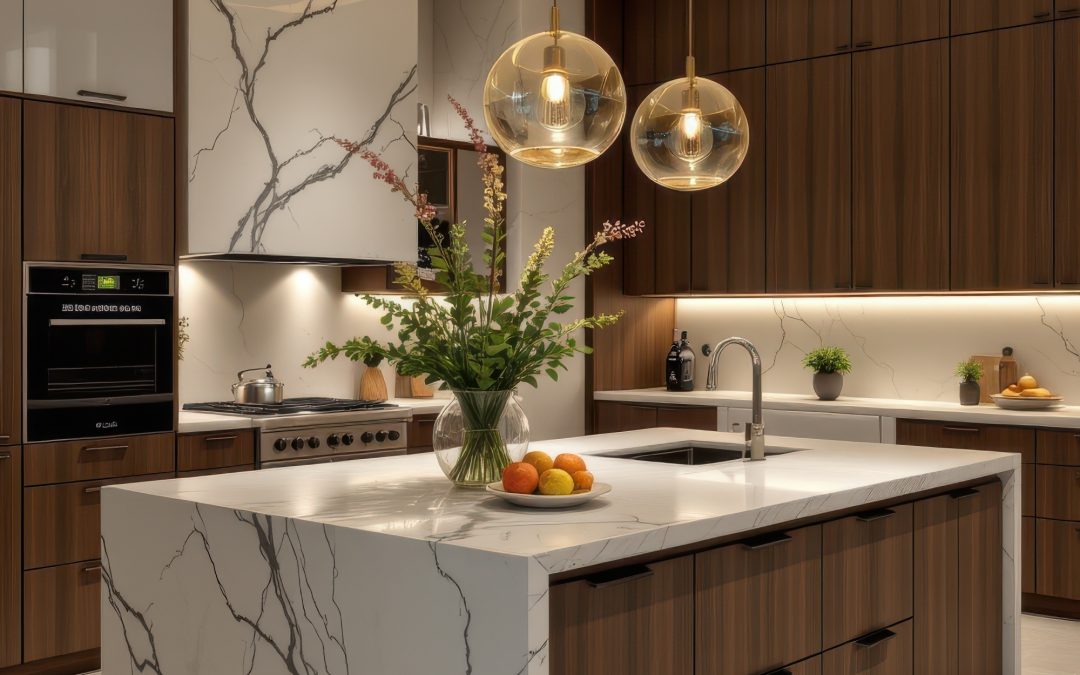
by Kesaa Interiors | Kitchen, ROOMS
The kitchen island has evolved into something truly spectacular in today’s homes. Modern kitchen island bench designs now deliver the perfect combination of style and practicality that transforms how we use our kitchens. As open-concept living continues to dominate home design, these versatile workspaces have become the defining feature of many kitchens—the place where everything happens.
What makes modern kitchen island bench designs so valuable is their ability to multitask. They’re prep stations for cooking, dining spots for casual meals, storage solutions for kitchen essentials, and social hubs for entertaining. The best designs strike the ideal balance between visual appeal and functional design.
In this guide, I’ll walk you through 25 distinctive modern kitchen island bench designs that successfully merge style with purpose. Whether you’re planning a complete kitchen renovation or simply seeking fresh ideas, these carefully selected designs showcase the innovation possible in today’s kitchens.
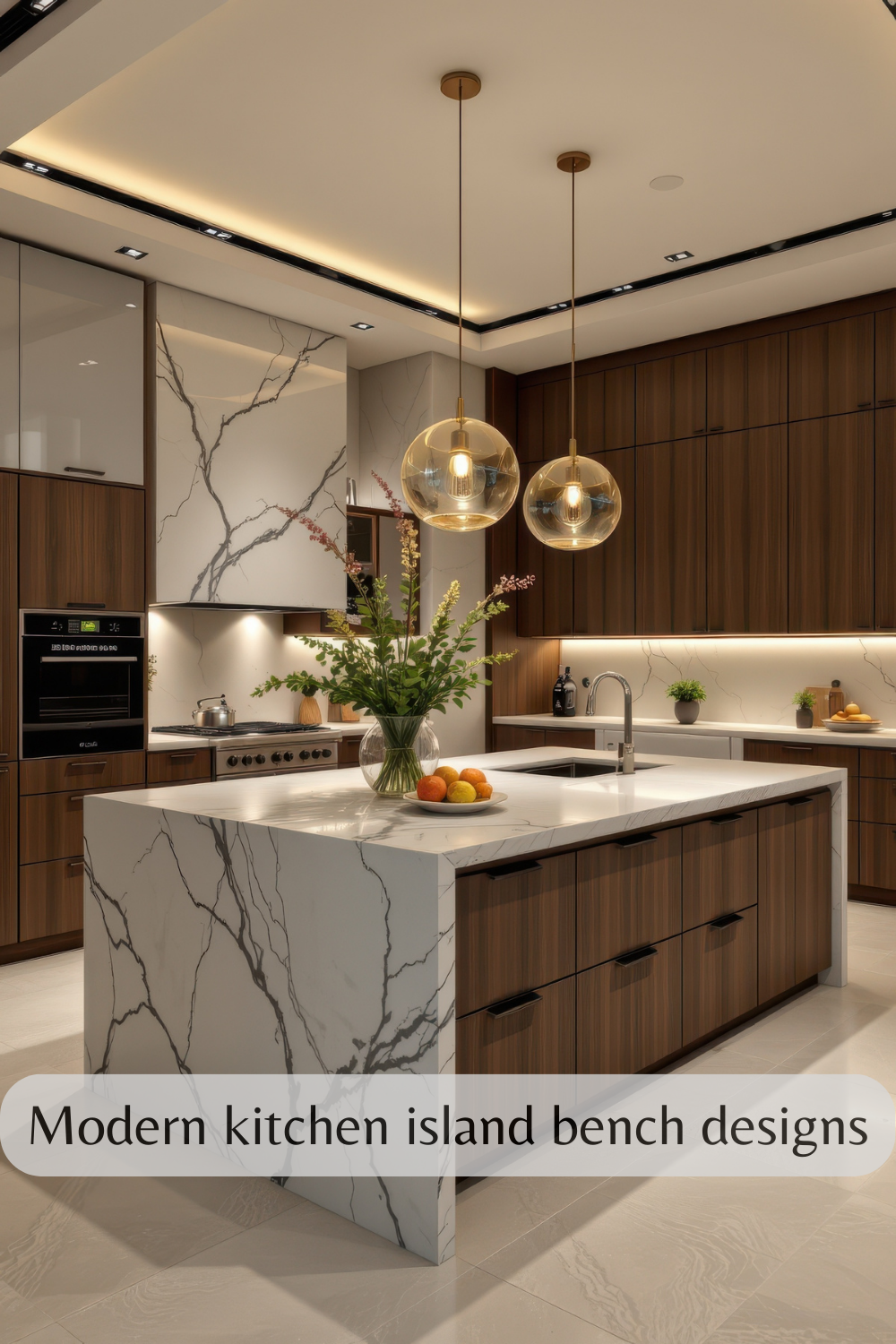
1. Minimalist Modern Kitchen Island Bench Designs
Design 1: Sleek Waterfall Edge Island
Waterfall edges have become one of the most sought-after features in modern kitchen island bench designs. This elegant approach features countertop material that flows seamlessly down the sides of the island, creating a dramatic visual effect that highlights quality materials and clean lines.
- Materials like quartz, marble, and concrete work beautifully for this application
- The continuous surface creates a sculptural, high-end appearance
- White, light grey, and matte black finishes enhance the minimalist aesthetic
- Veined materials add visual interest while maintaining the clean design
Beyond aesthetics, waterfall edges offer practical benefits too—they protect cabinetry and provide a smooth surface that’s easy to clean, which is particularly valuable in busy kitchen areas.
Pro Tip: When planning waterfall edges in modern kitchen island bench designs, pay attention to pattern matching at corners. That perfect alignment makes all the difference in achieving a truly seamless look.
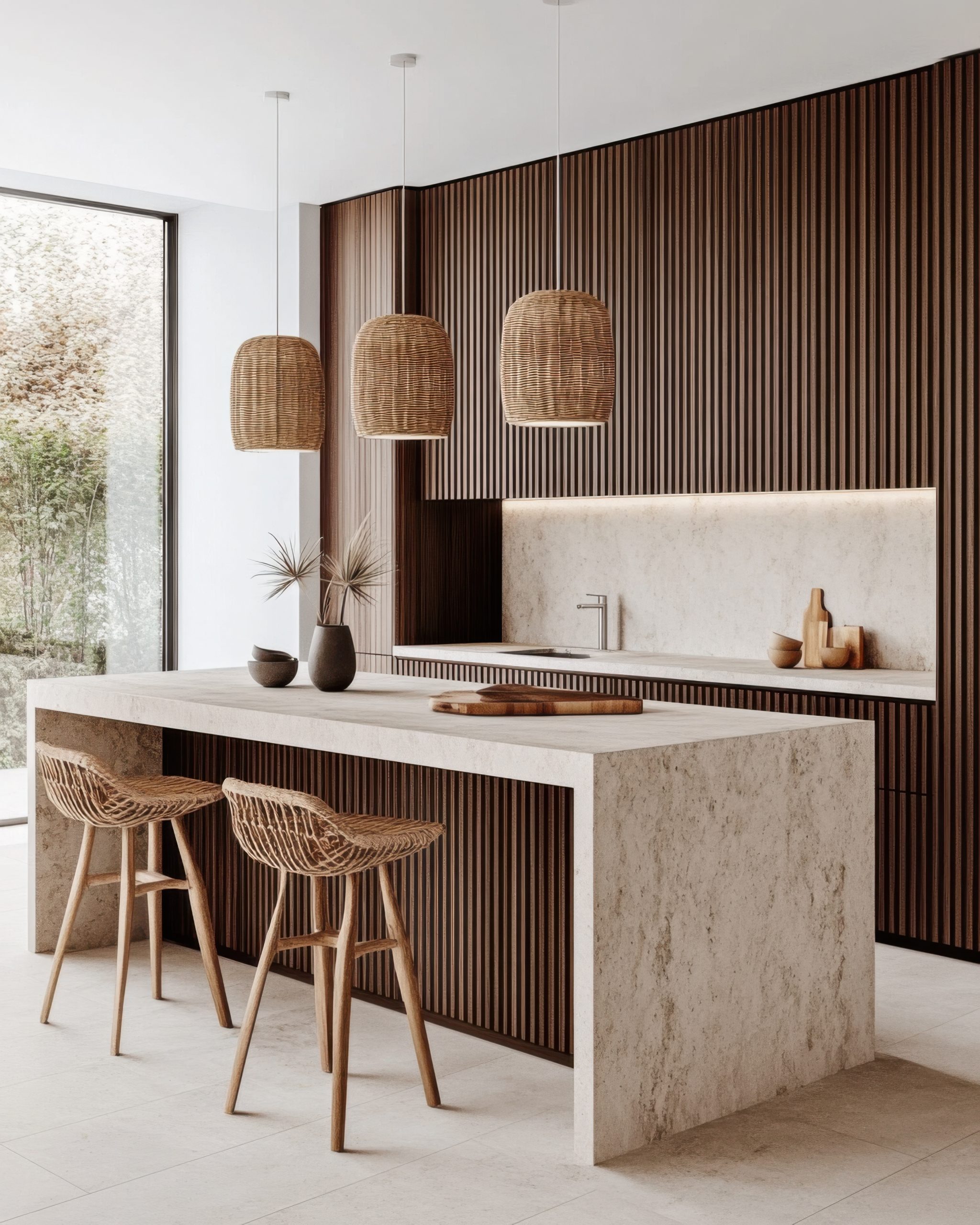
Design 2: Floating Island Bench
Creating a sense of lightness and space, floating island benches seem to defy gravity while maintaining full functionality. These modern kitchen island bench designs use clever structural supports to minimise visual bulk, making them perfect for smaller kitchens or spaces where you want an airy feel.
The floating effect can be achieved through:
- Recessed base cabinets that create shadow lines
- Cantilevered countertop extensions
- Strategic lighting underneath the island
- Support structures concealed within a central cabinet block
The space beneath partially floating islands improves foot clearance for barstool seating and creates a more spacious feel throughout the kitchen. This approach works wonderfully in contemporary spaces where clean lines are key to the design.

Design 3: Monochromatic Block Island
Bold and impressive, monochromatic block islands make powerful statements in modern kitchens. These substantial modern kitchen island bench designs use a single colour throughout—from cabinetry to countertops—creating a unified volume that anchors the kitchen space.
- Dark tones like charcoal, navy, or forest green create dramatic focal points
- All-white designs deliver crisp, clean aesthetics
- Matte finishes reduce visual distraction and enhance the monolithic appearance
- Consistent materials strengthen the overall impact
The key to successful monochromatic islands is subtle textural variation—using the same colour across different materials creates depth without breaking the colour cohesion. It’s a look that’s both sophisticated and eye-catching.
Pro Tip: With monochromatic modern kitchen island bench designs, consider minimal hardware or push-to-open mechanisms to maintain those clean, uninterrupted lines.

Design 4: Hidden Storage Minimalist Island
Minimalism doesn’t mean sacrificing functionality—it’s about concealing it thoughtfully. These sleek modern kitchen island bench designs maintain clean external lines while housing extensive storage solutions inside.
Key features include:
- Handle-free cabinet fronts with push-latch mechanisms
- Continuous panels that conceal individual drawers
- Clever internal organisers that maximise space efficiency
- Seamlessly integrated appliances behind matching panels
What makes these islands particularly successful is how they balance visual simplicity with practical kitchen needs. For busy households, this combination of aesthetics and utility proves especially valuable.
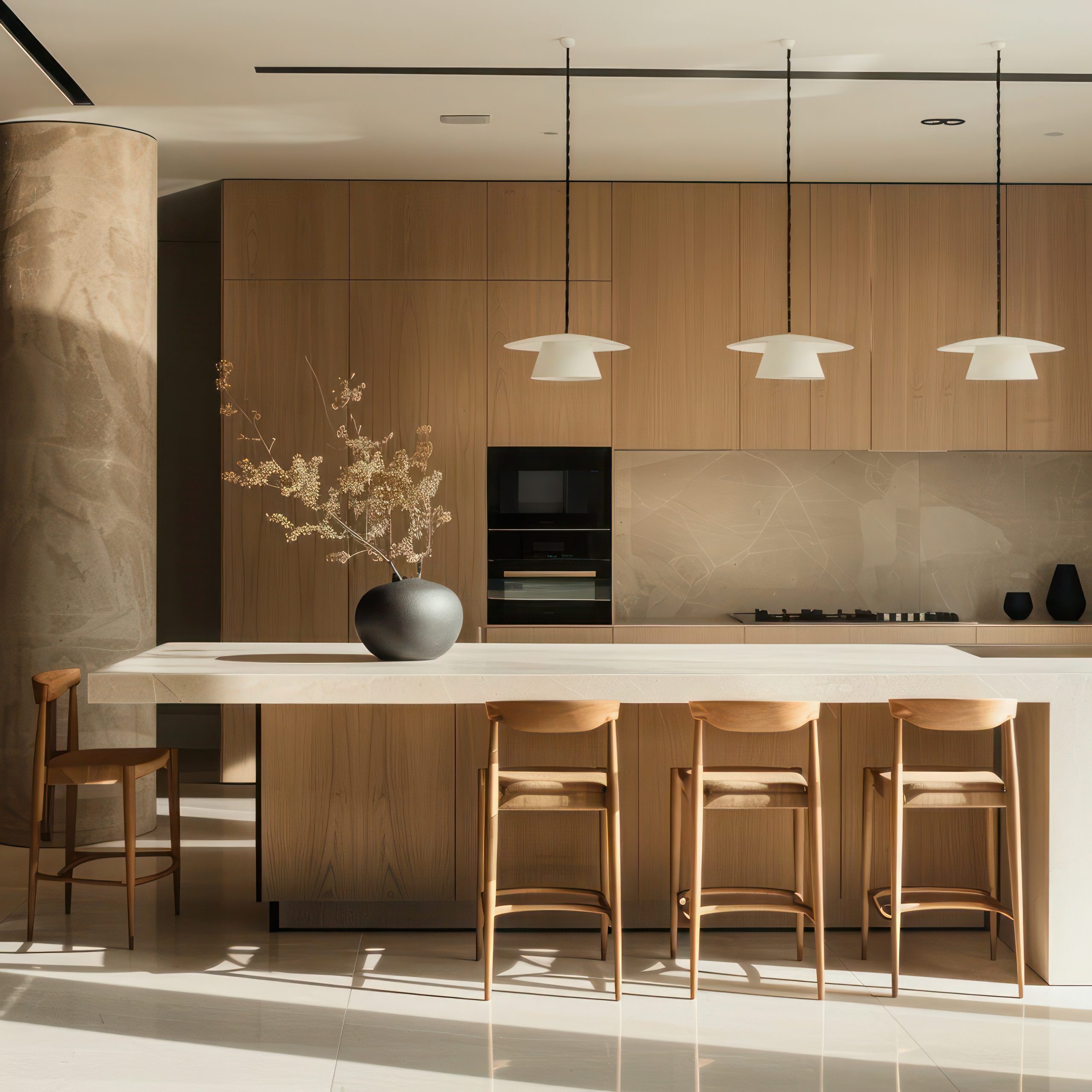
Design 5: Thin-Profile Cantilevered Island
For spaces where visual lightness is important, thin-profile cantilevered islands offer an elegant solution. These modern kitchen island bench designs feature ultra-slim countertops (often just 12-20mm thick) that extend beyond their supporting structure, creating a sophisticated floating appearance.
Material selection is crucial for these designs:
- Engineered quartz and porcelain provide strength at minimal thickness
- Steel reinforcement helps support extended cantilevers
- Edge detailing should emphasise the thinness of the material
- The cabinet base requires careful engineering to support the overhang
The result is an island that appears almost weightless while providing all the functionality you need—a perfect example of how modern kitchen island bench designs can move beyond traditional kitchen conventions.

2. Multi-Functional Modern Kitchen Island Bench Designs
Design 6: Island with Integrated Dining Table
Bridging kitchen and dining functions, islands with integrated tables are among the most practical modern kitchen island bench designs for today’s lifestyles. These versatile pieces acknowledge how social our kitchens have become while making efficient use of available space.
Integration can take several forms:
- Extended countertops at standard table height (30″)
- Connected but distinct surfaces at different heights
- Pull-out or flip-up table sections for flexibility
- Material transitions that visually separate the prep and dining zones
The key to success with these designs is clearly defining the different functional areas while maintaining overall design cohesion. For instance, a stone prep surface might transition to wood for the dining area, signalling different uses while preserving design harmony.
Pro Tip: When planning dining features in modern kitchen island bench designs, allow at least 24″ of knee space depth and approximately 24-30″ width per person for comfortable seating.
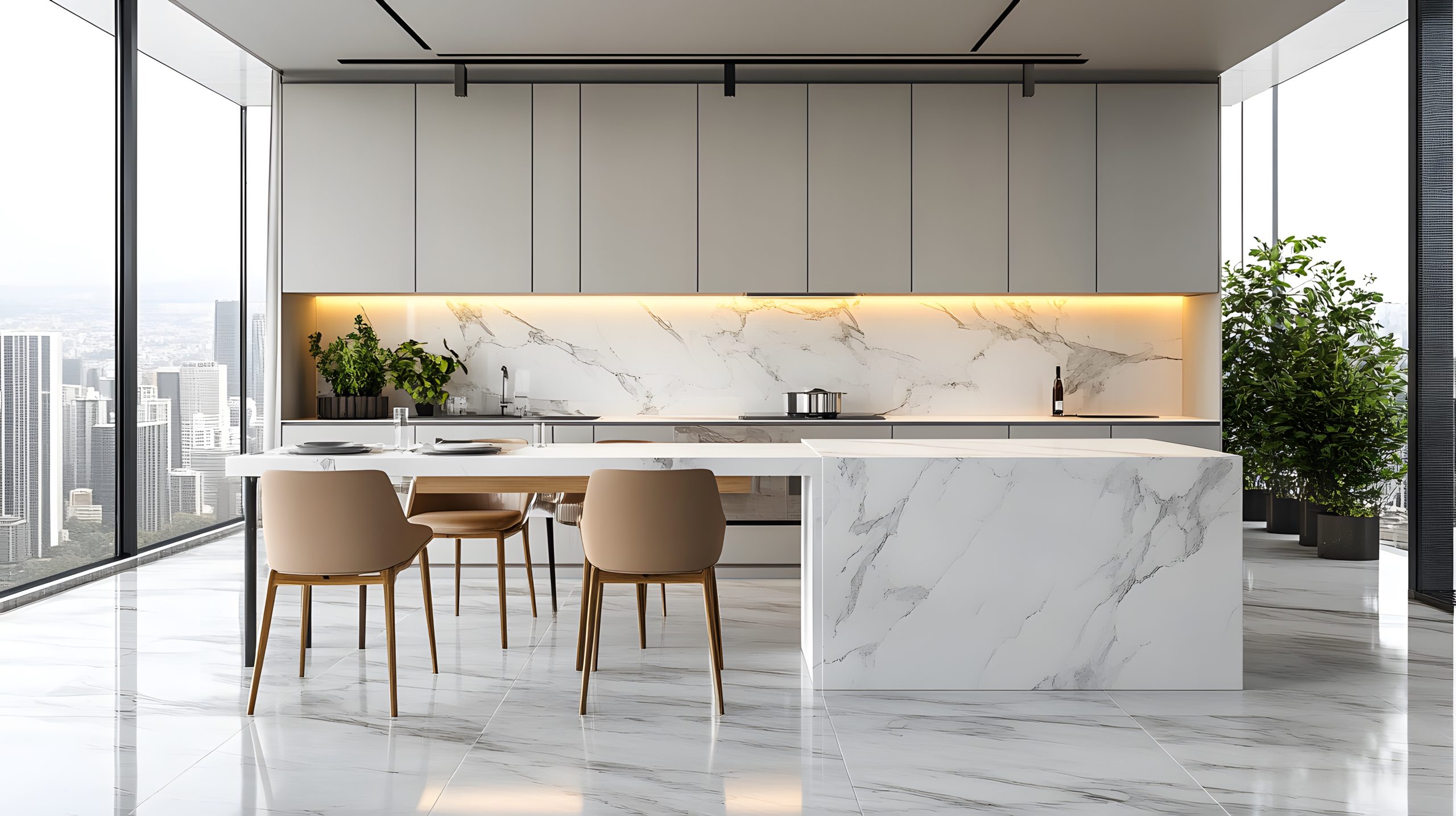
Design 7: Workstation Island with Prep Sinks
For serious cooking enthusiasts, workstation islands bring professional-grade functionality to home kitchens. These modern kitchen island bench designs incorporate specialised features centred around a well-positioned prep sink with dedicated zones for different kitchen tasks.
Essential elements include:
- Secondary sink with accessories like cutting boards and colanders
- Designated areas for chopping, cleaning, and assembly
- Convenient knife storage near prep areas
- Easily accessible waste disposal
The arrangement should follow natural workflow patterns, with waste disposal near cleaning areas and prep surfaces adjacent to cooking zones. This thoughtful organisation makes cooking more efficient and enjoyable in busy kitchens.

Design 8: Cooking-Focused Island with Integrated Cooktop
Moving your cooking surface to the island creates a more social cooking experience and dramatically changes kitchen workflow. These modern kitchen island bench designs centre around an integrated cooktop, transforming the island into the primary cooking zone.
Key considerations for cooking islands include:
- Proper ventilation through overhead or downdraft systems
- Heat-resistant countertop materials around the cooking surface
- Convenient access to cooking utensils and ingredients
- Safe clearance zones around hot cooking areas
When designed thoughtfully, cooking islands allow the chef to face guests while preparing meals rather than turning their back to the room. This social-facing orientation makes cooking more interactive and enjoyable, especially when entertaining.
Pro Tip: For these modern kitchen island bench designs, consider a slightly deeper countertop (36-42″ vs. standard 24″) to create safe buffer zones around the cooking surface.
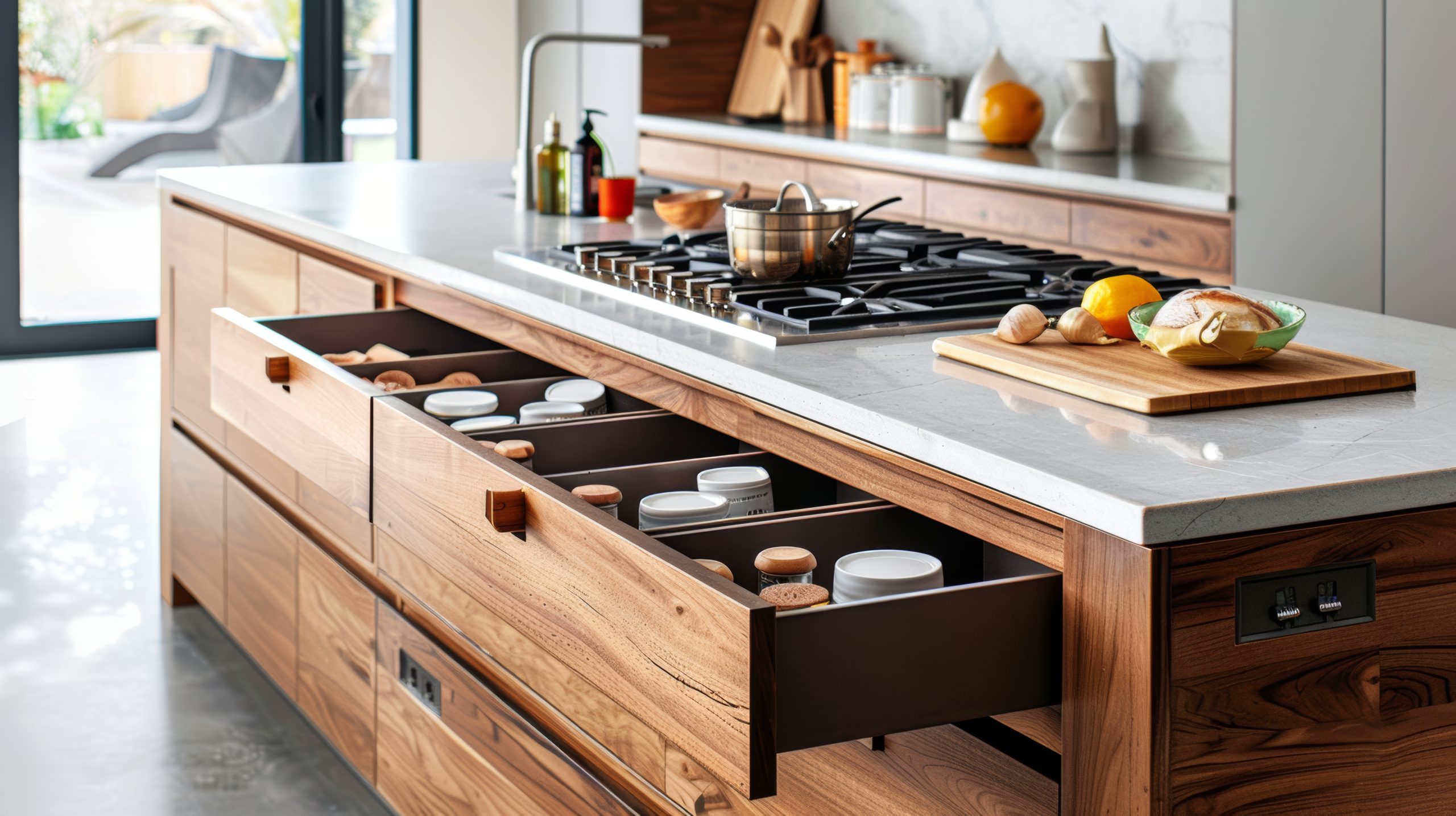
Design 9: Breakfast Bar Island with Appliance Garage
Morning routines become more efficient with breakfast bar islands that incorporate dedicated zones for morning essentials. These modern kitchen island bench designs feature comfortable seating paired with smart storage for small appliances and breakfast items.
Effective breakfast bar islands include:
- Comfortable counter-height or bar-height seating
- Appliance garages with roll-up doors for coffee makers and toasters
- Dedicated drawers for breakfast essentials like utensils and napkins
- Easily accessible outlets for powering appliances
The appliance garage component is particularly valuable as it allows quick access to frequently used items without permanently sacrificing counter space. When breakfast is finished, simply close the garage door for a clean, uncluttered look.
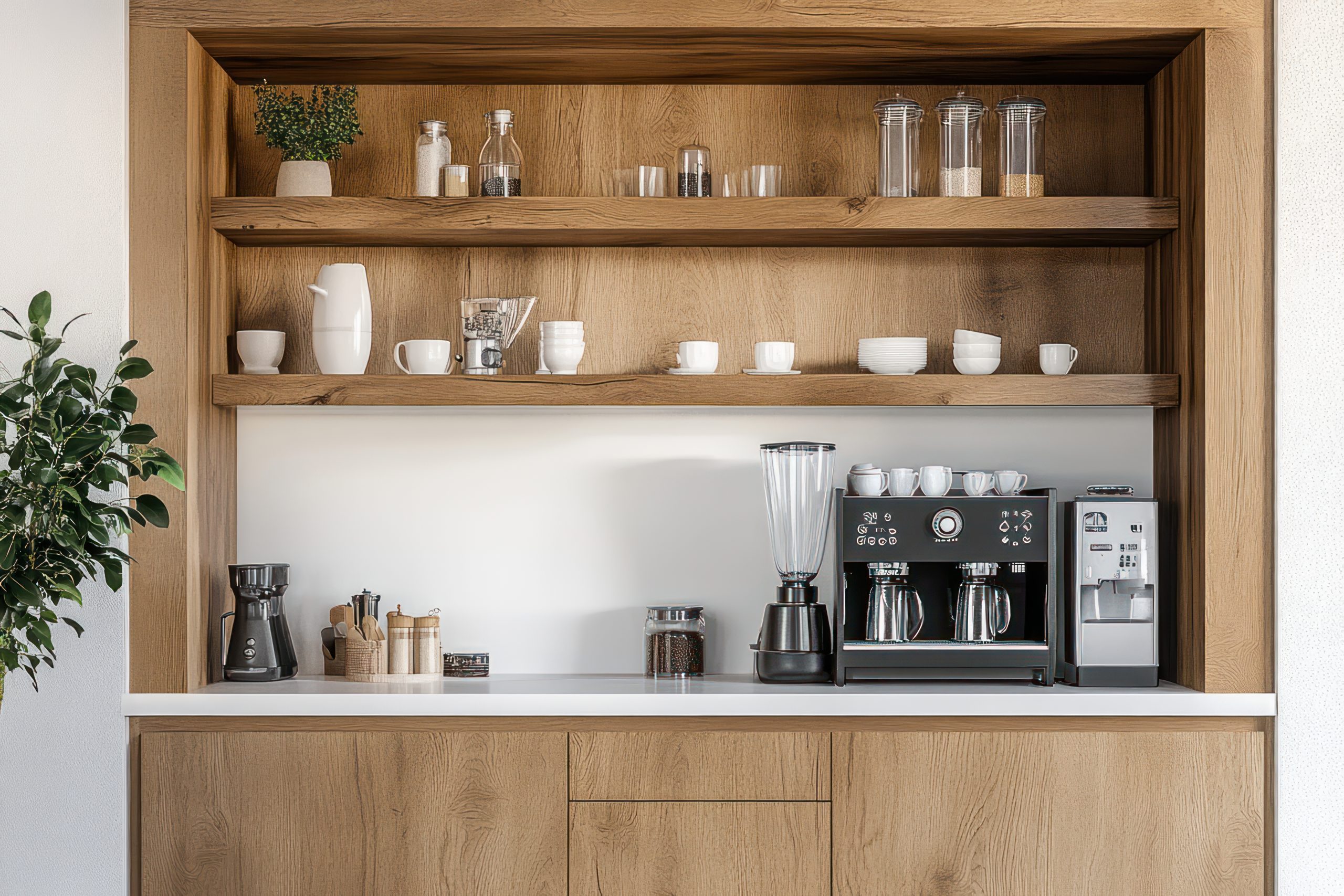
Design 10: Multi-Level Work and Entertainment Island
Adding height variation to your island creates visual interest while clearly defining different functional zones. These dynamic modern kitchen island bench designs feature two or more distinct levels that serve specific purposes.
Common configurations include:
- Standard 36″ counter height for food prep areas
- Raised 42″ bar height for casual dining and guest seating
- Lowered 30″ table height sections for comfortable dining
- Small elevated platforms to separate sink areas from food prep zones
The level changes not only differentiate functional areas but also add architectural interest to the kitchen. They can also provide practical benefits like splash protection between wet and dry zones.
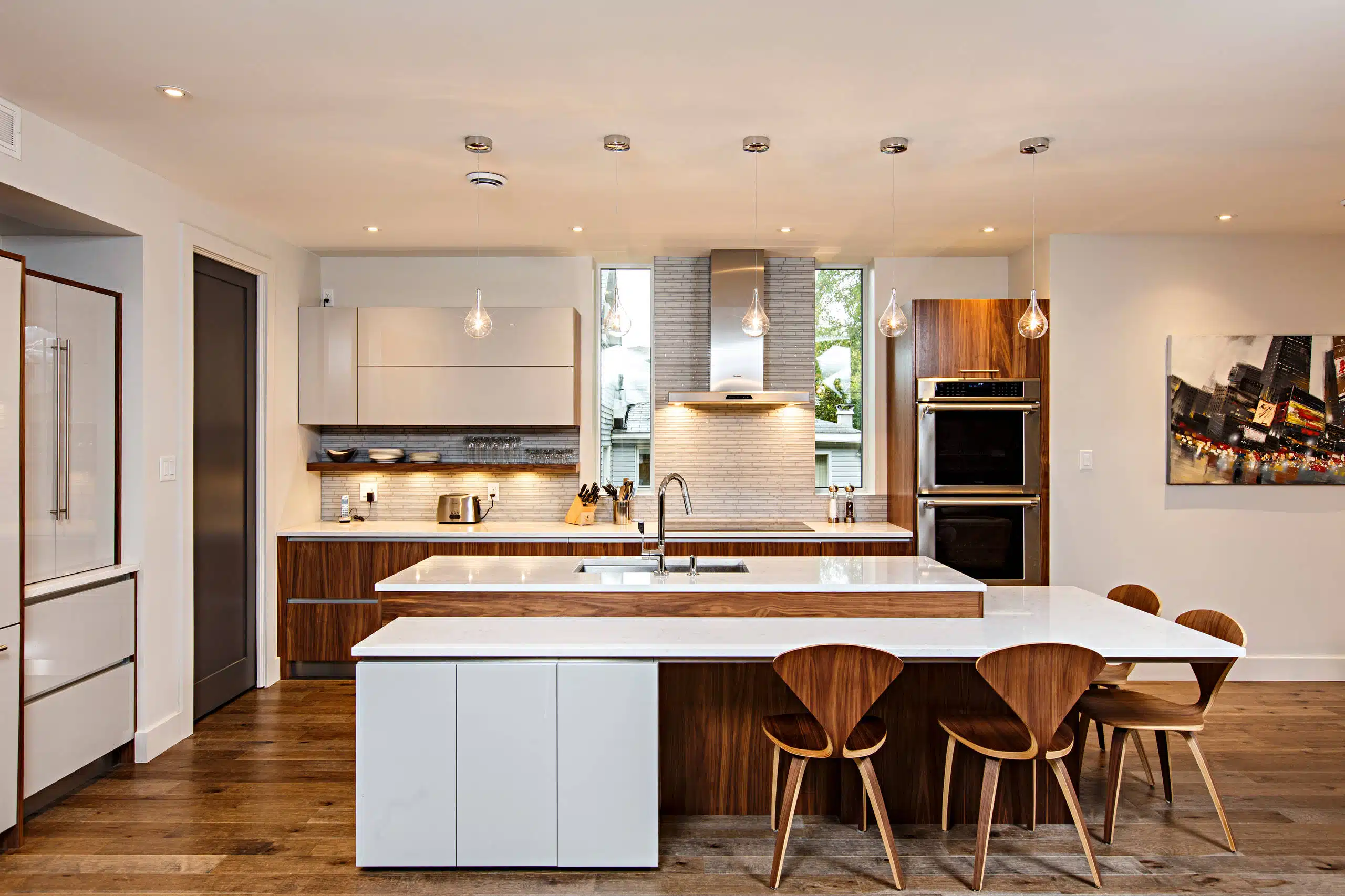
3. Material-Forward Modern Kitchen Island Bench Designs
Design 11: Mixed Material Island (Wood and Stone)
Combining contrasting materials creates islands with depth, character, and visual warmth. These modern kitchen island bench designs typically pair the practicality of stone work surfaces with the warmth and tactile quality of wood elements.
Successful material combinations include:
- Marble or quartz tops with wood waterfall edges or bases
- Wooden butcher block sections integrated into stone countertops
- Stone surrounds with wooden breakfast bar extensions
- Dark stone with light wood or vice versa for dramatic contrast
The material transition points become design features in themselves, highlighting the intentional nature of the combination. These transitions often align with functional changes—wood for seating areas, stone for prep zones.
Pro Tip: When combining materials in modern kitchen island bench designs, keep other kitchen elements simpler to let the island be the focal point of material interest.
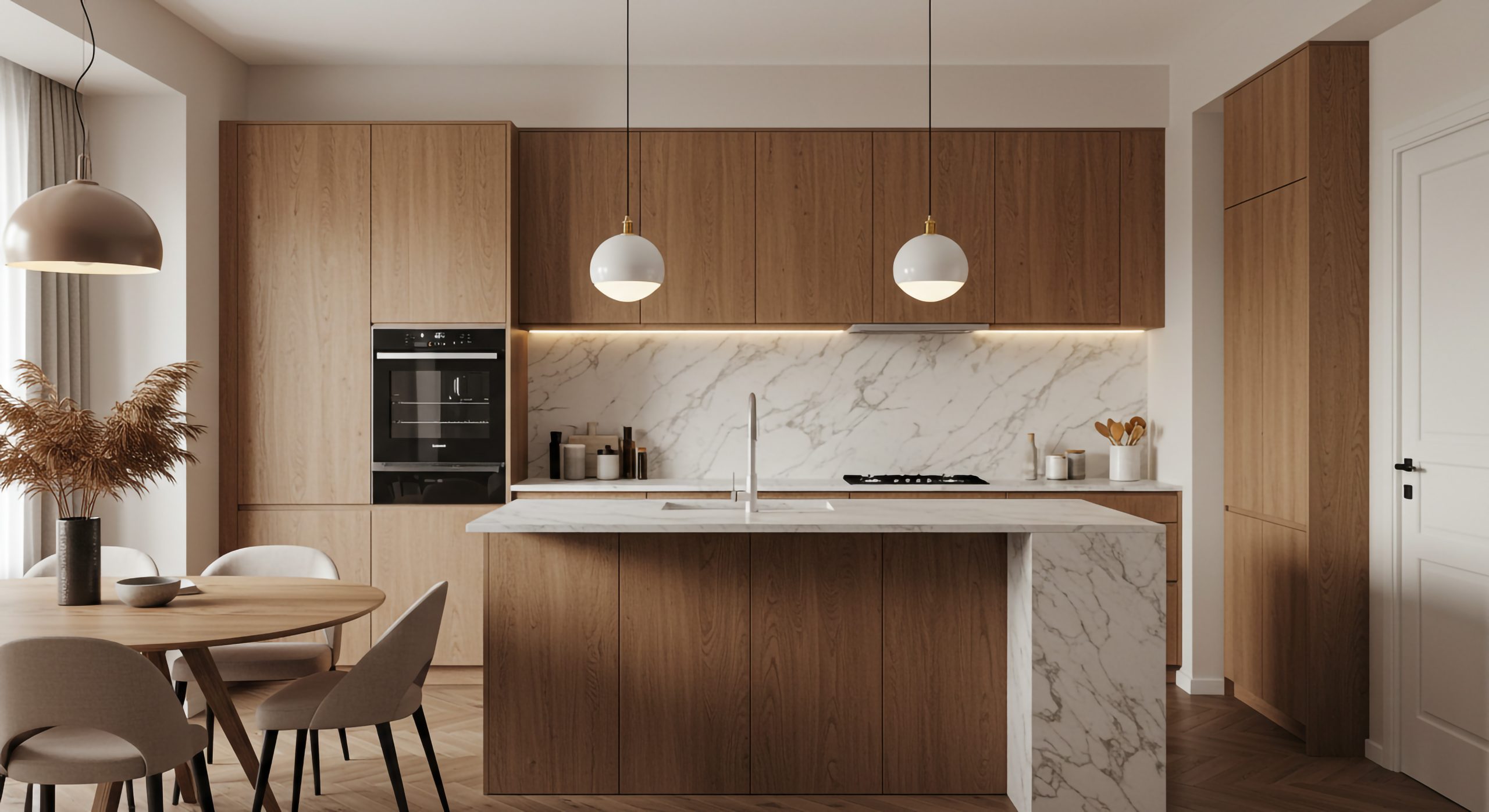
Design 12: Concrete Statement Island
Industrial chic meets modern sophistication with concrete islands. These modern kitchen island bench designs leverage concrete’s versatility and unique aesthetic to create distinctive, personalised spaces.
The appeal of concrete islands comes from:
- Ability to be cast in any shape or size for custom configurations
- Options for integrated features like drainboards or trivets
- A variety of finishes, from polished to matte to textured
- Unique patina that develops character over time
Modern concrete mixes have overcome many of the material’s traditional limitations, offering improved stain resistance and reduced porosity. The result is a surface that combines industrial character with practical functionality.

Design 13: Marble Luxury Island
Nothing says luxury quite like marble, and as the centrepiece of modern kitchen island bench designs, it makes a powerful statement. With its natural veining and luminous quality, marble creates islands of unparalleled elegance.
Key considerations for marble islands include:
- Selecting the right variety—from subtle Carrara to dramatic Calacatta
- Book-matching veining for high-impact visual continuity
- Edge profile options that highlight the stone’s thickness
- Proper sealing to protect against stains and etching
While marble requires more maintenance than some alternatives, many homeowners find its timeless beauty worth the extra care. For those concerned about maintenance, marble-look quartz and porcelain offer similar aesthetics with greater durability.
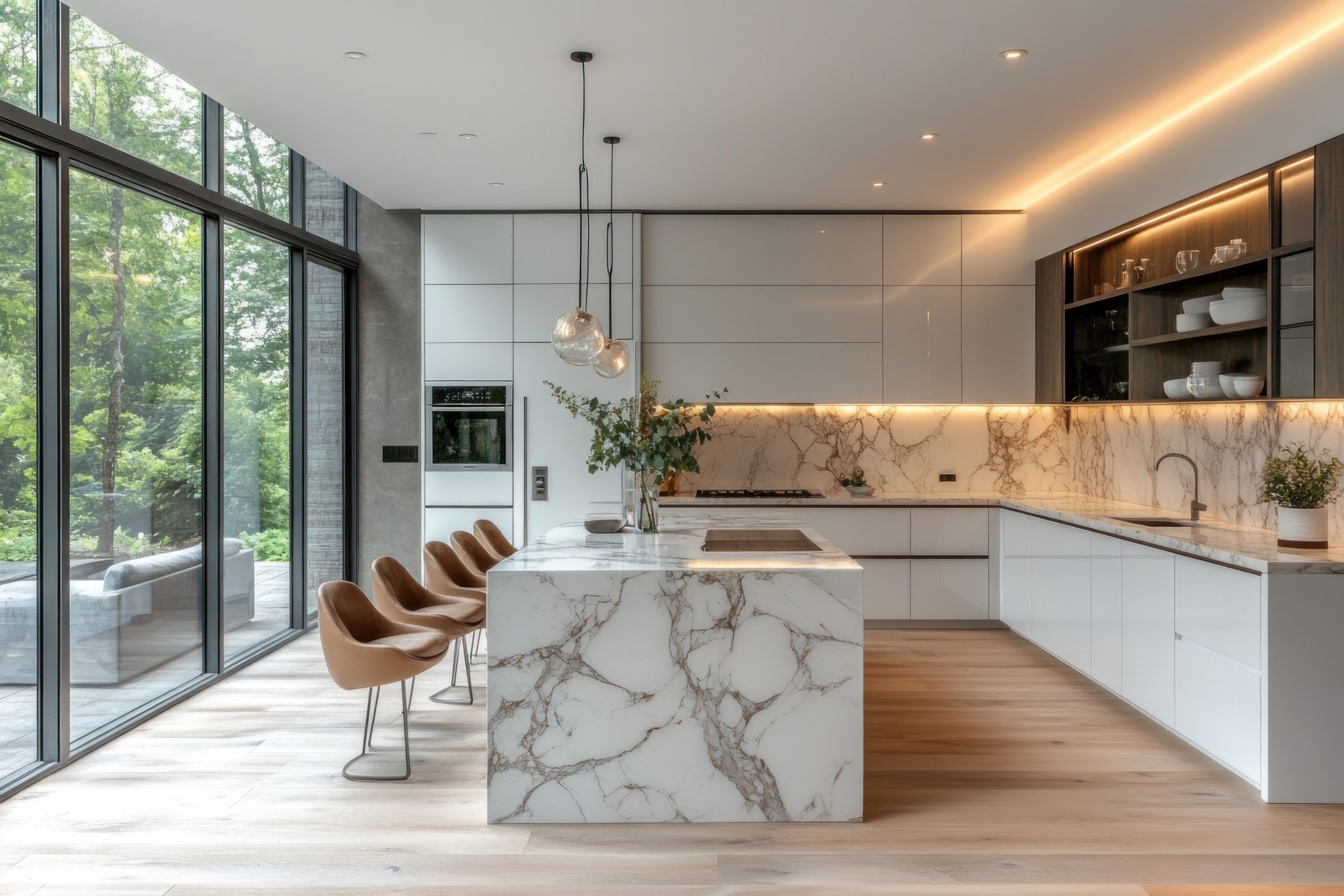
Design 14: Metal-Accented Island
Incorporating metal elements adds sophistication and visual interest to modern kitchen island bench designs. Whether it’s a full metal base or thoughtful accents, metallic elements bring a refined, current aesthetic to the kitchen.
Popular metal applications include:
- Brass or copper banding around the edges or bases
- Stainless steel or blackened steel structural supports
- Metal mesh or perforated panel inserts
- Metallic tile facings on island sides
The reflective quality of metals adds dimension to the kitchen space, catching and playing with light in ways that other materials don’t. This luminosity creates visual movement that enlivens the entire kitchen.
Pro Tip: With metal elements in modern kitchen island bench designs, consider how the finish will evolve over time. While some metals develop a patina, others maintain their original appearance with proper care.
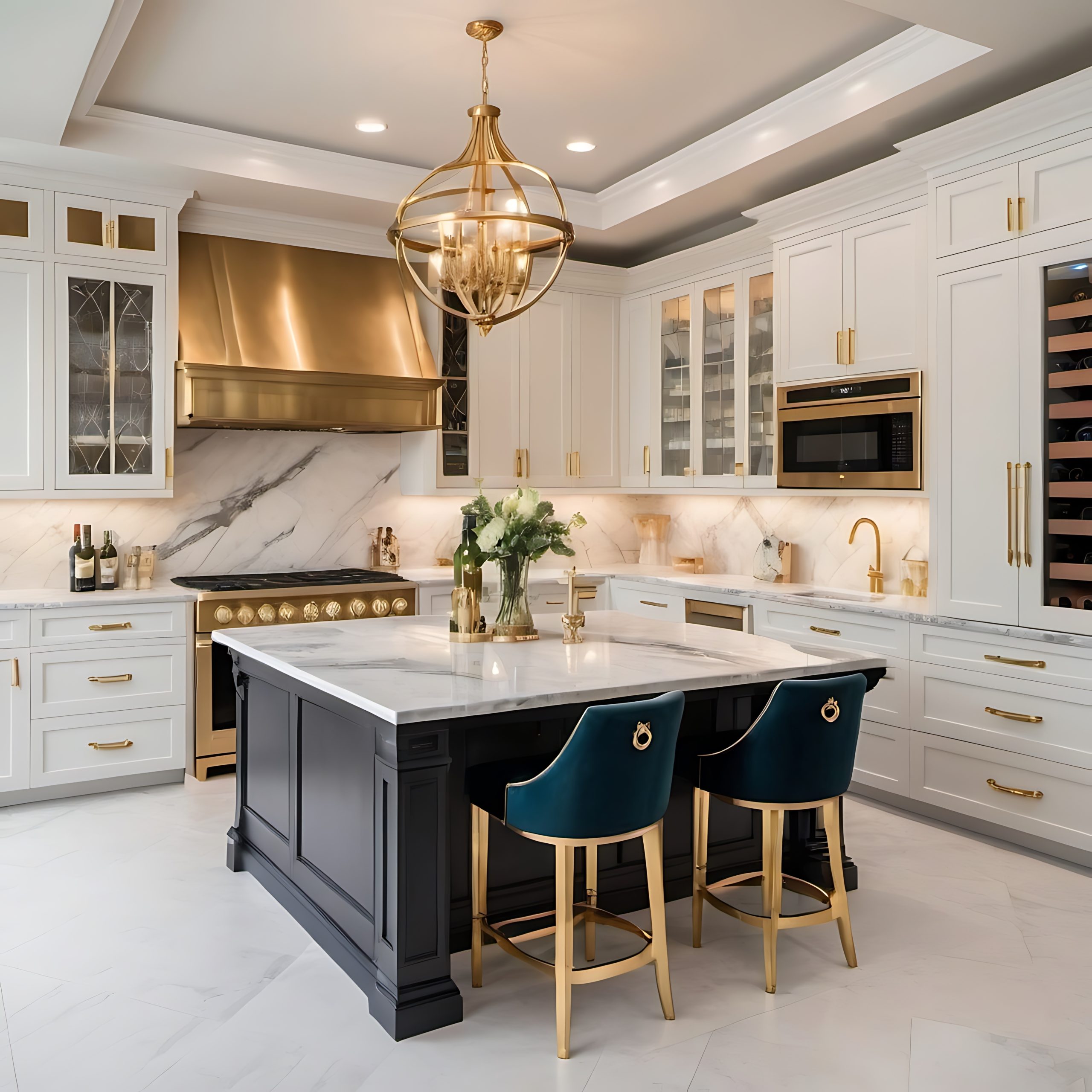
Design 15: Glass and Illuminated Islands
Creating drama through light and transparency, glass elements transform modern kitchen island bench designs into stunning focal points. These islands incorporate illuminated components and translucent materials for eye-catching effects.
Innovative approaches include:
- Backlit onyx or translucent stone panels
- LED-illuminated glass shelving or dividers
- Frosted glass cabinet fronts with internal lighting
- Light wells within the island structure
These illuminated features can be purely decorative or surprisingly functional—lighting up work areas, creating ambient mood lighting, or making cabinet contents more visible. The effect is particularly striking in evening hours when other lighting is dimmed.
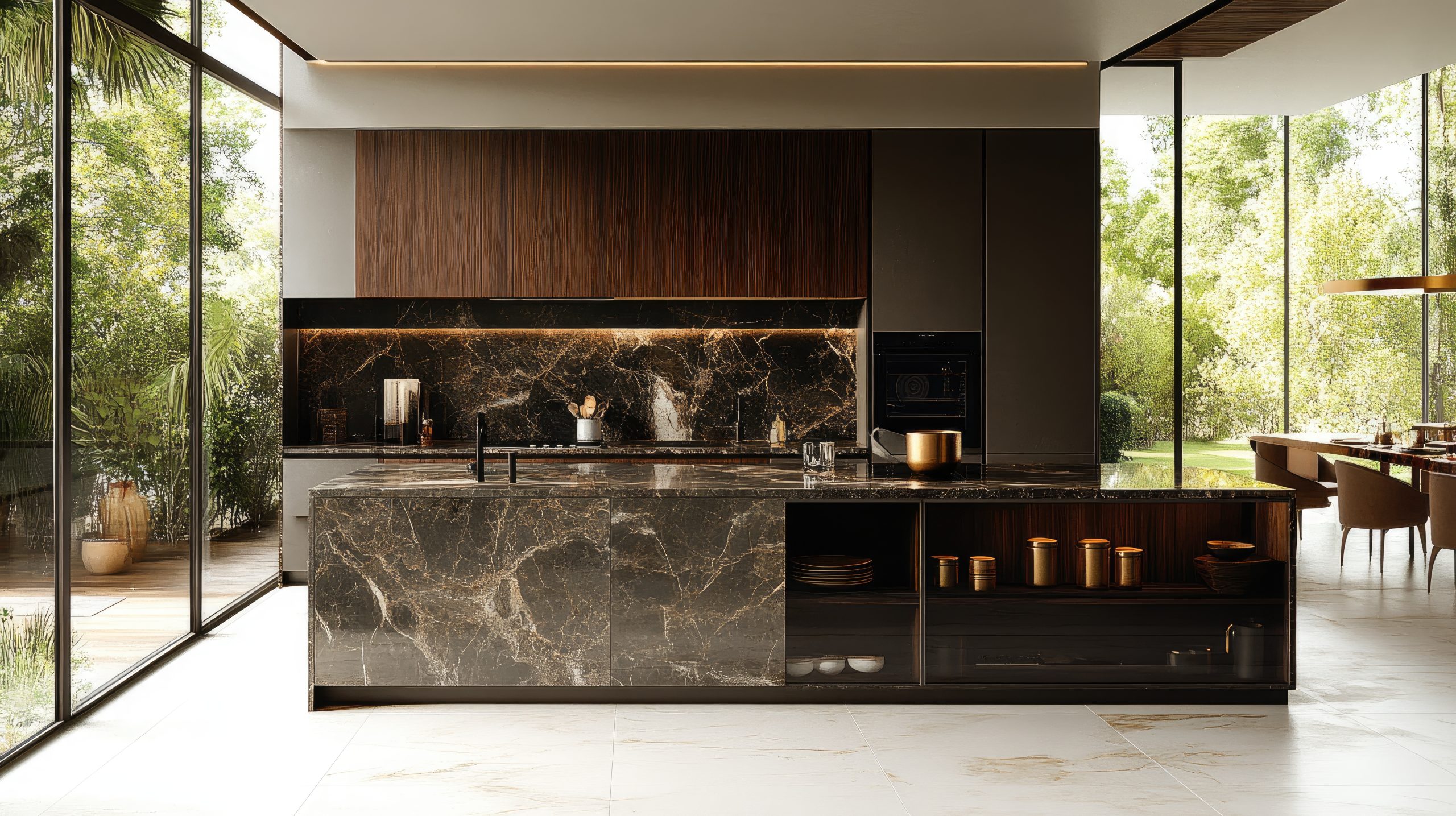
4. Space-Optimising Modern Kitchen Island Bench Designs
Design 16: Mobile Kitchen Island Bench
Flexibility is the hallmark of mobile islands, which adapt to changing needs through portability. These modern kitchen island bench designs feature quality casters that allow the island to be repositioned as needed.
Key features of effective mobile islands include:
- Heavy-duty locking casters that prevent unwanted movement
- Lightweight yet sturdy construction materials
- Multi-purpose work surfaces that are suited to various tasks
- Compact footprints that navigate through doorways and around furniture
For homes where space is at a premium or needs change frequently, these adaptable islands provide valuable workspace without permanent commitment to a single layout.
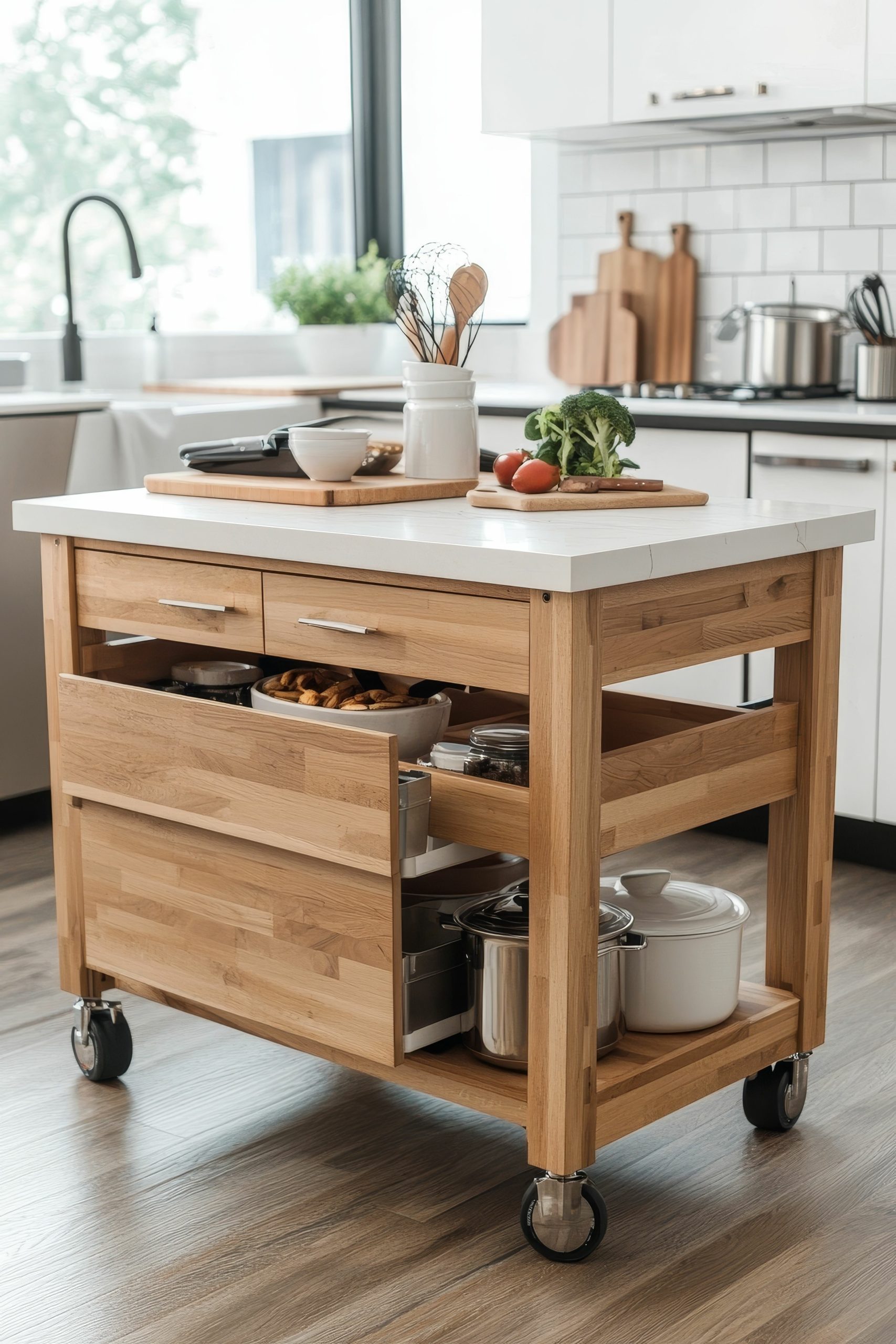
Design 17: Expandable/Collapsible Island
Adaptability reaches new heights with expandable islands that transform based on your needs. These innovative modern kitchen island bench designs feature extendable sections that can be deployed when needed and tucked away when not in use.
Expansion mechanisms include:
- Pull-out work surfaces that extend from the main structure
- Fold-down tabletops that provide additional dining space
- Nesting components that slide out for more workspace
- Modular sections that can be reconfigured as needed
The genius of these designs lies in their ability to serve multiple purposes throughout the day—compact during regular use, expanded for entertaining or special projects. This versatility makes them ideal for smaller homes where space must work harder.
Pro Tip: When considering expandable modern kitchen island bench designs, pay special attention to the quality of the extension mechanisms—they should operate smoothly and lock securely in both positions.
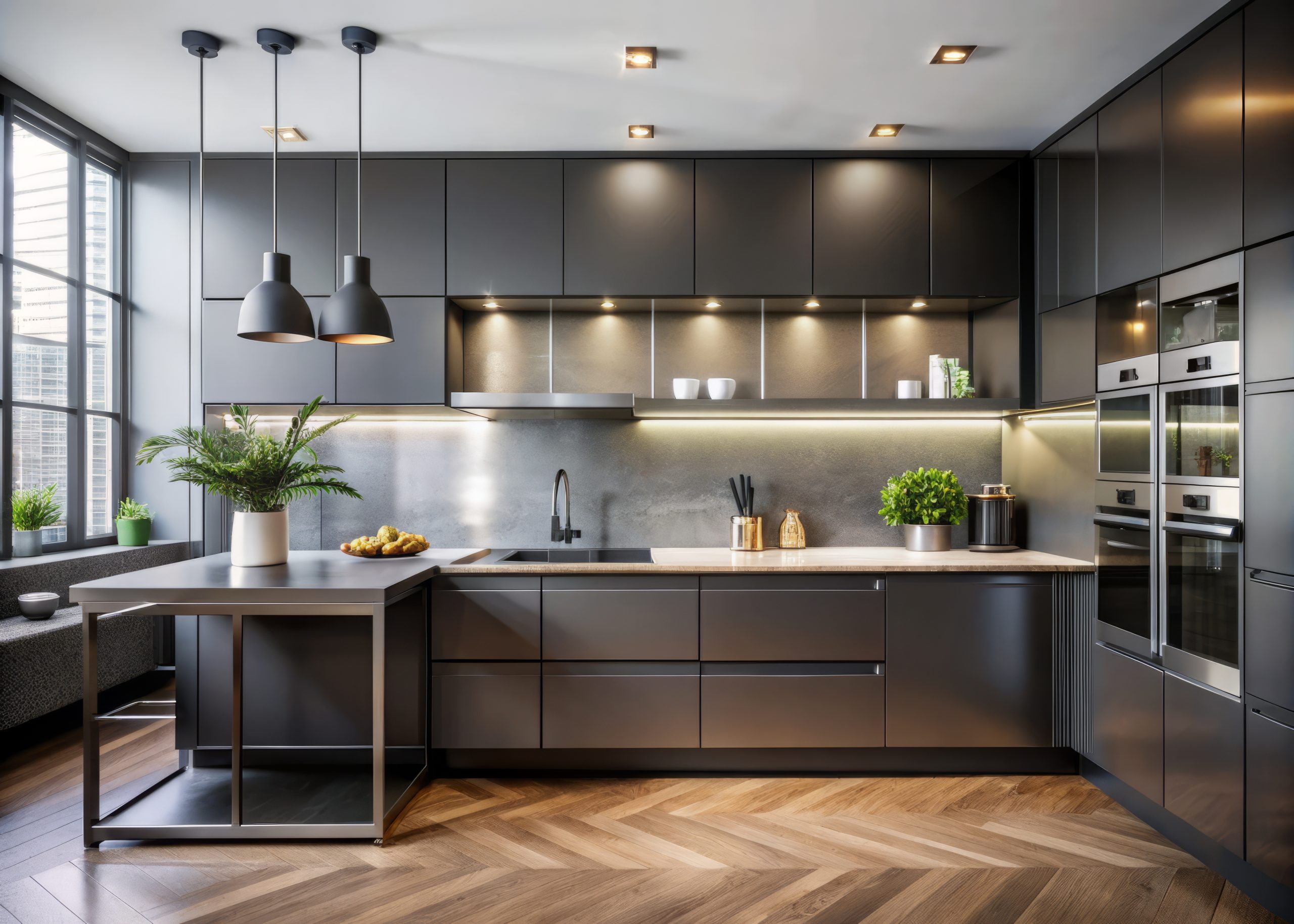
Design 18: Corner-Fitting Island Designs
Making the most of challenging kitchen layouts, corner islands turn awkward spaces into functional assets. These specialised modern kitchen island bench designs are shaped to fit into L-configured kitchens, maximising previously underutilised corner areas.
Effective corner islands feature:
- Angled or curved designs that follow architectural lines
- Traffic flow patterns that work with the natural movement through the space
- Strategic storage that utilises the deeper corner sections
- Work surfaces positioned for optimal accessibility
By conforming to the kitchen’s architecture rather than fighting against it, these islands create more usable space while maintaining good traffic flow—a win-win for functionality and design.

Design 19: Narrow Galley Kitchen Islands
Long and slim, these modern kitchen island bench designs are tailored specifically for galley and corridor kitchens where width is limited but length is available. They provide valuable workspace without compromising necessary walkways.
Design considerations include:
- Maintaining a minimum 36″ clearance on all sides for safe passage
- Emphasising length rather than width (typically 18-24″ wide)
- Incorporating slim storage solutions like bottle pulls and narrow drawers
- Linear design elements that enhance the sense of flow
These islands often become the organising spine of the kitchen, with work zones arranged along their length in a logical sequence that supports efficient cooking workflows.
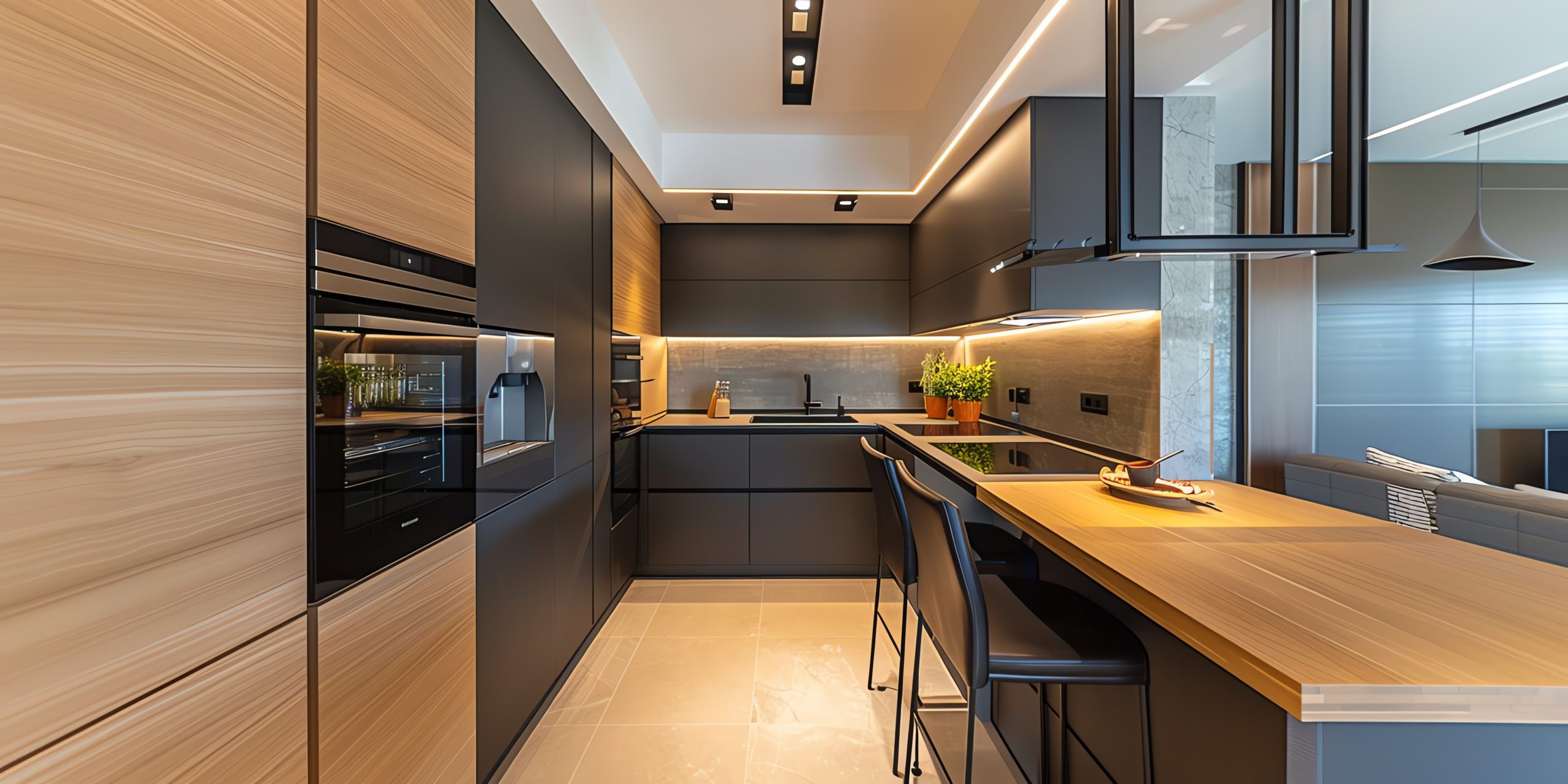
Design 20: Multi-Function Peninsula Alternative
Blurring the line between island and peninsula, these hybrid modern kitchen island bench designs connect to the kitchen perimeter at one end while maintaining the accessible character of an island. They’re ideal for kitchens where a full island won’t fit, but additional workspace is needed.
Key benefits include:
- Reduced clearance requirements (only three sides need access)
- Added stability through the wall connection
- Potential for additional upper storage or display at the connected end
- Efficient use of space in smaller kitchens
This approach provides many of the advantages of both peninsulas (stability, storage potential) and islands (accessibility, social orientation) in a single design solution.
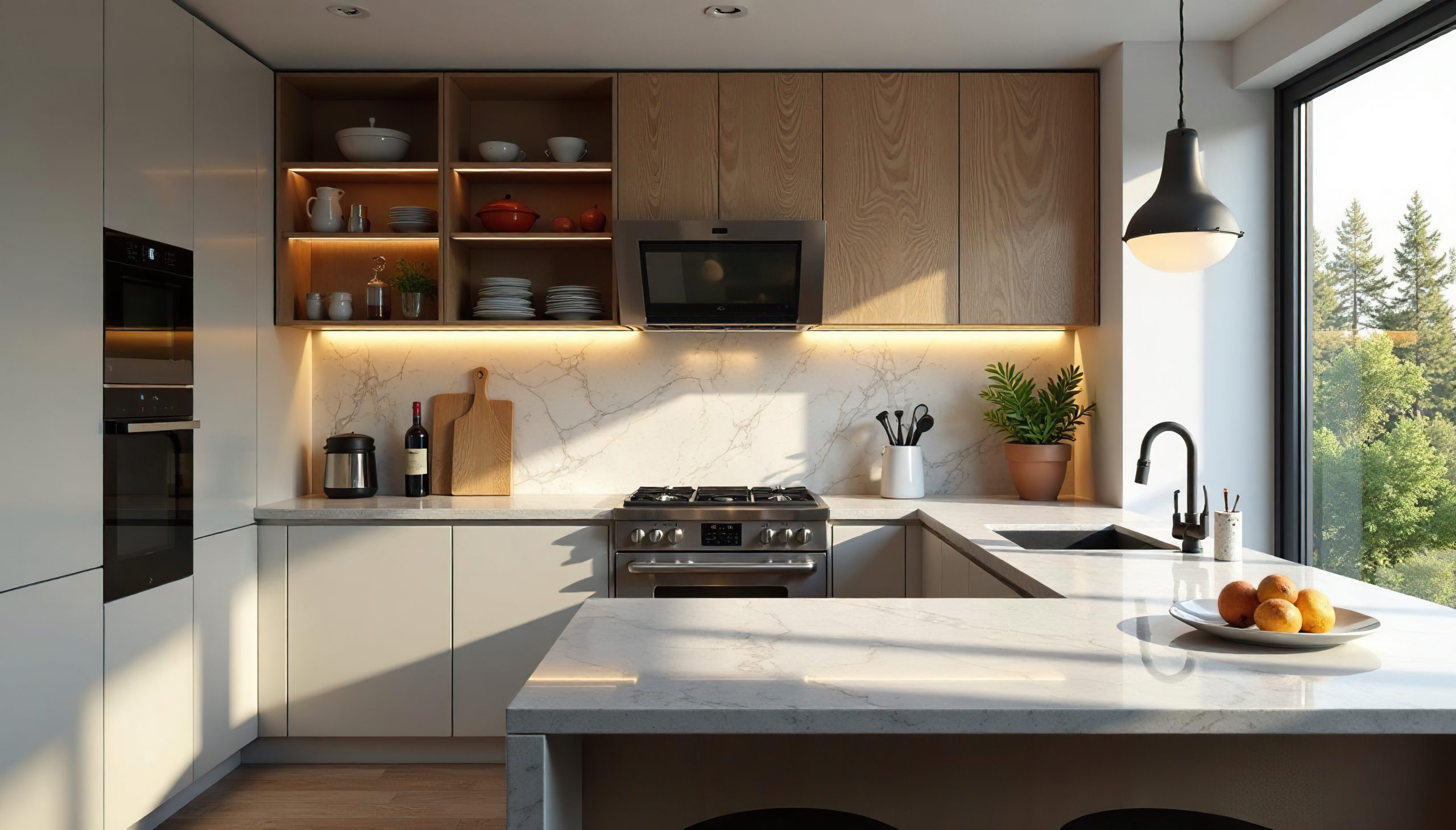
5. Innovative Modern Kitchen Island Bench Designs
Design 21: Smart Technology Integrated Island
Embracing the digital age, tech-integrated islands incorporate electronic innovations directly into the structure. These forward-thinking modern kitchen island bench designs feature technologies that enhance convenience and functionality.
Popular tech integrations include:
- Built-in wireless charging stations for devices
- Touch-control panels for lighting and appliance operation
- Built-in speakers and entertainment systems
- Smart displays for recipes and household management
These technological elements are typically integrated discreetly, maintaining the island’s clean aesthetic while adding significant functional value. The result is a space that feels contemporary yet remains visually uncluttered.
Pro Tip: When planning tech-integrated modern kitchen island bench designs, ensure adequate power sources and consider future-proofing with conduits that allow updating as technology evolves.
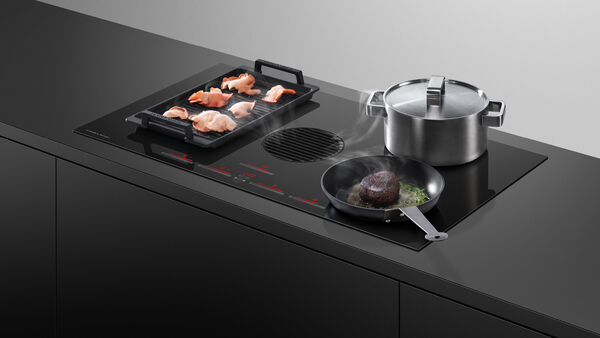
Design 22: Sustainable Material Island
Eco-conscious design takes centre stage with islands constructed from environmentally responsible materials. These modern kitchen island bench designs prioritise sustainability without sacrificing style or functionality.
Sustainable approaches include:
- Reclaimed wood for bases or countertops
- Recycled glass or paper composite surfaces
- Bamboo or other rapidly renewable materials
- Zero-VOC finishes and adhesives
Beyond material selection, these islands often incorporate energy-efficient features like LED lighting and water-saving fixtures. The result is a beautiful focal point with reduced environmental impact, increasingly important to many homeowners.
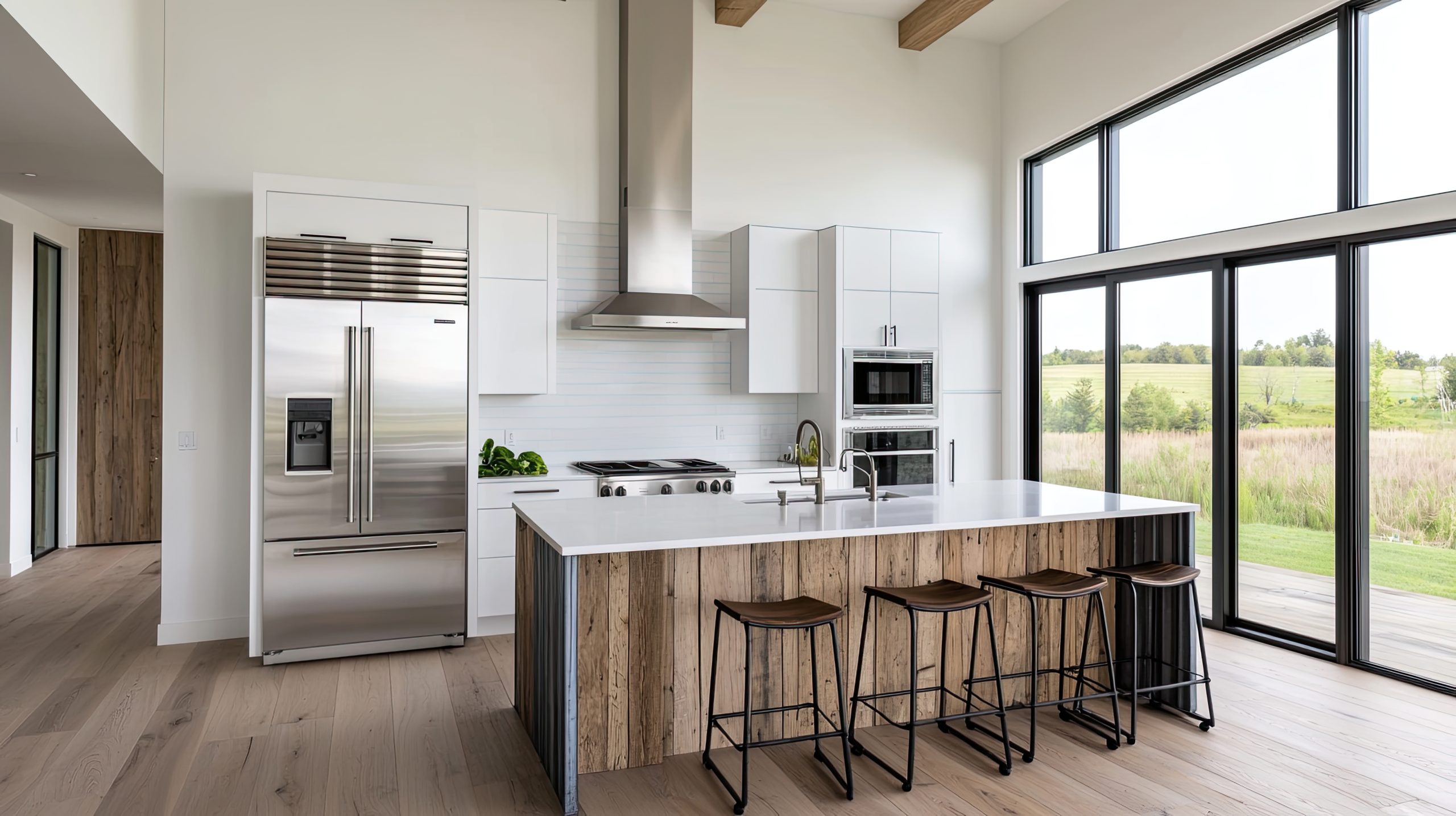
Design 23: Artistic Statement Island
For those seeking truly unique spaces, artistic statement islands transform kitchen workspaces into functional sculptures. These bold modern kitchen island bench designs incorporate creative elements that elevate the island from a functional object to an art piece.
Artistic approaches include:
- Sculptural bases with organic or geometric forms
- Custom-carved decorative elements
- Artist-designed tile work or mosaics
- Unusual material combinations with strong visual impact
While maintaining essential functionality, these islands prioritise aesthetic expression, becoming conversation pieces that define the kitchen’s character. They work particularly well in homes where the kitchen opens to living areas, serving as a bridge between utilitarian and social spaces.
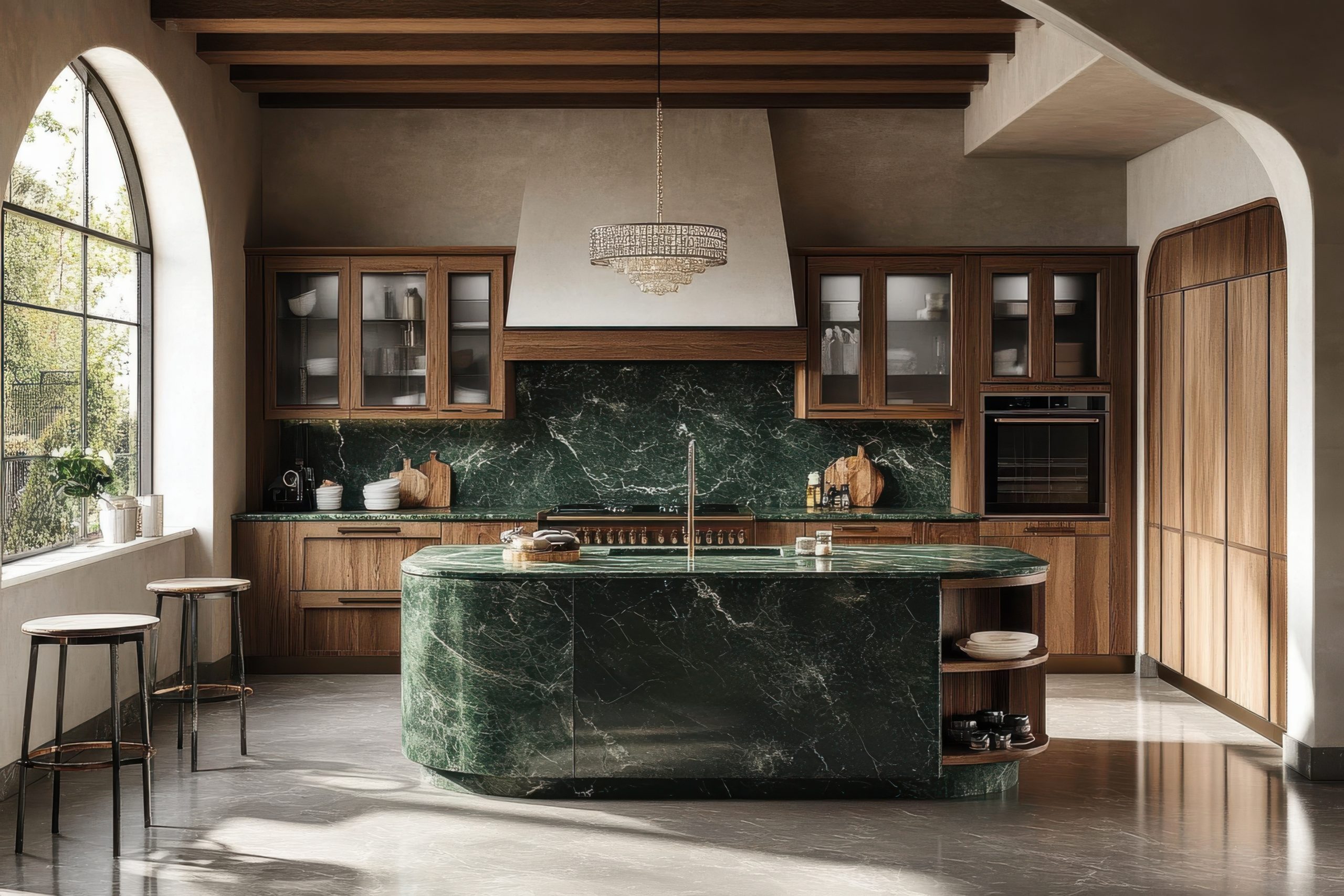
Design 24: Indoor-Outdoor Transitional Island
Blurring the boundary between interior and exterior spaces, transitional islands extend the kitchen’s functionality into outdoor living areas. These specialised modern kitchen island bench designs are positioned at the threshold between indoor and outdoor spaces, often incorporating pass-through elements.
Key features include:
- Weather-resistant materials on the exterior-facing side
- Pass-through windows or counters for serving outdoor areas
- Dual-sided storage accessible from both environments
- Continuous countertop materials that visually connect spaces
For homes in temperate climates or with significant outdoor living space, these islands create a seamless flow between cooking and entertaining zones, enhancing the overall living experience.
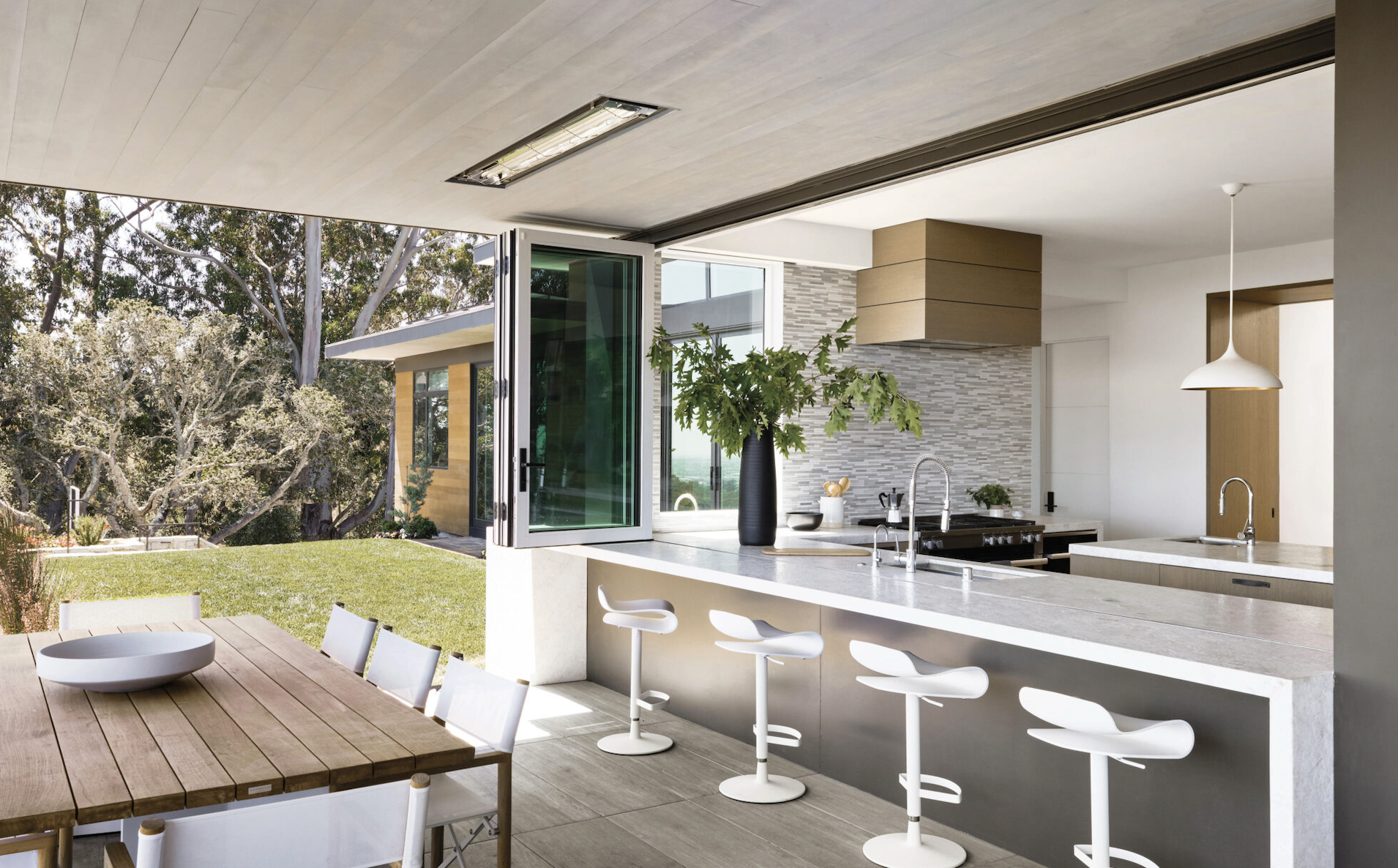
Design 25: Family-Focused Activity Island
Recognising the kitchen’s role as a family hub, these modern kitchen island bench designs incorporate features that support various family activities beyond cooking. They’re designed to accommodate homework, crafts, games, and other household functions.
Family-friendly features include:
- Height-adjustable sections for users of different ages
- Dedicated charging stations for devices
- Easy-clean surfaces that withstand art projects and homework
- Storage for school supplies and family activity materials
These thoughtfully designed islands acknowledge that in many homes, the kitchen island serves as command central for family life, not just cooking. By intentionally designing for these multiple uses, they better serve the real-life needs of busy households.
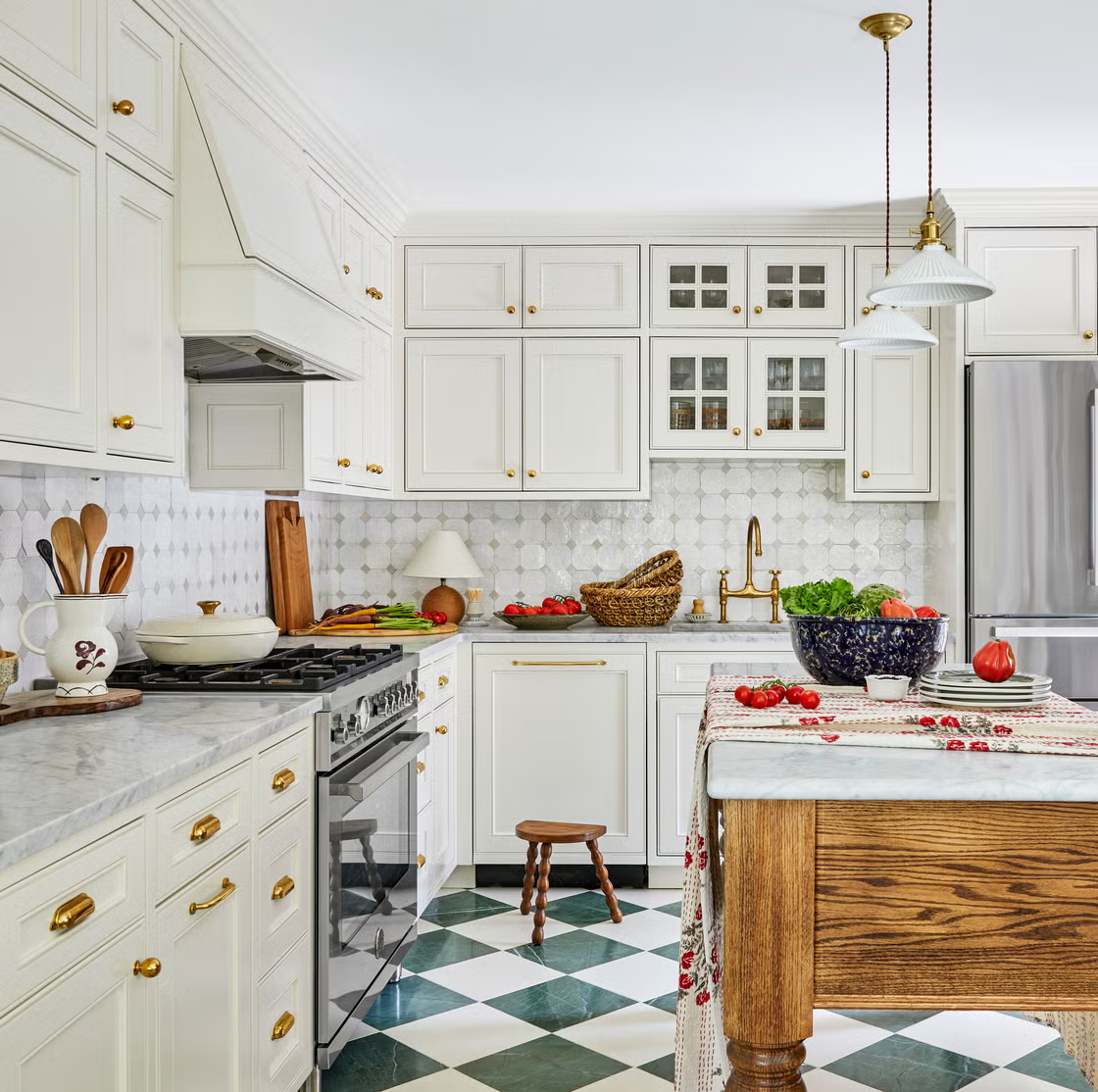
Whether you’re drawn to the sleek lines of waterfall edges, the practicality of integrated appliances, or the sustainability of eco-friendly materials, there’s a perfect island design to complement your home and lifestyle. By carefully considering how you use your kitchen and what matters most to you, you can select or create a modern kitchen island bench design that will serve as the centrepiece of your home for years to come.
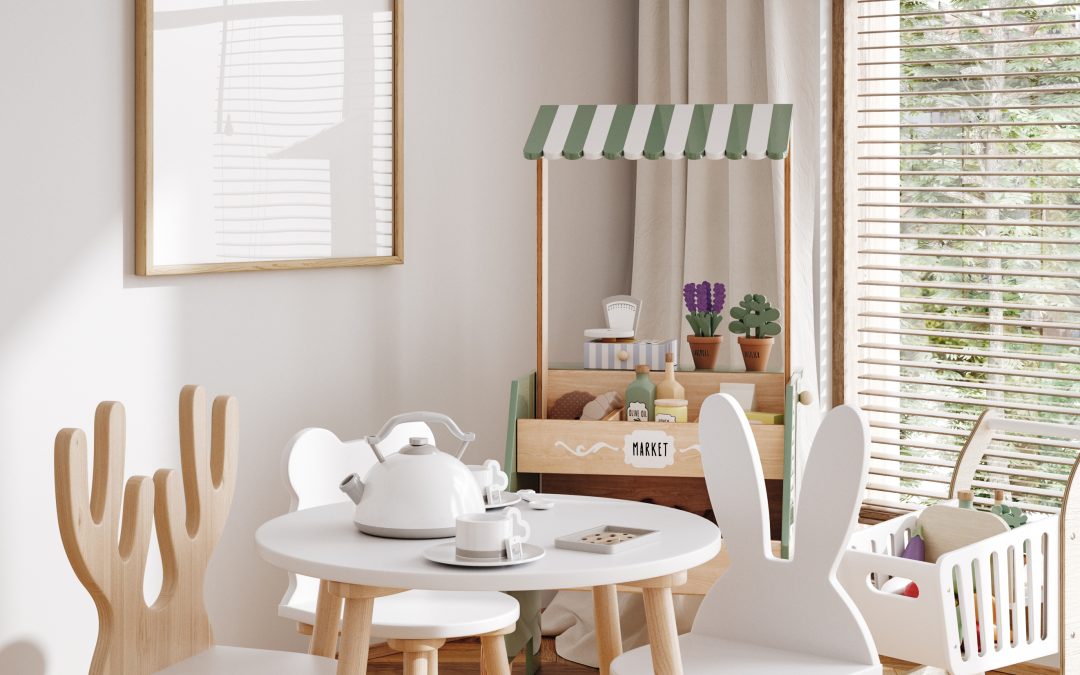
by Kesaa Interiors | Living Spaces, ROOMS, Storage & Organization
Creating a functional kids’ toy room requires thoughtful planning that balances organisation with imagination. A well-designed play space not only keeps toys contained but also fosters creativity, independence, and development.
Whether you’re working with a dedicated room or carving out a corner of your living space, the principles of effective toy room design remain consistent: accessible storage, defined activity areas, and systems that grow with your child.

1. Planning Your Kids Toy Room: The Essentials
Before purchasing storage containers or deciding on a colour scheme, take time to evaluate your specific needs. The most successful kids’ toy room designs begin with thoughtful planning.
- Assess your available space – Measure your area and note any architectural features that could impact your design
- Observe play patterns – Watch how your child interacts with their toys and what activities they gravitate toward
- Consider traffic flow – Allow adequate movement space between activity zones
- Plan for flexibility – Design a kids’ toy room that can evolve as interests change
- Establish a realistic budget – Prioritise essential organisational elements before decorative features
The most effective kids’ toy room designs balance visual appeal with practical functionality. Begin by dividing your space into activity zones based on how your child plays. A reading corner, building zone, creative area, and active play space create natural divisions that help children understand where different activities take place.

Pro tip: Before purchasing new storage solutions, take inventory of what toys need organising. Categories often include building blocks, creative supplies, books, pretend play items, and active toys.
2. Storage Solutions That Grow With Your Child
The foundation of any successful kids’ toy room is appropriate storage. Effective toy organisation systems should be both accessible to children and visually appealing.
Open shelving works particularly well for frequently used items and can double as display space in your kids’ toy room. Consider these options for different toy categories:
- Low, open shelves for daily-use toys that encourage independent access
- Closed cabinets for items that require adult supervision or create visual clutter
- Clear bins for collections like building blocks or toy vehicles
- Soft baskets for stuffed animals and dress-up clothes
- Book displays that show covers rather than spines for young readers
What makes a kids’ toy room truly functional is a labelling system appropriate for your child’s age. For pre-readers, use picture labels with corresponding images on bins. As children grow, transition to written labels that they can read independently.
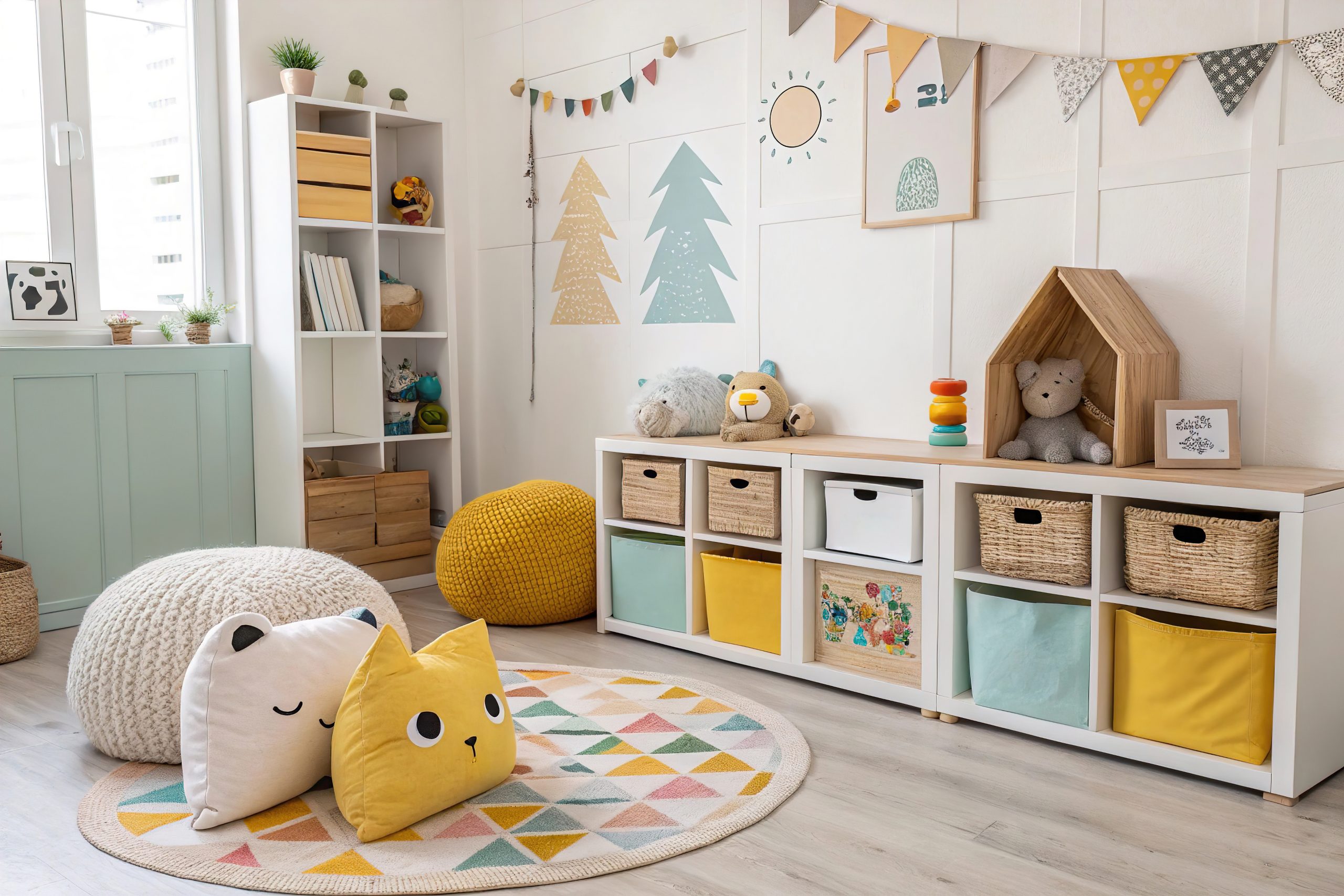
Pro tip: Modular storage systems allow your kids’ toy room to evolve as your child grows. Choose pieces that can be reconfigured or repurposed rather than age-specific furniture with limited longevity.
3. Flooring and Surface Considerations
The physical foundation of your kid’s toy room deserves careful consideration. Flooring needs to withstand creative messes, active play, and frequent cleaning.
Ideal flooring options for a kids’ toy room include:
- Luxury vinyl planks – Waterproof, durable, and available in attractive designs
- Low-pile carpeting – Offers comfort for floor play while being relatively easy to clean
- Large washable area rugs – Provide comfort over hardwood or tile
- Interlocking foam tiles – Create cushioned areas for active play
- Laminate flooring – Offers durability at a lower price point than hardwood
Wall surfaces in a kids’ toy room should balance aesthetics with practicality. Consider washable paint in a satin or semi-gloss finish that allows for wiping away inevitable marks. Magnetic paint or chalkboard sections create interactive areas that contain creative expression in designated spaces.
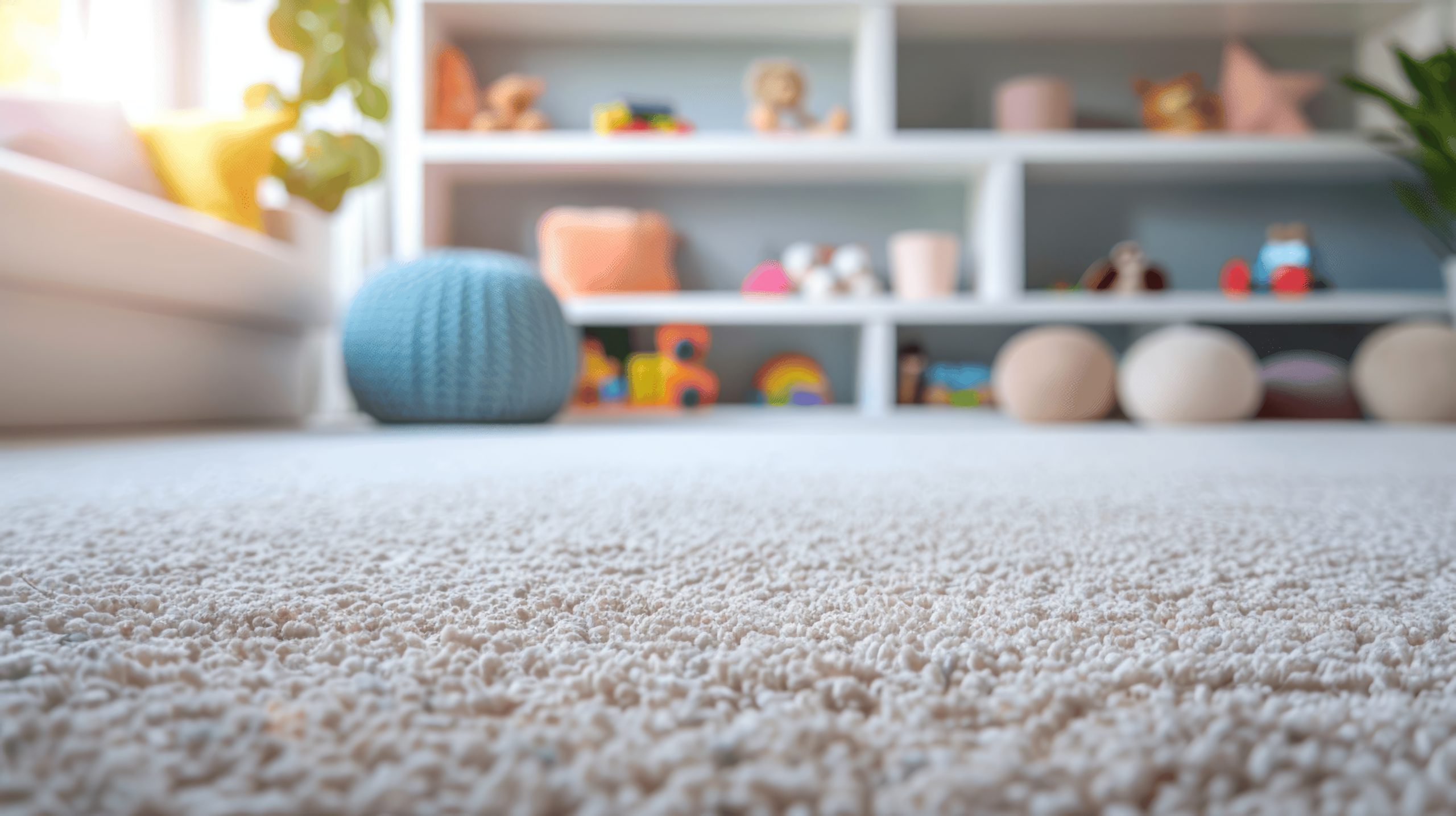
Pro tip: In multi-purpose spaces, use area rugs to define the kids’ toy room zone within a larger room. This creates a visual boundary that helps children understand where playthings belong.
4. Creating Activity Zones in Your Kids’ Toy Room
A well-designed kids’ toy room incorporates distinct areas that support different types of play. Each zone should include appropriate storage, surfaces, and materials specific to the activity.
Reading Nook Essentials
Create a cosy reading corner in your kids’ toy room with:
- Comfortable seating (child-sized armchair, floor cushions, or bean bags)
- Good lighting (preferably natural light supplemented with task lighting)
- Forward-facing book displays that highlight covers
- Soft textiles that invite settling in with a book
Art and Craft Corner Setup
Dedicate a creative space in your kids’ toy room with:
- A washable work surface at an appropriate height
- Organised supplies in accessible containers
- Display space for completed artwork
- Adequate lighting for detail work
- Protective covering for surfaces if needed
Building and Construction Zone
Support constructive play in your kids’ toy room with:
- Clear containers organised by piece type or set
- Flat building surfaces (LEGO tables, play mats)
- Display shelves for completed constructions
- Comfortable floor space for larger structures
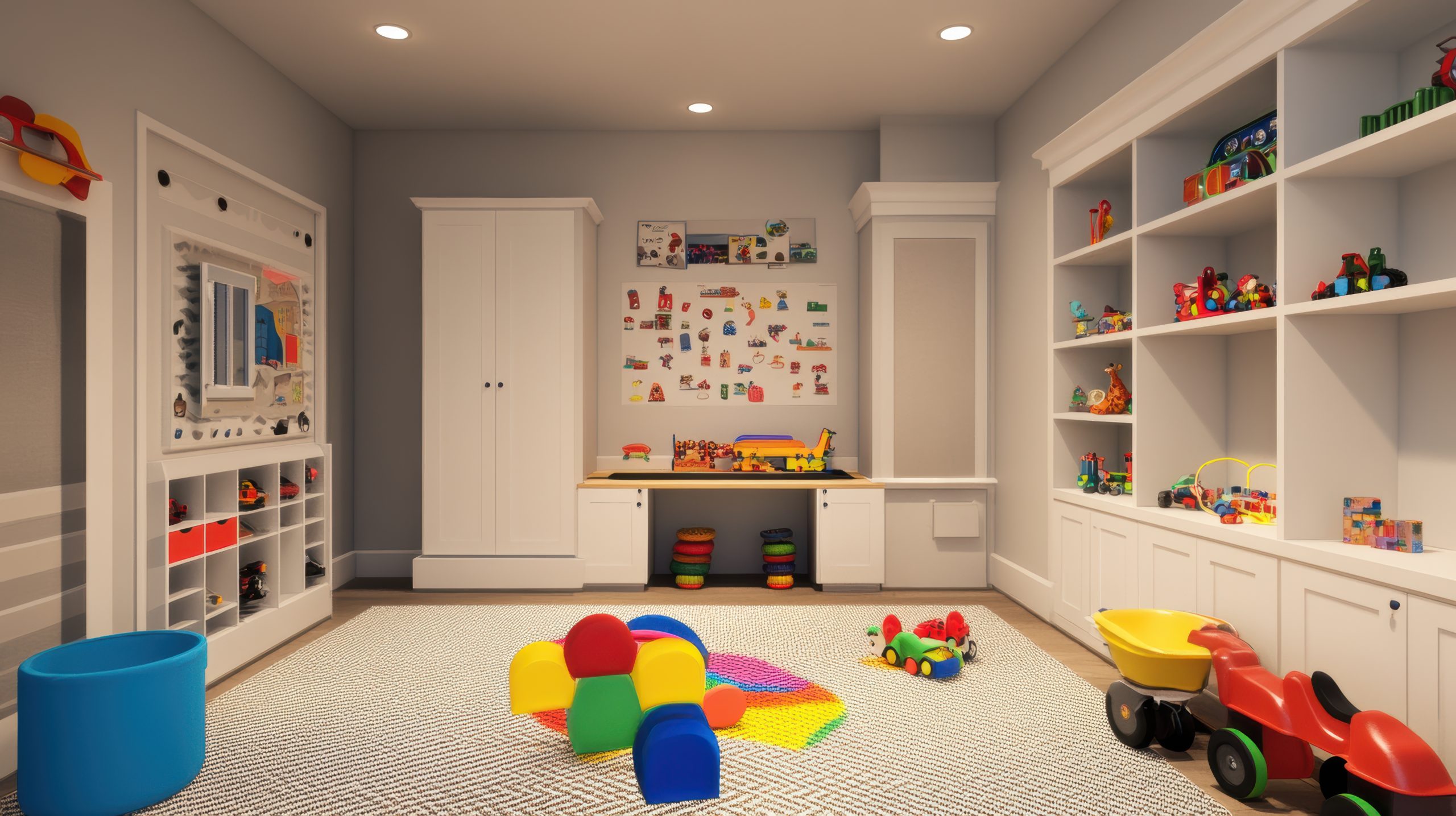
Pro tip: When designing zones in your kid’s toy room, consider acoustic properties. Place quieter activities like reading further from active play areas to allow simultaneous use by multiple children.
5. Display and Rotation Systems
A thoughtfully designed kids’ toy room includes intentional display areas that showcase special items and children’s creations. These displays serve multiple purposes: highlighting achievements, inspiring creativity, and creating visual interest in the space.
Effective display solutions for a kids’ toy room include:
- Gallery wall systems with easily changeable frames for rotating artwork
- Floating shelves at child height for displaying collections or creations
- Shadow boxes for three-dimensional items or special collections
- Wire systems with clips for frequently changing displays
- Museum-style display stands for showcasing current building projects
Implementing a toy rotation system keeps your kids’ toy room fresh and engaging while preventing overwhelm. Consider storing approximately one-third of toys out of sight, rotating them every few weeks to maintain interest while keeping the volume of visible toys manageable.
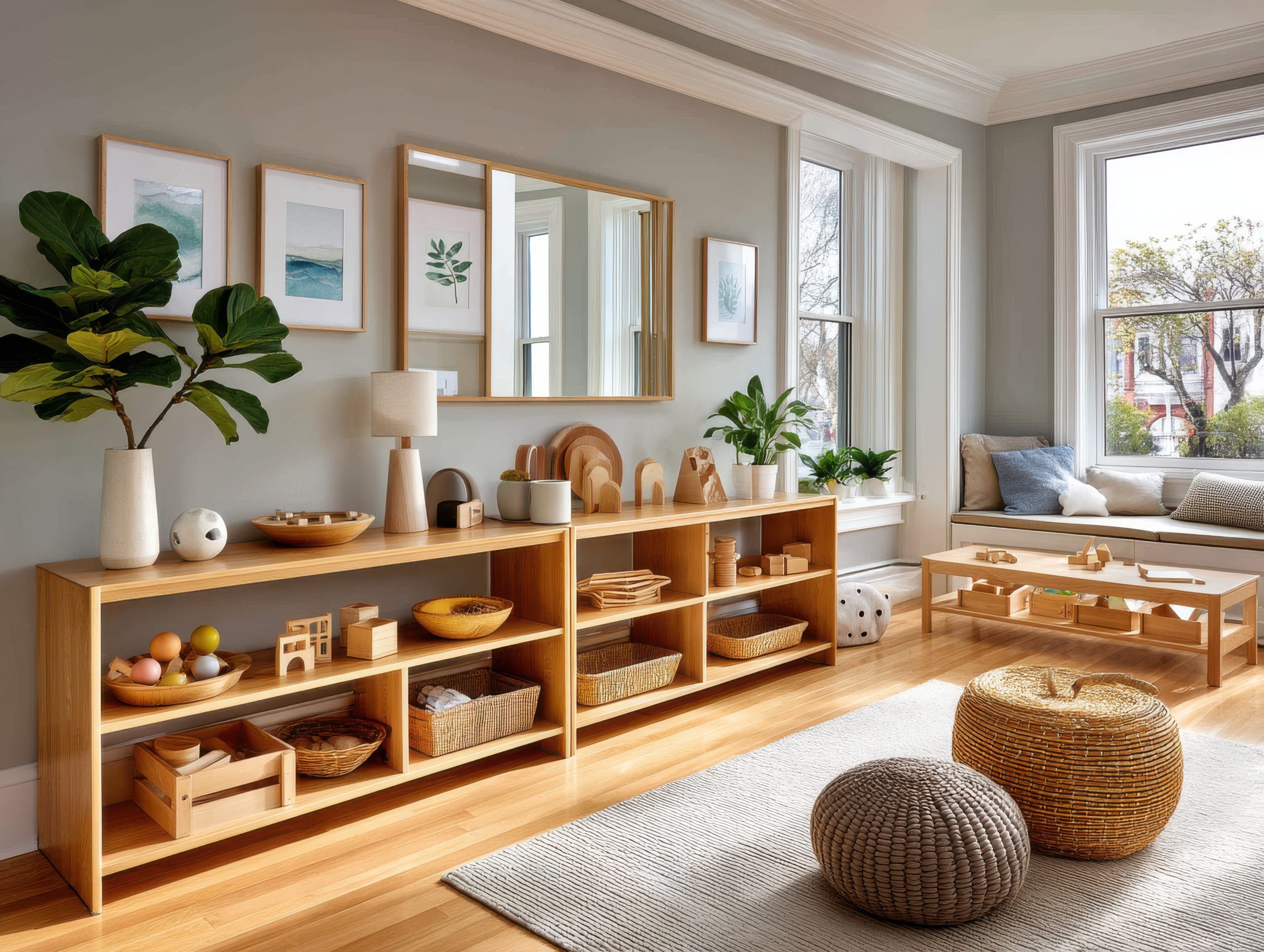
Pro tip: When designing your kids’ toy room, create a dedicated “display zone” where children can showcase their current projects without fear of them being dismantled or put away during cleanup time.
6. Lighting Your Kids’ Toy Room
Proper lighting transforms a kids’ toy room from functional to inspirational. A well-lit play space supports different activities while creating atmosphere and visual interest.
Consider these lighting elements for your kids’ toy room:
- Natural light – Position activity areas near windows when possible
- Overhead lighting – Provide even, ambient illumination throughout the space
- Task lighting – Add directed light for reading corners and craft areas
- Decorative lighting – Incorporate string lights or novelty fixtures that enhance the room’s theme
- Night lighting – Install dim options for evening transitions or nighttime comfort
The most effective kids’ toy room lighting plans include multiple sources at different heights. This layered approach creates a warm environment while ensuring adequate brightness for different activities.
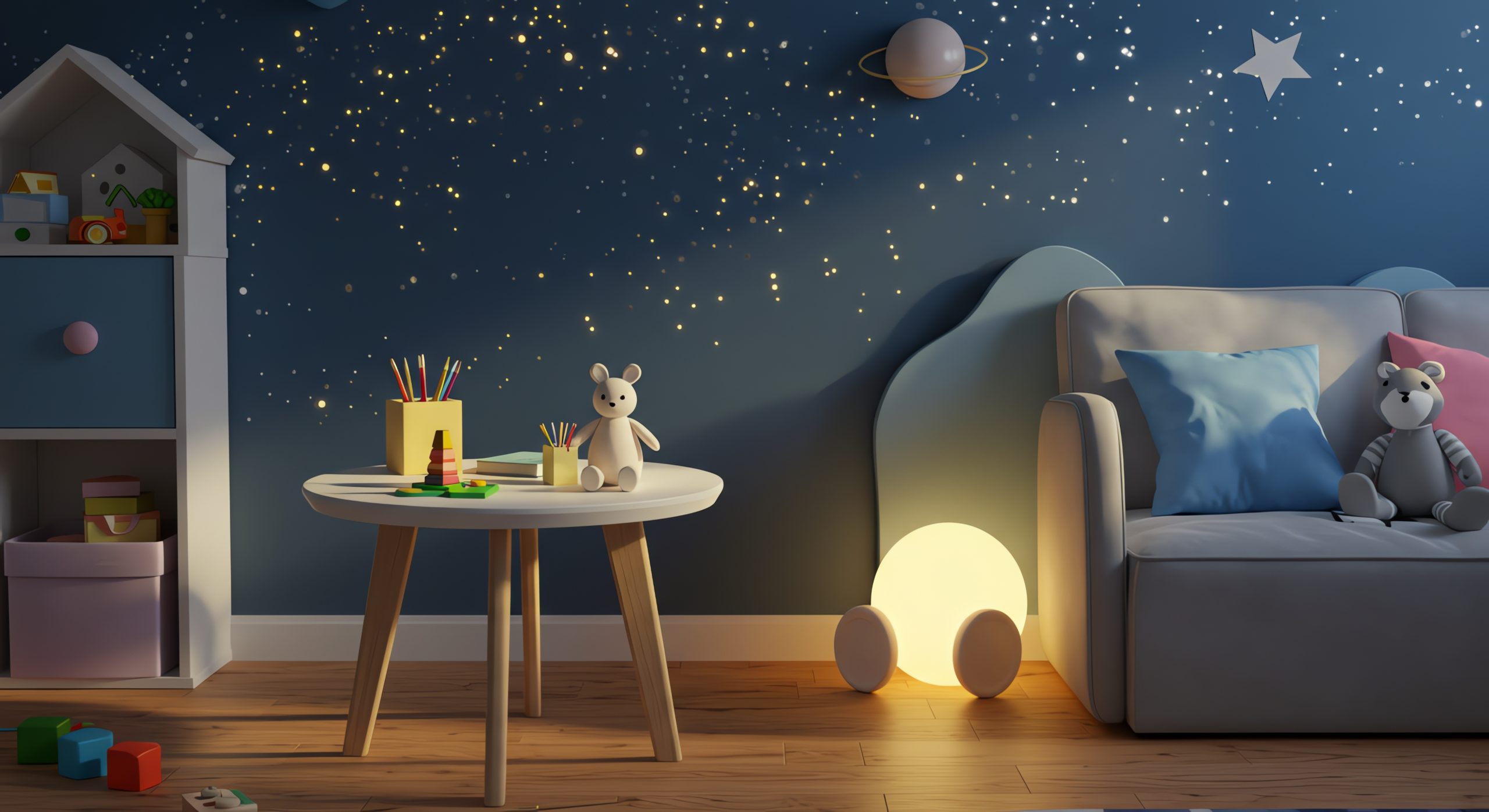
Pro tip: In a kids’ toy room, consider cord management and safety features when selecting lighting. Wall-mounted options eliminate floor cords, while LED fixtures provide brightness without heat concerns.
7. Small Space Solutions
Not every home can accommodate a dedicated kids’ toy room, but even small spaces can incorporate organised play areas with strategic planning.
Maximise limited space with these kids’ toy room solutions:
- Vertical storage – Utilise wall space with tall bookcases and mounted organisers
- Under-bed storage – Choose beds with built-in drawers or use rolling containers underneath
- Door-hanging organisers – Use over-door systems for small toys or supplies
- Dual-purpose furniture – Select ottomans with storage, desks with shelving, or benches with bins
- Corner solutions – Maximise overlooked corner spaces with custom shelving or activity stations
When creating a kids’ toy room in a shared space, clearly define boundaries using area rugs, bookcases as room dividers, or designated cabinets that close when playtime ends.
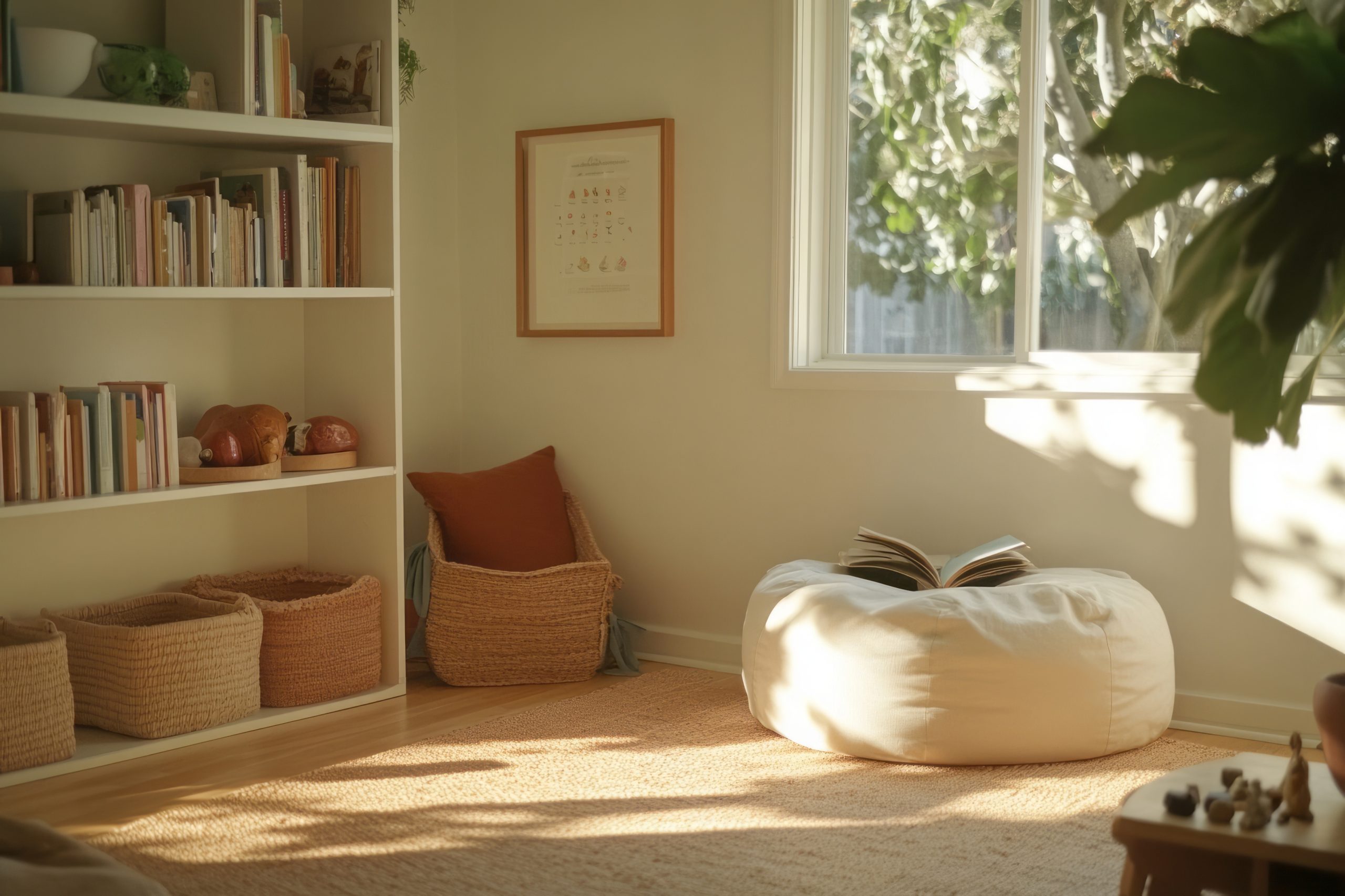
Pro tip: In apartments or small homes, create a “portable kids toy room” concept using dedicated containers that can be moved between spaces as needed, maintaining organisation while adapting to space limitations.
8. Theme and Décor Ideas That Inspire Play
Aesthetics matter in a kids’ toy room—not just for visual appeal, but because thoughtful design can stimulate imagination and engagement. The most successful play spaces balance personality with functionality.
When selecting a theme for your kids’ toy room, consider:
- Longevity – Choose concepts that can evolve as your child grows
- Neutrality – Select base elements that work with changing interests
- Flexibility – Incorporate themes through easily-changed accessories rather than permanent fixtures
- Child input – Involve children in age-appropriate decisions to increase their ownership of the space
- Colour psychology – Understand how different hues affect mood and behaviour
A well-designed kids’ toy room often uses colour strategically rather than overwhelmingly. Consider a neutral base palette with colourful accents that can be updated. This approach creates a visually calm environment while still offering personality and interest.

Pro tip: Rather than character-specific themes that may quickly fall out of favour, consider concept-based themes for your kids’ toy room, such as nature, adventure, or creativity, that can adapt as interests evolve.
9. Organisation Systems That Work
Creating a kids’ toy room is one achievement; maintaining it is another. Successful play spaces incorporate systems that make ongoing organisation manageable for both parents and children.
Effective kids’ toy room maintenance strategies include:
- Consistent categories – Group similar items together in logical categories
- Clear visual systems – Use consistent colours, labels, or symbols for different toy types
- Appropriate independence – Design storage that children can manage without assistance
- Regular reset times – Establish daily quick-cleanup and weekly deeper organisation routines
- One-in-one-out policy – Maintain toy volume by removing items when new ones enter the rotation
Labelling deserves special attention in any kids’ toy room organisation system. For younger children, use picture labels that clearly show what belongs where. As children develop reading skills, transition to word labels that support literacy development.
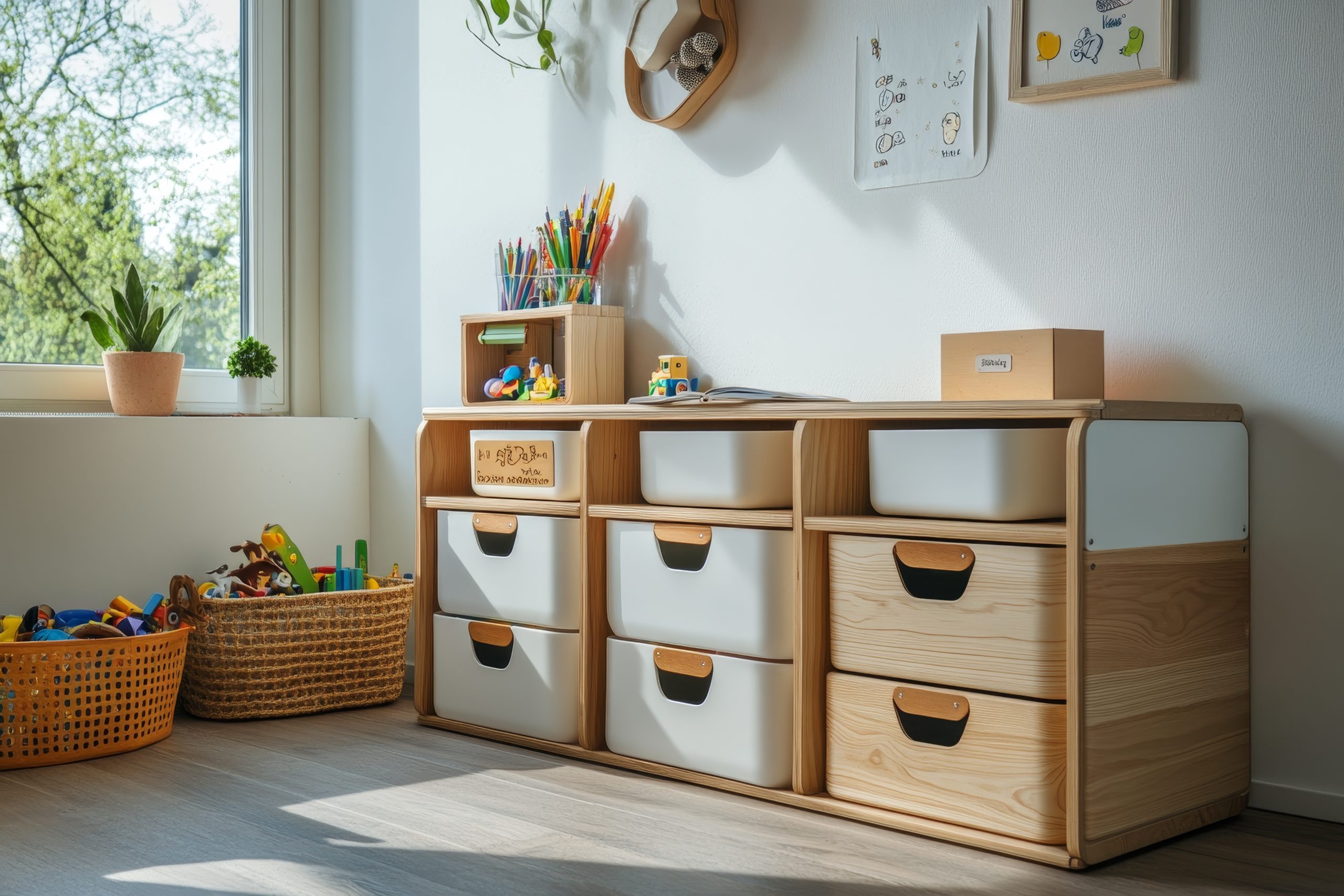
Pro tip: In a well-designed kids’ toy room, incorporate a “halfway house” basket for items that need parental help to put away. This teaches responsibility while acknowledging developmental capabilities.
10. Real Family Examples: Kids Toy Rooms That Work
While every family’s needs differ, examining successful kids’ toy room solutions provides valuable inspiration. The following examples demonstrate how core principles adapt to different situations.
Small Space Solution
A 6×8-foot dedicated area transformed into a complete kids’ toy room by:
- Using full-height wall storage
- Implementing a fold-down activity table
- Creating vertical display systems
- Utilising under-furniture storage
- Employing a strict rotation system to limit visible toys
Shared Sibling Space
A kids’ toy room designed for multiple ages incorporating:
- Colour-coded storage for each child
- Height-appropriate activity zones
- Lockable storage for materials needing supervision
- Flexible furniture arrangement for varying play styles
- Designated personal spaces within the shared room
Budget Transformation
An impressive kids’ toy room created with limited funds by:
- Repurposing existing furniture with paint
- Using inexpensive plastic bins with custom labels
- DIY wall organisation systems
- Strategic lighting upgrades
- Creative use of wall space for both storage and play
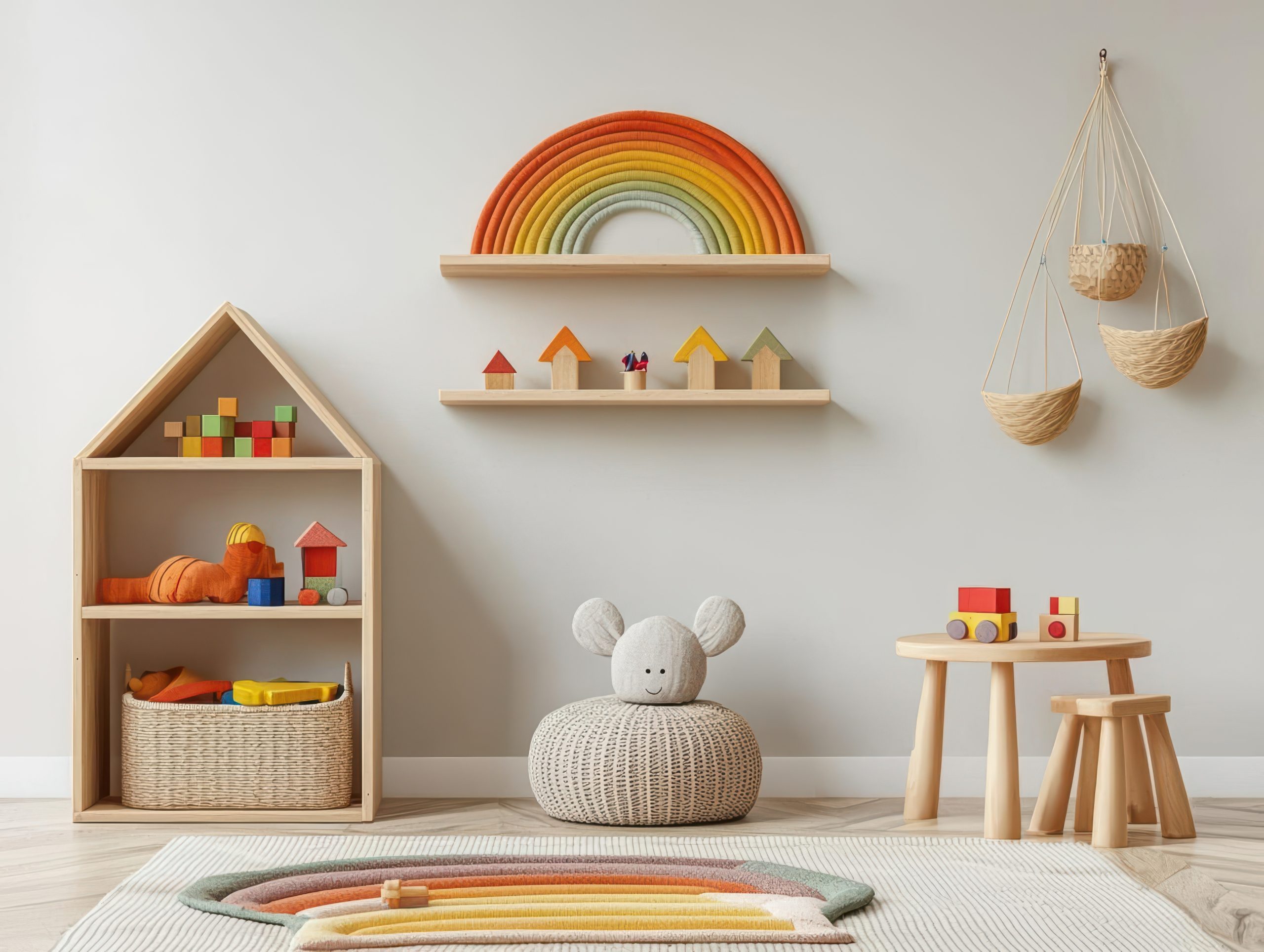
Pro tip: The most successful kids’ toy room designs prioritise organisational infrastructure first, with decorative elements added after the functional systems are established.
Conclusion
Creating an effective kids’ toy room involves balancing practical organisation with spaces that inspire creativity and independent play. The most successful designs consider not just current needs but how the space will evolve as children grow.
Key takeaways for designing your kids’ toy room include:
- Start with clear zones based on your child’s play patterns
- Prioritise accessible, intuitive storage systems
- Create visual calm through thoughtful design choices
- Implement maintenance routines that grow with your child
- Allow flexibility for changing interests and developmental needs
Remember that a well-designed kids’ toy room serves multiple purposes: containing toy clutter, supporting development through appropriate play opportunities, and creating an environment where children can exercise independence and creativity.
By applying these principles, you can create a kids’ toy room that works for your unique space, budget, and family needs, transforming toy chaos into an organised, inspiring environment that benefits both children and parents.
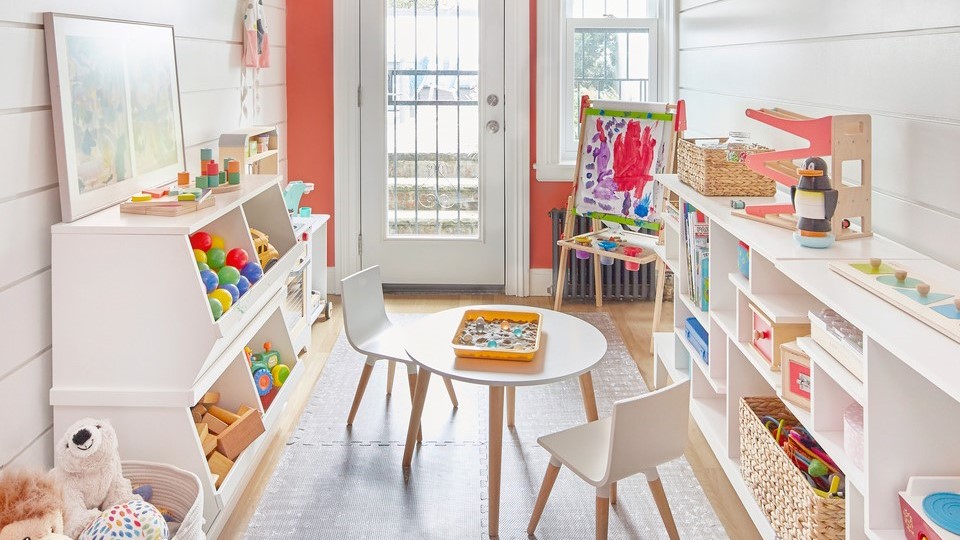
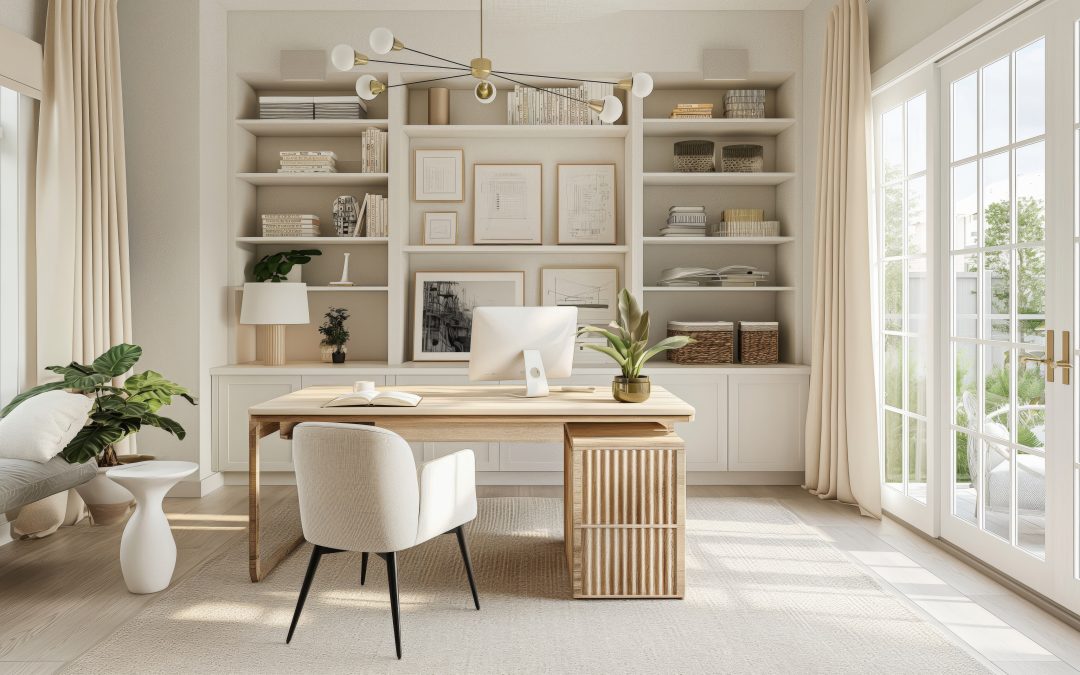
by Kesaa Interiors | ROOMS
Want to know what the essentials are for a productive home office design? You have come to the right place to find out!
As an interior designer, I’ve seen firsthand how the right environment can make all the difference, especially when it comes to working from home. With more of us setting up shop in our living spaces, having a productive home office design is crucial.
It’s not just about having a desk and chair; it’s about creating a space that inspires and helps you stay focused. Today, I want to share some tips on how you can transform your home office into a functional and motivating place. Let’s dive in!

Best Productive Home Office Design Essentials!
1. Understanding the Basics of Productive Home Office Design
Creating a productive home office design starts with understanding what you need from your workspace. It’s about more than just aesthetics; it’s about functionality and personal comfort. Here’s how you can start:
- Identify Your Work Style: Are you someone who thrives in a minimalist setting, or do you need a bit of creative chaos around you? Understanding your work style is key to designing a space that works for you. A productive home office design should cater to your specific needs, whether that means having plenty of storage for your files or a big whiteboard for brainstorming sessions.
- Balance Aesthetics and Functionality: You want a space that feels inviting and reflects your personal style, but it also needs to support your work habits. Think of it as creating a little haven where you can be your most productive self. Consider the following:
- Colour Schemes: Choose colours that boost your mood and concentration. Blues and greens are known for their calming effects, while yellows can stimulate creativity.
- Textures and Materials: Incorporate materials that are both pleasing to the eye and functional. A wooden desk can add warmth, while a glass surface might offer a sleek, modern look.
- Personalisation: It’s not just about the furniture and decor. It’s about creating an environment that helps you focus and get things done. Add personal touches that make the space uniquely yours:
- Artwork and Decor: Hang art that inspires you or display items that have personal significance.
- Plants: Incorporate greenery to improve air quality and add a touch of nature.
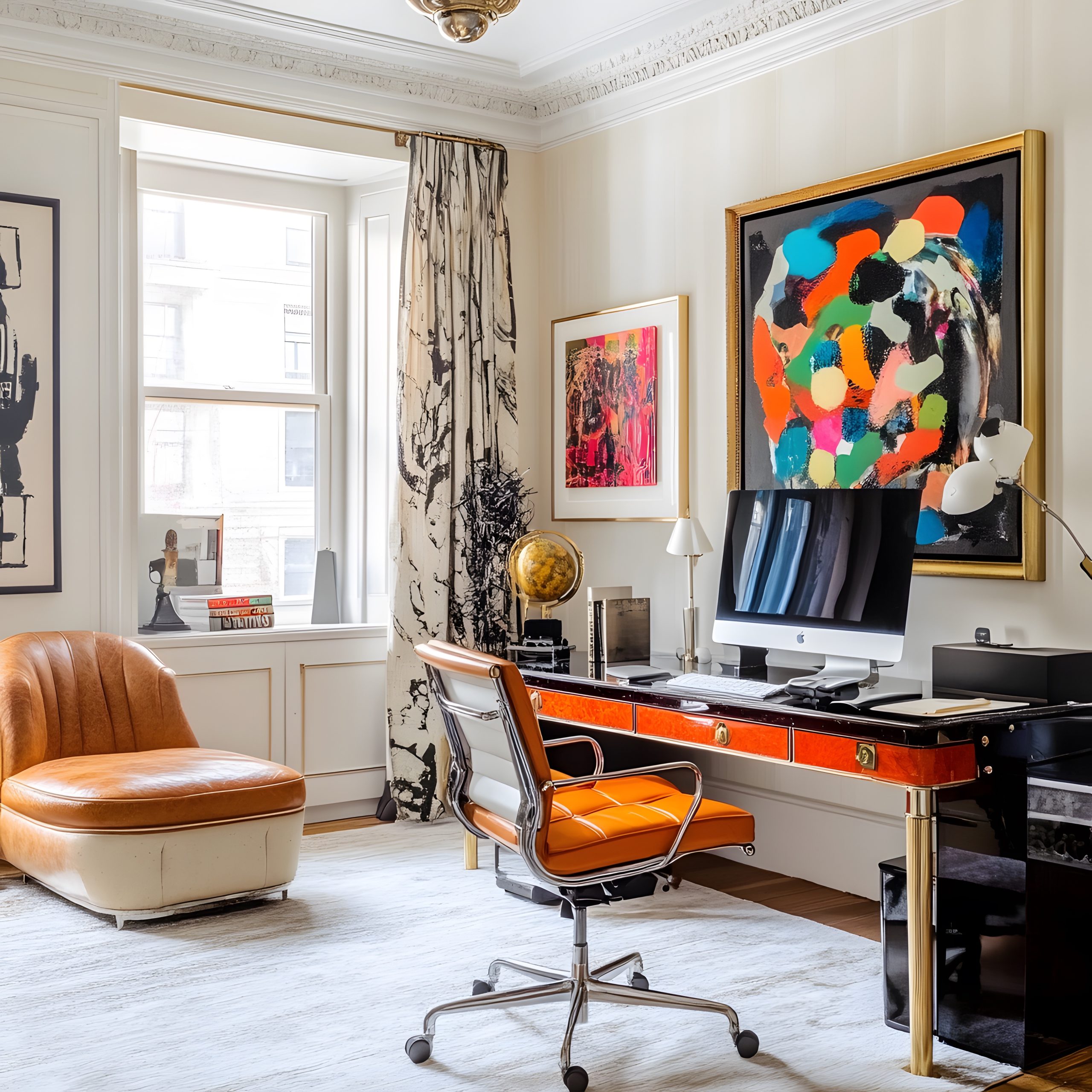
By understanding these basics, you can start to create a productive home office design that not only looks great but also enhances your work performance. Now, let’s move on to choosing the right location for your home office.
2. Choosing the Right Location
Selecting the perfect spot for your home office is a crucial step in achieving a productive home office design. The location can significantly impact your focus and efficiency, so here’s what to consider:
- Assess Your Space: Look around your home and identify potential areas for your office. Consider:
- Natural Light: Spaces with ample natural light can boost your mood and energy levels. Try to position your desk near a window if possible.
- Quietness: Choose a location away from high-traffic areas to minimise distractions. A spare room or a quiet corner can work wonders.
- Space Availability: Ensure there’s enough room for your desk, chair, and any additional furniture or equipment you might need.
- Potential Locations: Depending on your home’s layout, here are some ideas:
- Spare Room: If you have an extra room, it can be transformed into a dedicated office space.
- Living Room Corner: Utilise a corner of your living room with a compact desk setup.
- Converted Closet: A larger closet can be converted into a cosy office nook with some creative shelving and lighting.
- Considerations for Shared Spaces: If you’re sharing your workspace with others, think about:
- Privacy: Use room dividers or screens to create a sense of separation.
- Noise Control: Invest in noise-cancelling headphones or soundproofing materials to maintain focus.
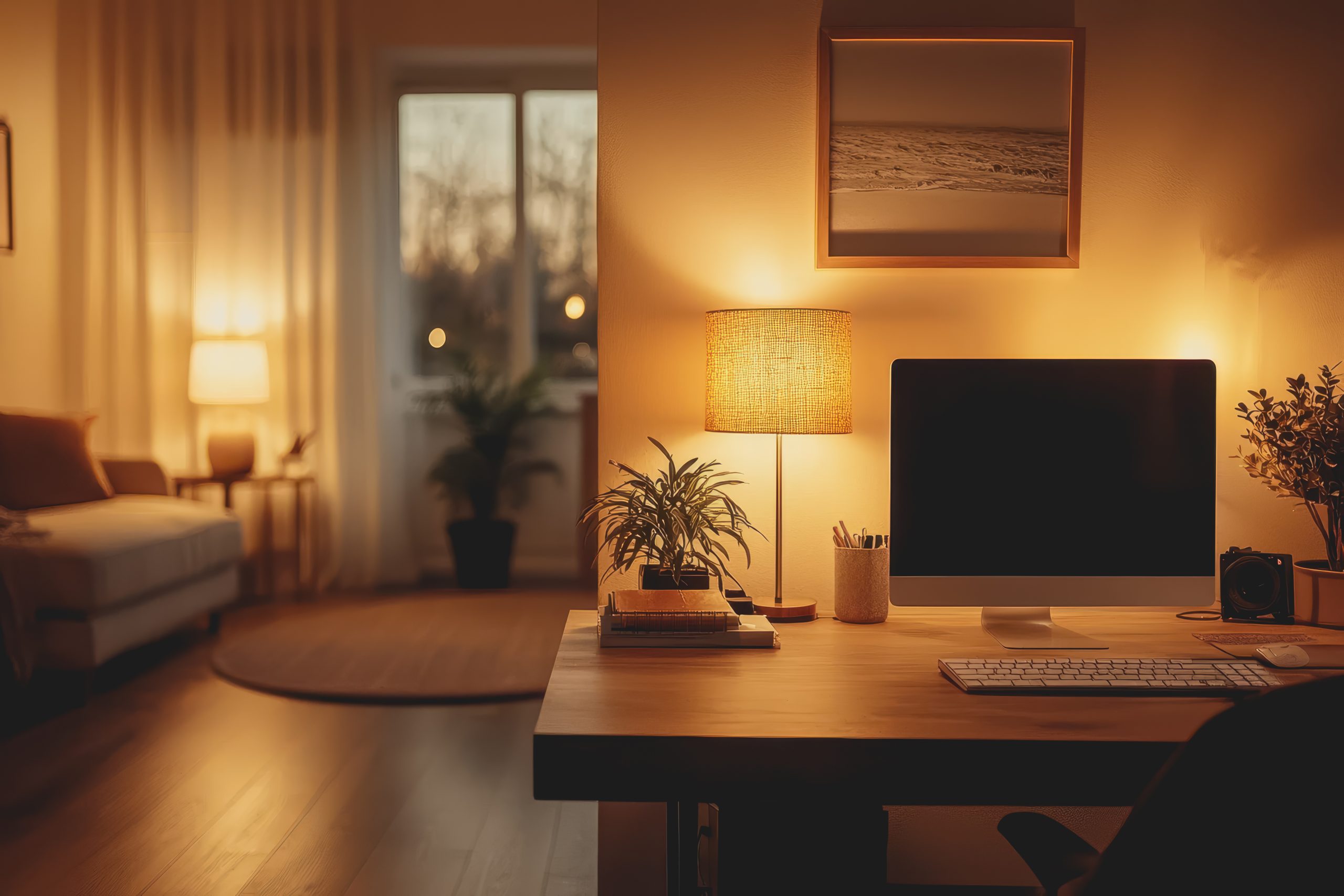
Choosing the right location is foundational to a productive home office design. Once you’ve found your spot, it’s time to think about the furniture that will support your work.
3. Ergonomic Furniture Selection
Ergonomic furniture is essential for maintaining comfort and productivity throughout your workday. Here’s how to choose the right pieces for your productive home office design:
- Desk Selection: Your desk is the centrepiece of your office, so choose wisely:
- Size and Shape: Ensure your desk fits comfortably in your space and provides enough surface area for your work essentials.
- Adjustability: Consider a height-adjustable desk to switch between sitting and standing, promoting better posture and circulation.
- Chair Considerations: A good chair is crucial for long hours of work:
- Support and Comfort: Look for chairs with lumbar support and adjustable features to fit your body’s needs.
- Material and Design: Choose a chair with breathable fabric and a design that complements your office aesthetic.
- Additional Furniture and Accessories:
- Footrests and Arm Supports: These can help reduce strain and improve comfort.
- Storage Solutions: Incorporate shelves, cabinets, or drawers to keep your workspace organised and clutter-free.
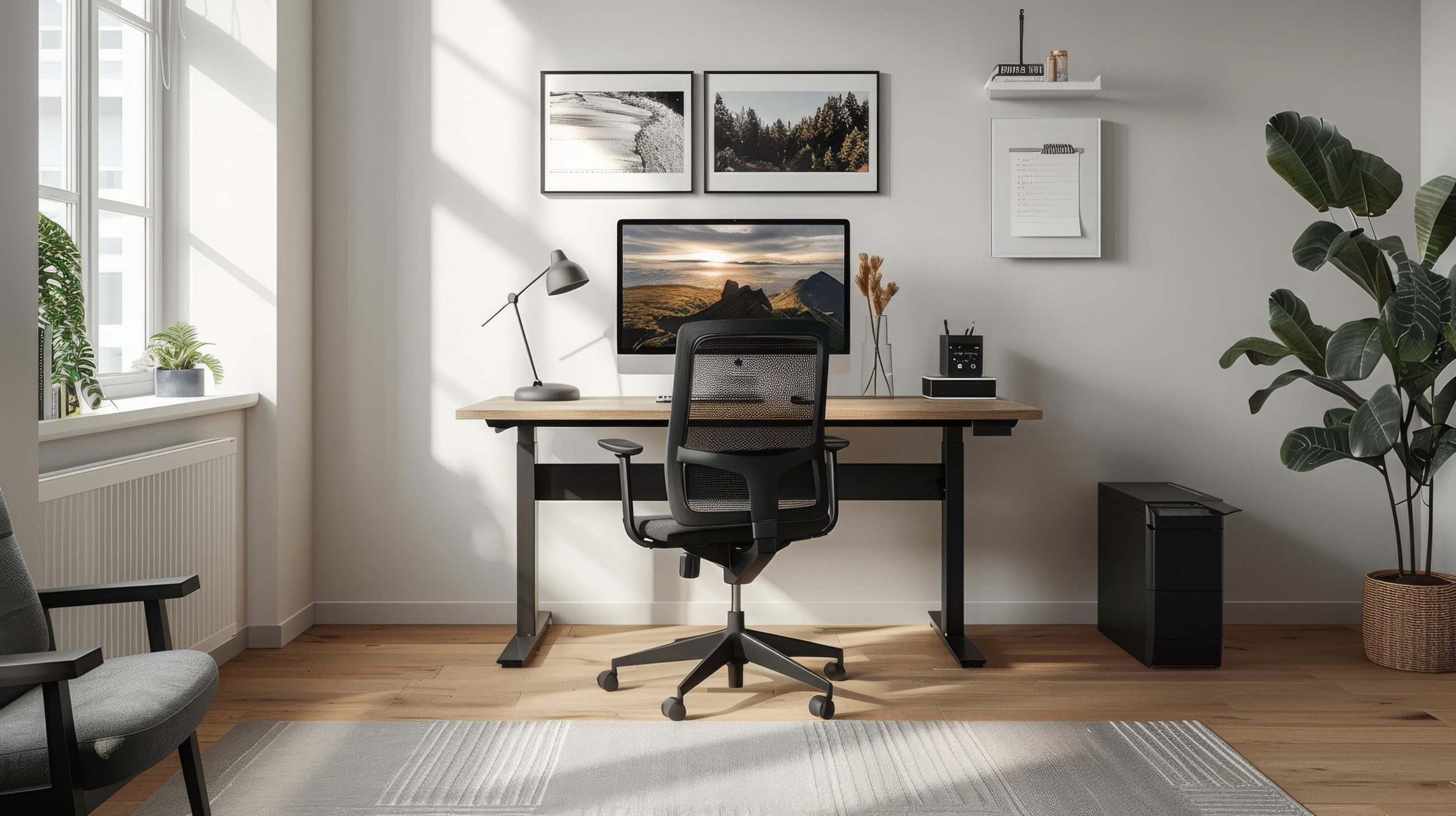
Investing in ergonomic furniture is a key component of a productive home office design. It ensures that you can work comfortably and efficiently, reducing the risk of strain or injury. Next, let’s explore how lighting can further enhance your workspace.
4. Optimising Lighting for Productivity
Lighting plays a pivotal role in creating a productive home office design. The right lighting can enhance your mood, reduce eye strain, and improve overall productivity. Here’s how to optimise your office lighting:
- Maximise Natural Light:
- Positioning: Place your desk near a window to take advantage of natural light, which can boost your mood and energy.
- Window Treatments: Use sheer curtains or blinds to control glare while still allowing light to filter through.
- Artificial Lighting Options:
- Task Lighting: Invest in a good desk lamp with adjustable brightness to focus light where you need it most.
- Ambient Lighting: Use overhead lights or floor lamps to provide general illumination and reduce shadows.
- Adjustable Lamps: Consider lamps with adjustable arms and dimmable features to customise lighting based on the time of day and task.
- Lighting Tips for Different Times of Day:
- Morning: Use bright, cool-toned lights to energise and wake up.
- Afternoon: Natural light should be maximised, supplemented with task lighting as needed.
- Evening: Switch to warmer, softer lighting to help wind down and reduce eye strain.
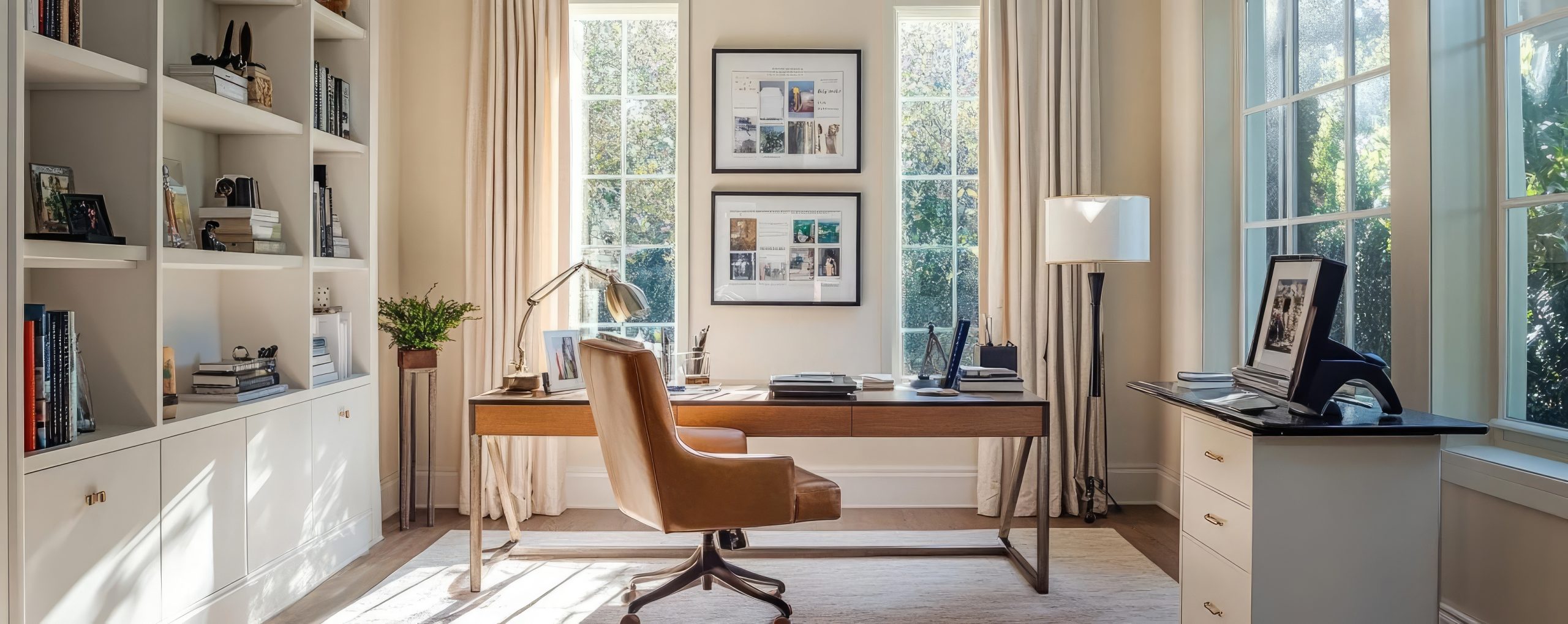
Optimising your lighting setup is essential for a productive home office design. It not only enhances visibility but also creates a comfortable and inviting atmosphere. Now, let’s look at how organisation can further boost your productivity.
5. Organising for Efficiency
An organised workspace is a cornerstone of a productive home office design. It helps minimise distractions and keeps you focused on your tasks. Here’s how to achieve an efficient setup:
- Declutter Your Space:
- Regular Clean-ups: Schedule regular decluttering sessions to keep your workspace tidy.
- Essential Items Only: Keep only the items you use daily on your desk to avoid unnecessary clutter.
- Utilise Storage Solutions:
- Shelves and Cabinets: Install shelves or cabinets to store books, files, and office supplies neatly.
- Desk Organisers: Use trays, bins, and drawer organisers to keep small items in order.
- Digital Organisation:
- File Management: Use digital tools and cloud storage to organise and back up important documents.
- Task Management Apps: Implement apps to keep track of tasks and deadlines, reducing paper clutter.
- Personalised Systems:
- Labelling: Clearly label storage areas to make finding items easier.
- Colour Coding: Use colour-coded systems for files and folders to quickly identify categories.
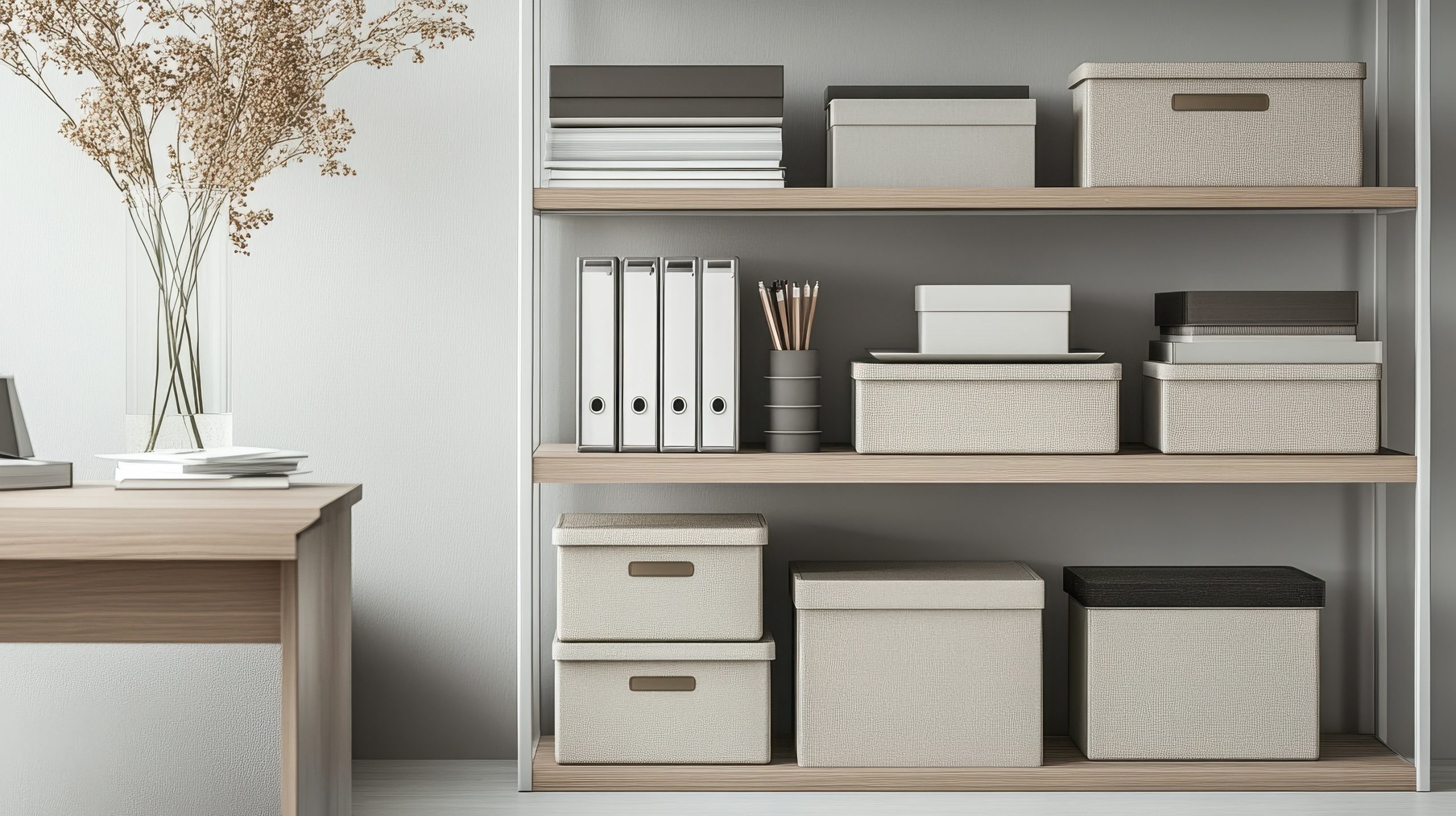
By organising your workspace efficiently, you create a productive home office design that supports your workflow and reduces stress. Next, we’ll explore how personalising your workspace can inspire creativity and motivation.
6. Personalising Your Workspace
Personalising your workspace is a vital aspect of a productive home office design. It not only makes the space feel more inviting but also boosts your creativity and motivation. Here’s how to add personal touches to your office:
- Incorporate Personal Style:
- Artwork and Decor: Hang art pieces that inspire you or display personal photos and mementos that bring joy.
- Colour Schemes: Choose colours that resonate with you and enhance your mood. Whether it’s calming blues or energising yellows, let your personality shine through.
- Add Greenery:
- Plants: Introduce indoor plants to improve air quality and add a touch of nature. Consider low-maintenance options like succulents or snake plants.
- Planters and Pots: Use decorative planters that complement your office decor.
- Create a Vision Board:
- Inspiration and Goals: Pin up images, quotes, and goals that inspire you and keep you focused on your aspirations.
- Rotating Content: Update your board regularly to keep the inspiration fresh and relevant.
- Comfort and Cosiness:
- Textiles: Add cushions, throws, or a cosy rug to make the space more comfortable.
- Scented Candles or Diffusers: Use scents that help you relax and concentrate, like lavender or citrus.

Personalising your workspace is about making it a place where you feel comfortable and inspired. It’s a key element of a productive home office design that reflects who you are. Now, let’s discuss how to seamlessly integrate technology into your office setup.
7. Incorporating Technology and Connectivity
In today’s digital age, technology is an integral part of a productive home office design. Ensuring seamless connectivity and efficient tech integration can significantly enhance your workflow. Here’s how to do it:
- Reliable Internet Connection:
- Router Placement: Position your router centrally to ensure strong Wi-Fi coverage throughout your office.
- Wired Connections: Consider using Ethernet cables for a more stable and faster internet connection.
- Tech Integration:
- Cable Management: Use cable organisers or clips to keep cords tidy and out of sight, reducing visual clutter.
- Charging Stations: Set up a dedicated area for charging devices, keeping them organised and easily accessible.
- Essential Tech Accessories:
- Monitors and Stands: Invest in a quality monitor and adjustable stand to improve ergonomics and reduce eye strain.
- Peripherals: Choose a comfortable keyboard and mouse that suit your work style.
- Smart Office Solutions:
- Voice Assistants: Use smart speakers or assistants to set reminders, control lighting, or play music.
- Automation Tools: Implement software that automates repetitive tasks, freeing up time for more important work.
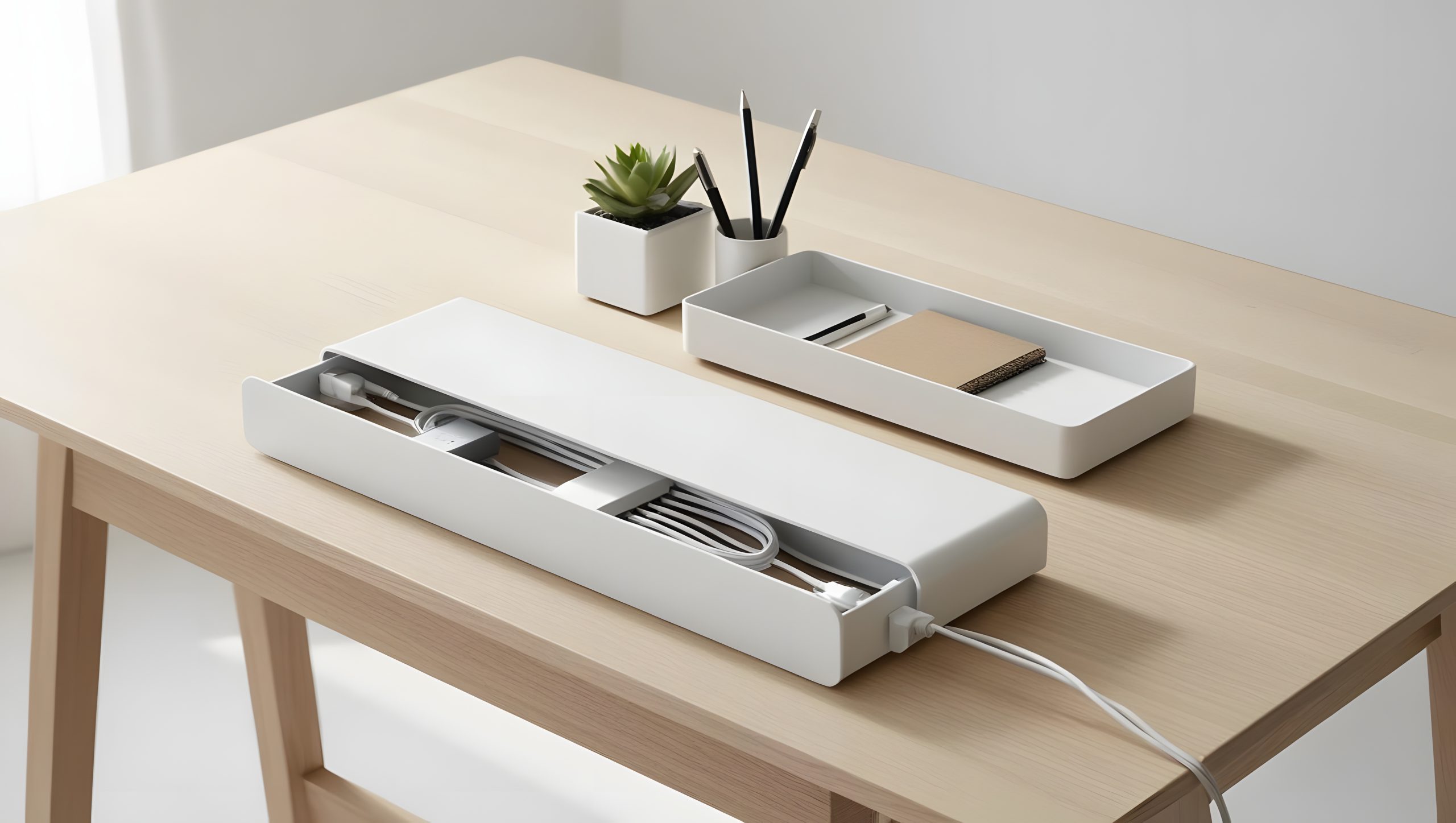
Incorporating technology effectively is crucial for a productive home office design. It ensures that your workspace is equipped to handle your daily tasks efficiently. Finally, let’s explore how to maintain a productive atmosphere in your home office.
8. Maintaining a Productive Atmosphere
Creating a productive home office design is just the beginning; maintaining a productive atmosphere is key to long-term success. Here are some strategies to keep your workspace conducive to productivity:
- Establish a Routine:
- Consistent Schedule: Set regular work hours to create a sense of structure and discipline.
- Breaks and Downtime: Schedule short breaks to recharge and prevent burnout. Consider techniques like the Pomodoro Technique to manage time effectively.
- Minimise Distractions:
- Noise Control: Use noise-cancelling headphones or white noise machines to block out distractions.
- Digital Boundaries: Limit social media and non-work-related browsing during work hours to stay focused.
- Refresh Your Workspace:
- Regular Updates: Periodically change up your decor or rearrange your furniture to keep the space feeling fresh and inspiring.
- Seasonal Adjustments: Adapt your workspace to the seasons, such as adding a cosy blanket in winter or fresh flowers in spring.
- Promote Well-being:
- Mindfulness Practices: Incorporate mindfulness or meditation practices into your routine to reduce stress and enhance focus.
- Healthy Habits: Keep water and healthy snacks nearby to stay hydrated and energised throughout the day.
- Set Boundaries:
- Work-Life Balance: Clearly define the boundaries between work and personal time, especially if your office is in a shared space.
- Family and Roommates: Communicate your work schedule to those you live with to minimise interruptions.
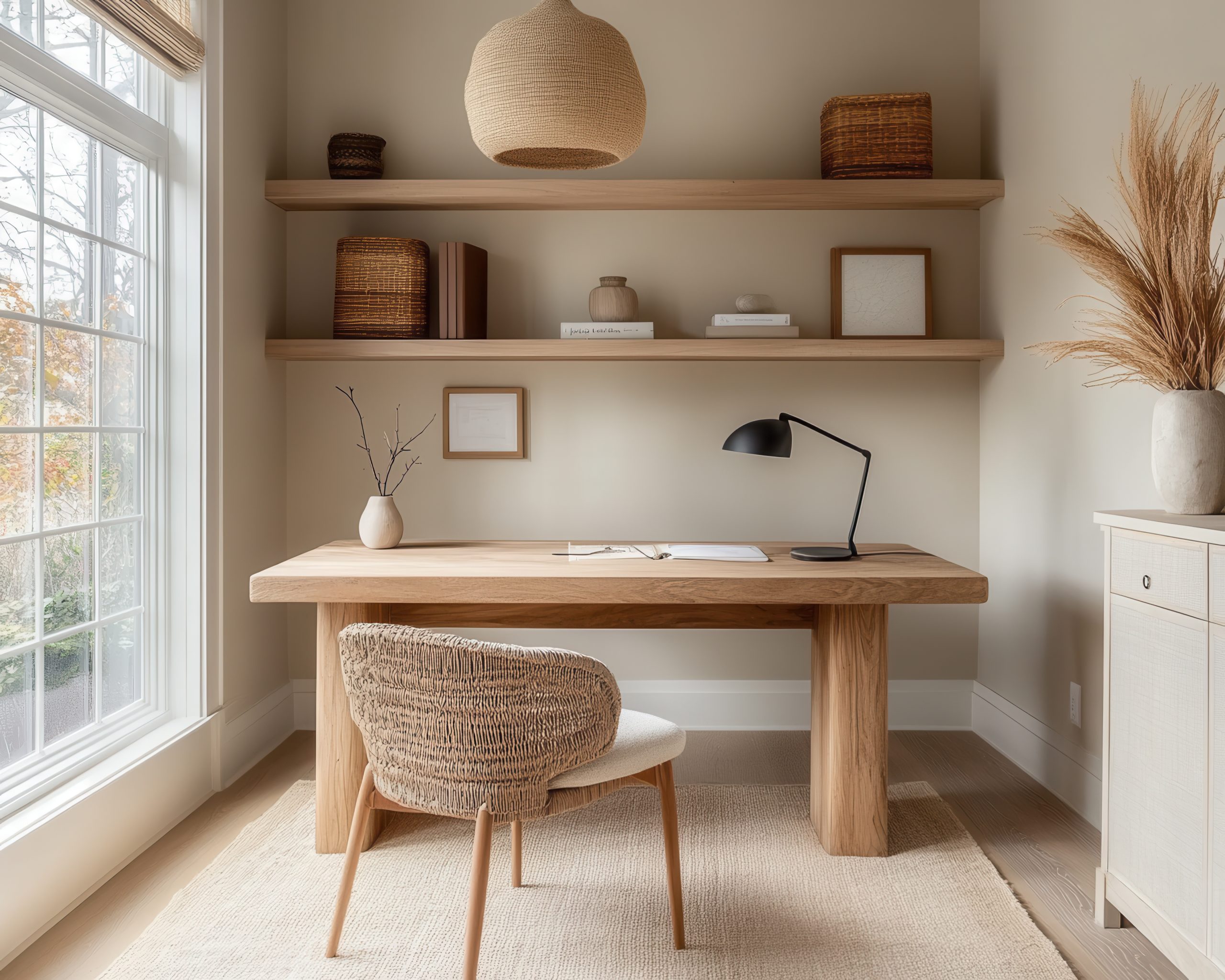
Maintaining a productive atmosphere is an ongoing process that requires attention and adaptation. By implementing these strategies, you can ensure that your productive home office design continues to support your work and well-being.
To wrap things up, a productive home office design is all about creating a space that not only looks great but also supports your work habits and personal style. From choosing the right location and furniture to optimising lighting and incorporating technology, each element plays a crucial role in enhancing your productivity. Remember, your workspace should be a reflection of you—comfortable, inspiring, and efficient.
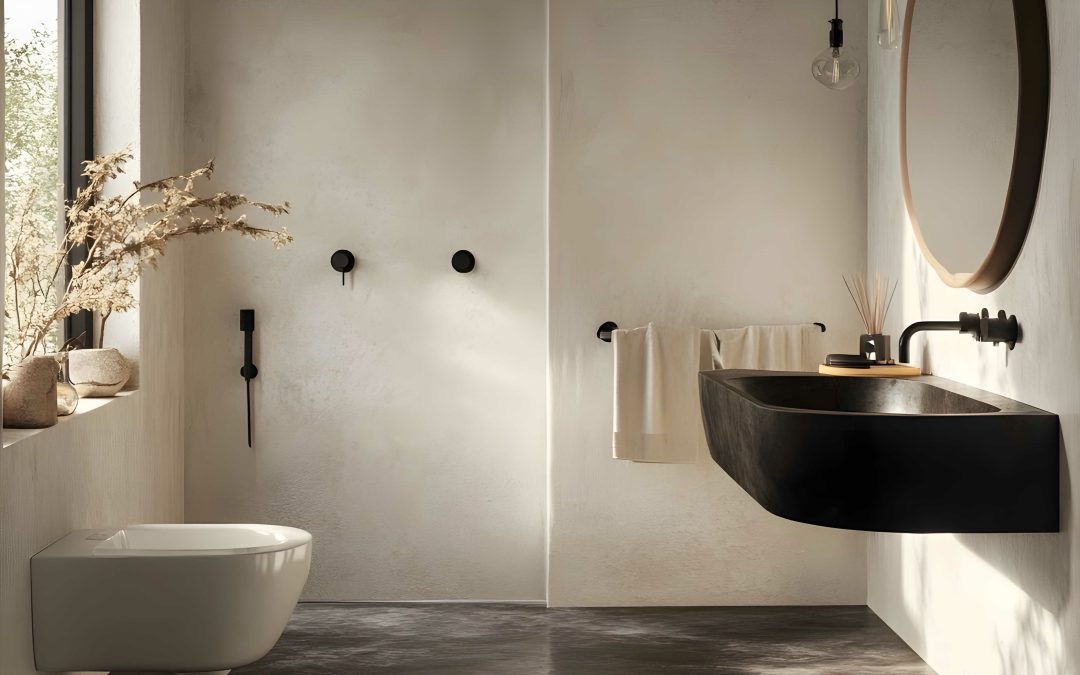
by Kesaa Interiors | Bathrooms, ROOMS
Are you looking for the best small bathroom makeover ideas? Read along to discover 13 tips and tricks!
If you’re like me, you know that small bathrooms can be a bit of a design challenge. But don’t worry, I’ve got some great small bathroom makeover ideas that can really transform your space.
Whether you’re dealing with a cramped layout or just want to refresh the look, these tips will help you make the most of every square inch. Let’s dive in and explore some practical and stylish solutions that can turn your small bathroom into a cosy and functional oasis.

Best Small Bathroom Makeover Ideas!
1. Optimise Vertical Space
One of my favourite small bathroom makeover ideas is to think vertically. When floor space is limited, the walls become your best friend. By utilising vertical space, you can keep your bathroom organised and spacious. Tall shelving units are a great option for storing towels, toiletries, and decorative items. These can be placed in corners or above the toilet to maximise space. Wall-mounted cabinets are another excellent choice, especially when placed above the toilet or sink to keep essentials within reach. Opt for cabinets with mirrored fronts to add functionality and style.
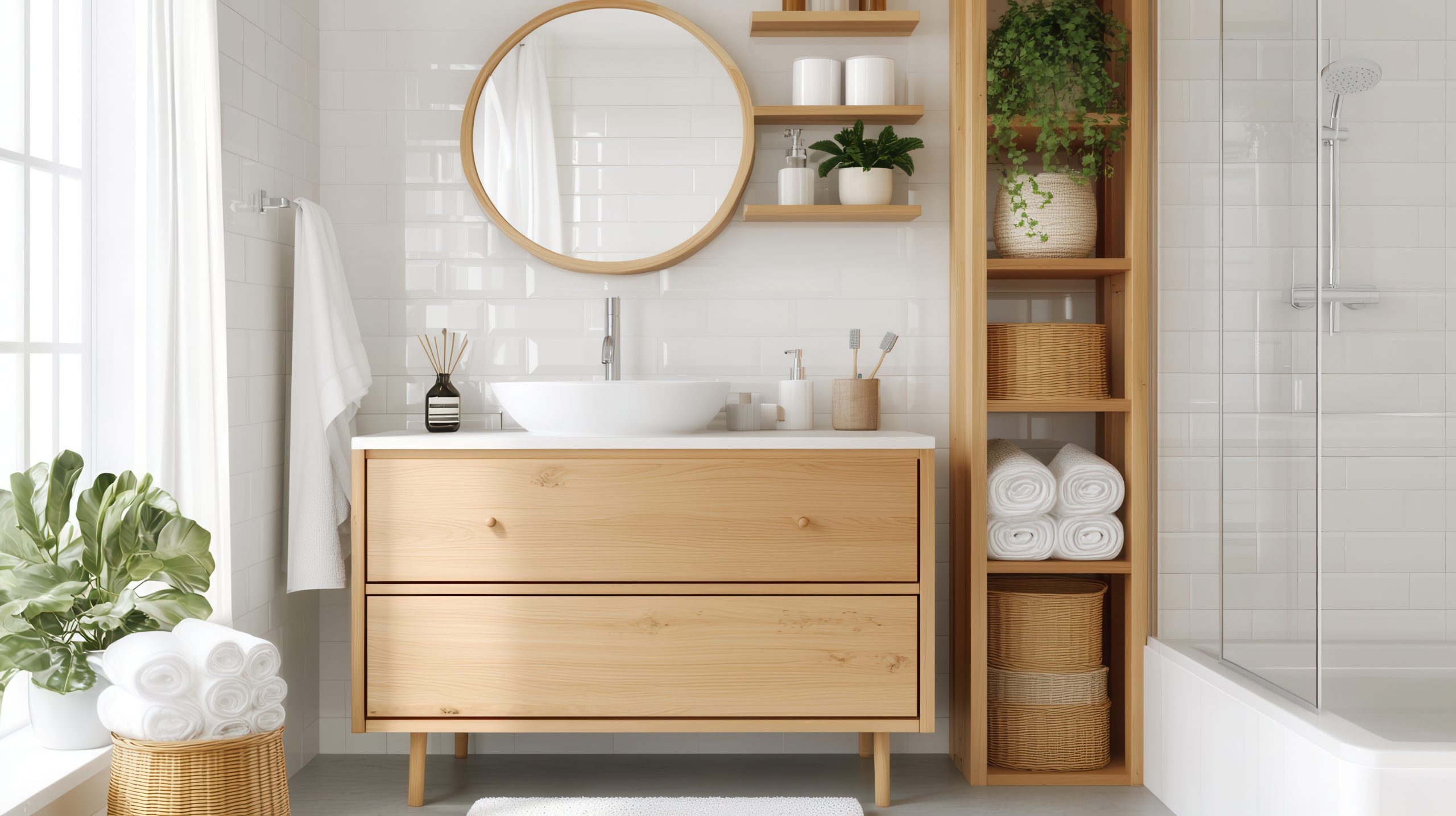
Hooks and racks are perfect for hanging towels, robes, or even baskets for additional storage. Consider using adhesive hooks for a no-drill solution that won’t damage your walls. By looking up and utilising the vertical space, you’ll discover a whole new world of possibilities for your small bathroom. Plus, it gives you a chance to display some cute decor items or plants, adding a touch of personality to the space.
2. Light and Bright Colour Schemes
Alright, let’s talk colour. One of the simplest small bathroom makeover ideas is to go for a light and bright colour scheme. Light colours can really open up a space and make it feel larger than it actually is. Soft whites, pastels, or light greys work wonders in small spaces, reflecting light and creating an airy atmosphere. These shades can make your bathroom feel fresh and inviting, like a little retreat.
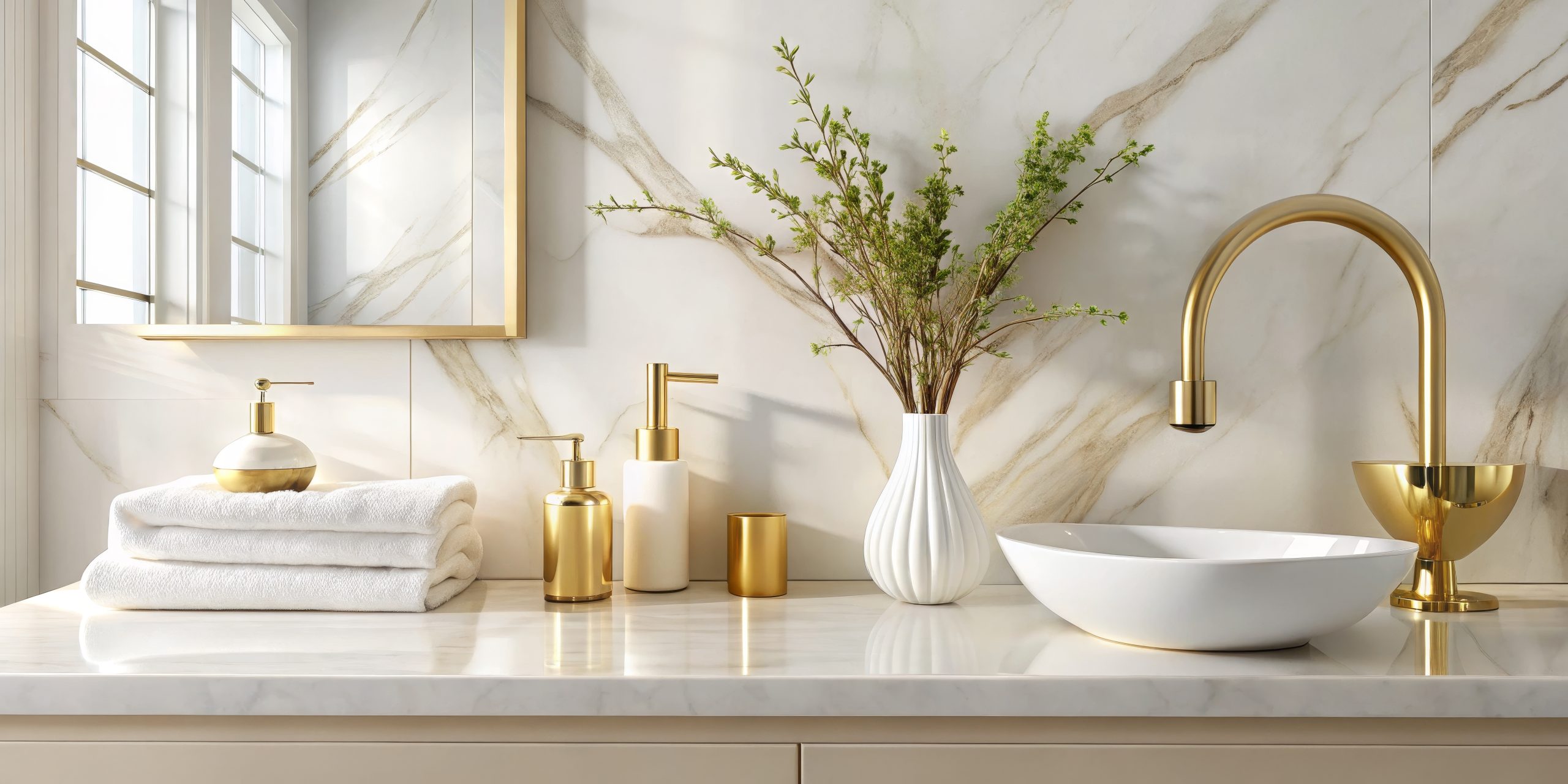
To add some personality without overwhelming the space, consider incorporating accent colours through accessories like towels, rugs, or shower curtains. Reflective surfaces, such as glossy finishes on tiles or paint, can further enhance the brightness and openness of the room. By carefully selecting your colour palette, you can create a cohesive and visually appealing space that feels much larger than it is.
3. Mirrors to Create an Illusion of Space
Now, mirrors are a game-changer when it comes to small bathroom makeover ideas. A well-placed mirror can do wonders by reflecting light and creating the illusion of more space. Consider placing a large mirror above the sink to double the visual space. Mirrored cabinets are also a great option, providing storage while enhancing the room’s depth. Decorative mirrors in different shapes and styles can add personality and serve as a focal point.
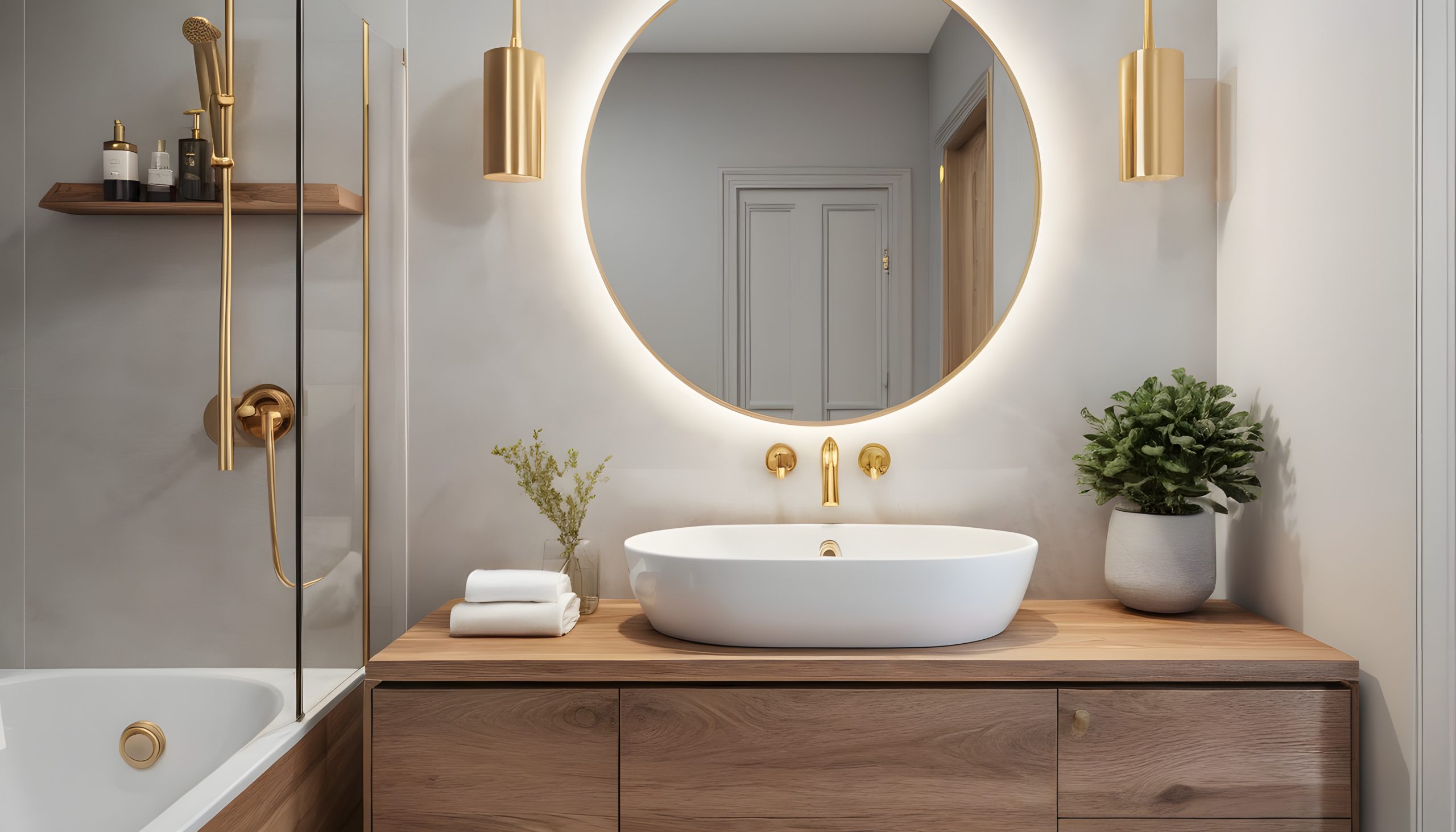
Mirrors not only make your bathroom feel larger, but also add a touch of elegance and sophistication. They can reflect natural light, brightening up the space and making it feel more open. By strategically placing mirrors, you can create a sense of depth and dimension, transforming your small bathroom into a more spacious and inviting area.
4. Compact and Multifunctional Fixtures
When space is tight, every inch counts. That’s why compact and multifunctional fixtures are key in small bathroom makeover ideas. Look for sinks, toilets, and bathtubs that are designed to save space. Compact sinks and toilets can free up valuable floor space, making the room feel less cramped. Vanities with built-in storage are a lifesaver, keeping your bathroom clutter-free and organised.
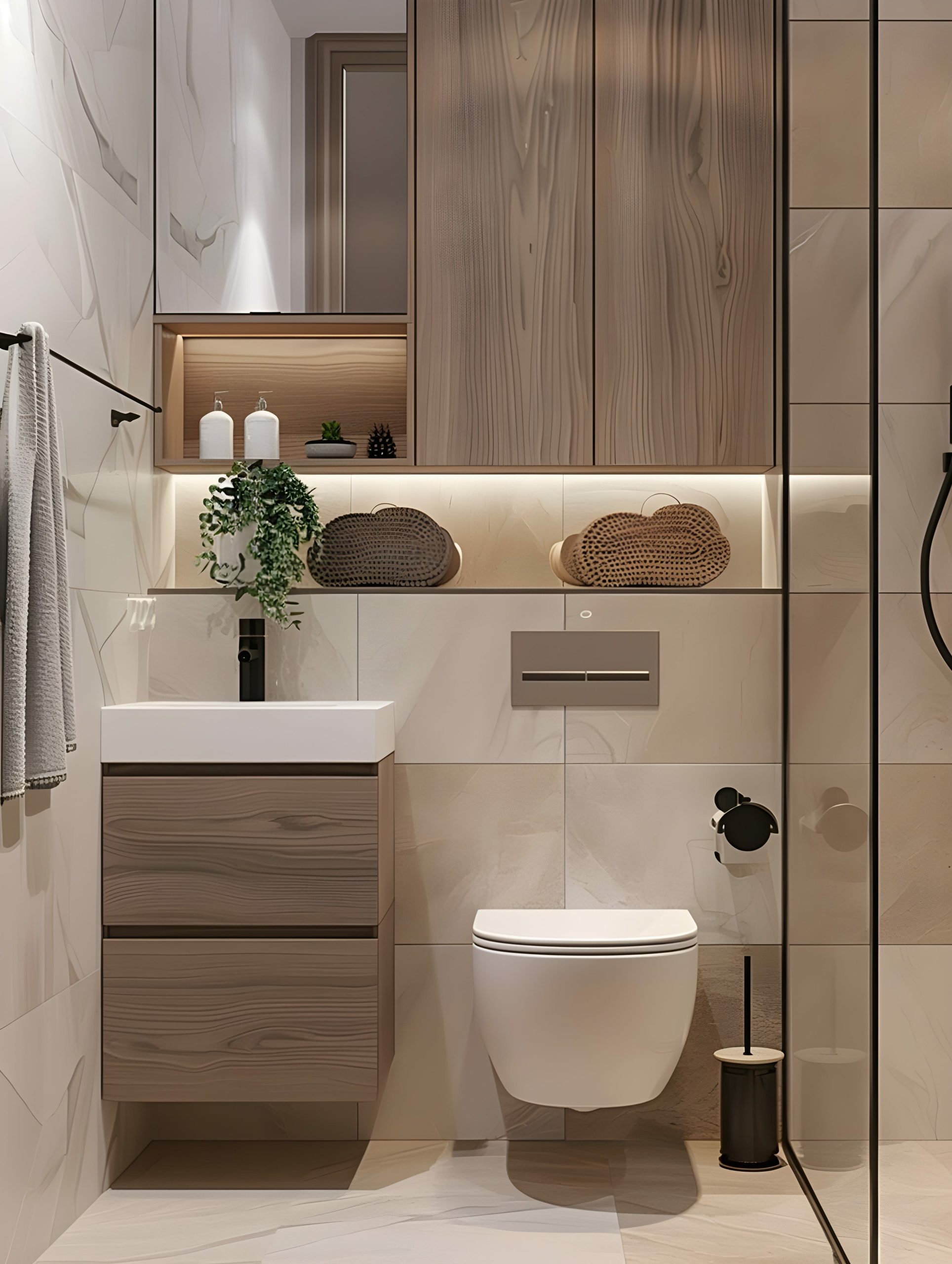
Consider utilising corners for sinks or storage to maximise space. Corner fixtures can be a great solution for awkward layouts, allowing you to make the most of every inch. By choosing fixtures that serve multiple purposes without sacrificing style, you’ll be amazed at how much more functional your bathroom can become. It’s all about finding the right balance between form and function.
5. Sliding Doors for Space Efficiency
If you’re dealing with a door that swings into your already small bathroom, consider switching to a sliding door. It’s one of those small bathroom makeover ideas that can make a big difference. Sliding doors save space by eliminating the need for door clearance, allowing you to use the area more efficiently. They also add a sleek, modern touch to your bathroom, enhancing its overall aesthetic.
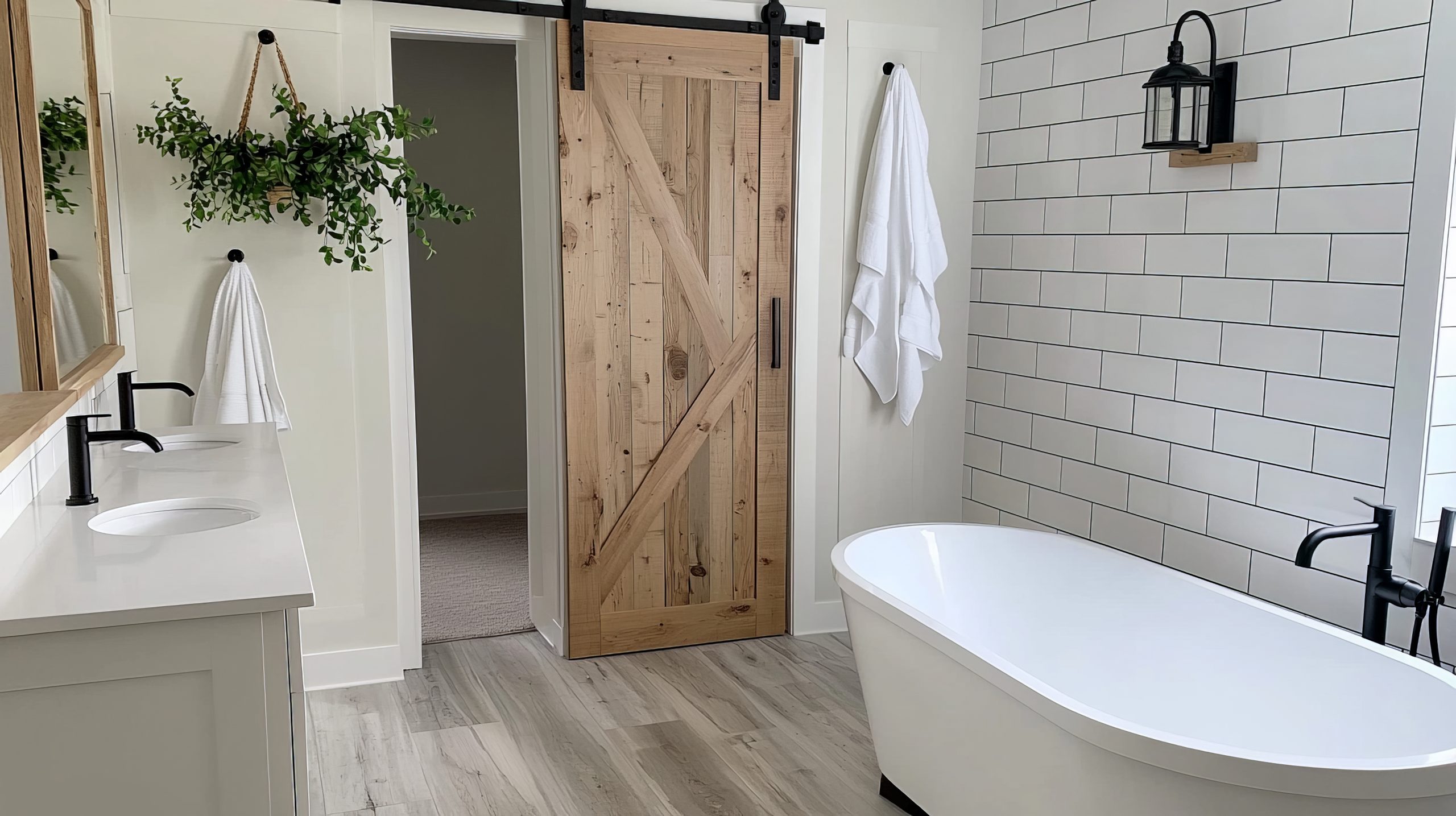
There are various design options to choose from, such as barn doors, pocket doors, or glass sliders. Each style offers its own unique charm and can complement your bathroom’s decor. Sliding doors not only improve space efficiency but also add a touch of flair to your design. It’s a practical solution that opens up the room and makes it feel less cramped.
6. Clever Storage Solutions
Let’s face it, storage is always a challenge in small bathrooms. But with some clever small bathroom makeover ideas, you can keep everything organised and within reach. Recessed shelves built into walls are a great way to save space and store toiletries. Built-in niches in the shower provide convenient storage without the need for bulky caddies.
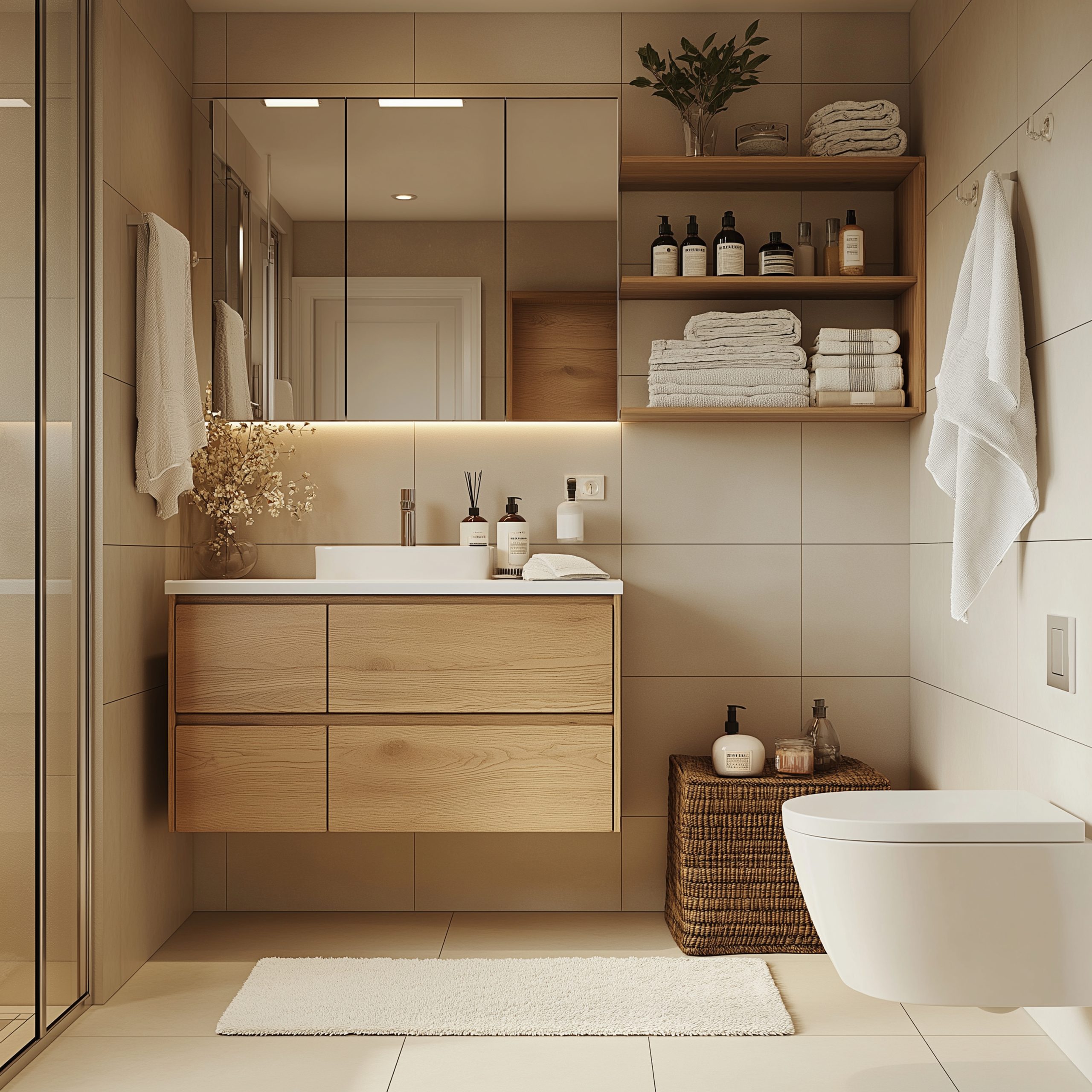
Baskets and organisers can help keep items tidy and accessible. Consider using stackable bins or drawer organisers to maximise storage space. The goal is to have a place for everything, so your bathroom feels calm and clutter-free. By implementing these storage solutions, you can create a more functional and efficient space that meets your needs.
7. Use Glass and Transparent Materials
Incorporating glass and transparent materials is another fantastic small bathroom makeover idea. Glass shower doors, for instance, can make the room feel more open compared to a traditional shower curtain. They allow light to flow freely, enhancing the overall sense of space and airiness in your bathroom. Glass shelves can add a modern touch without crowding the space, providing a sleek and stylish storage solution.

Transparent accessories, such as clear containers or acrylic organisers, can create a seamless look and keep your bathroom looking tidy. These materials not only enhance the visual appeal of your bathroom but also contribute to a more open and inviting atmosphere. By using glass and transparent materials, you can create a sense of continuity and flow, making your small bathroom feel larger and more cohesive.
8. Statement Lighting Fixtures
Lighting can completely transform a space, and that’s especially true in small bathrooms. One of my favourite small bathroom makeover ideas is to incorporate statement lighting fixtures. Pendant lights hung above the vanity can add a chic and stylish touch, while wall sconces on either side of the mirror provide balanced lighting. LED strips under cabinets or around mirrors can create ambient light, enhancing the overall atmosphere.
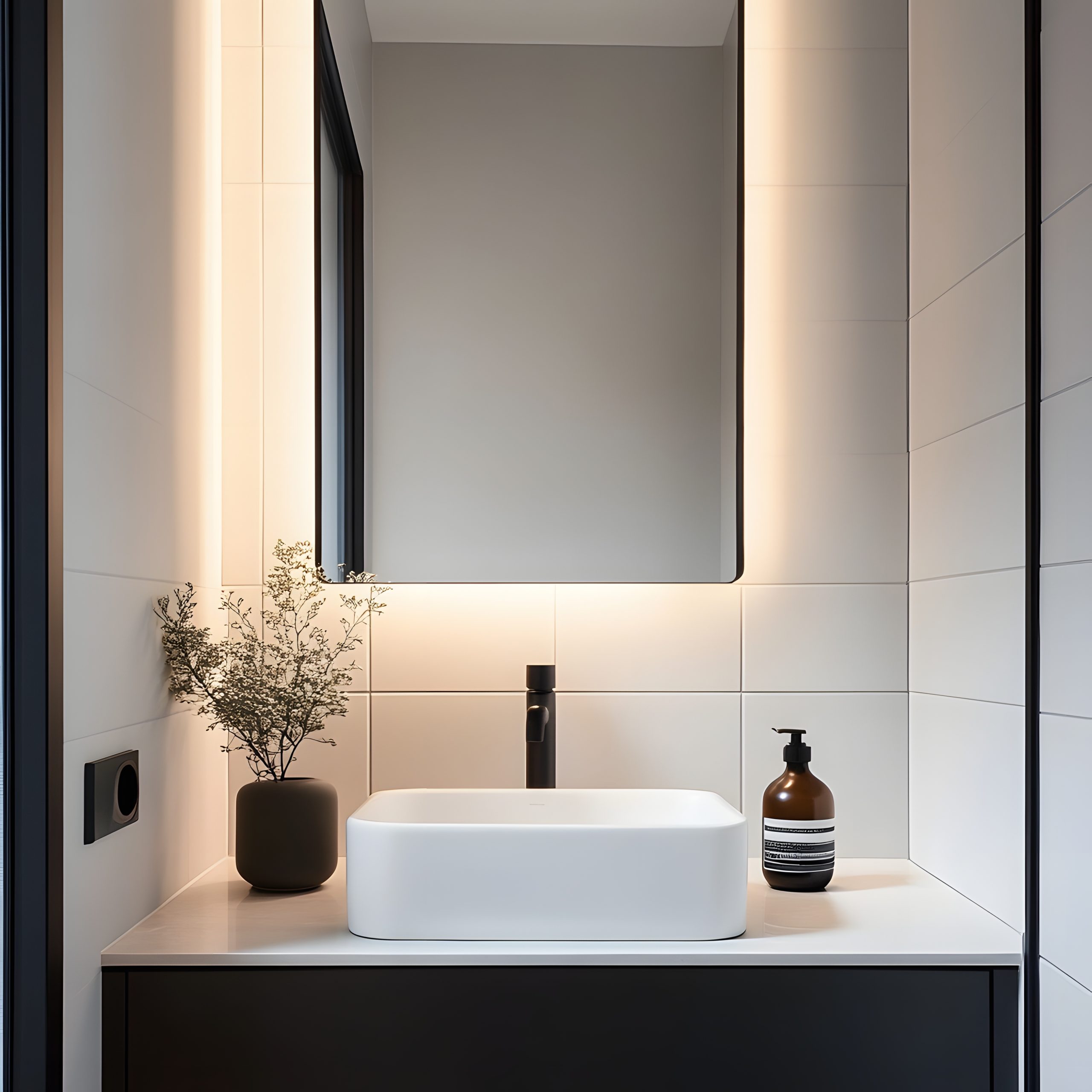
The right lighting can add both function and flair, brightening up the room and serving as a focal point. It not only illuminates the space but also adds a touch of elegance and sophistication. By choosing unique and eye-catching lighting fixtures, you can elevate the design of your bathroom and create a more inviting and visually appealing space.
9. Incorporate Natural Elements
Bringing in natural elements is a great way to add warmth and texture to your small bathroom. Consider adding low-maintenance plants like ferns or snake plants, which thrive in humid environments. These little touches of greenery can make the space feel more inviting and fresh, creating a calming and relaxing atmosphere.
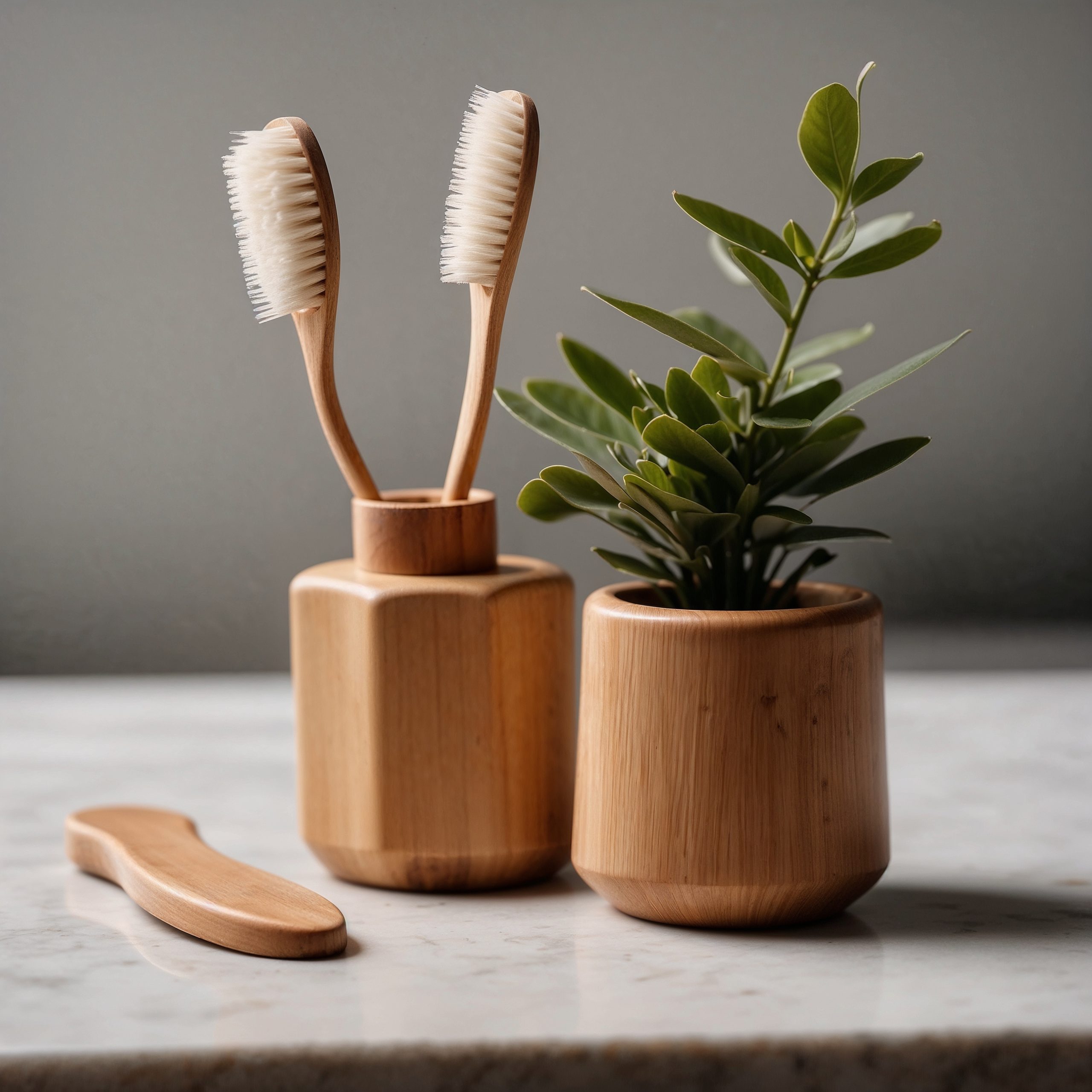
Incorporating natural materials, such as wood or stone, can add an organic and earthy feel to your bathroom. Use wooden accessories, like soap dishes or toothbrush holders, to add warmth and texture. Woven baskets can also provide additional storage while adding a rustic touch. By incorporating natural elements, you can create a more harmonious and balanced space that feels connected to nature.
10. Creative Use of Tiles
Tiles are a fantastic way to add character and style to your small bathroom. One of the best small bathroom makeover ideas is to get creative with tile patterns and textures. Consider using tiles to create a focal point, like an accent wall or a striking backsplash. You can play with different shapes, such as hexagons or subway tiles, to add visual interest.
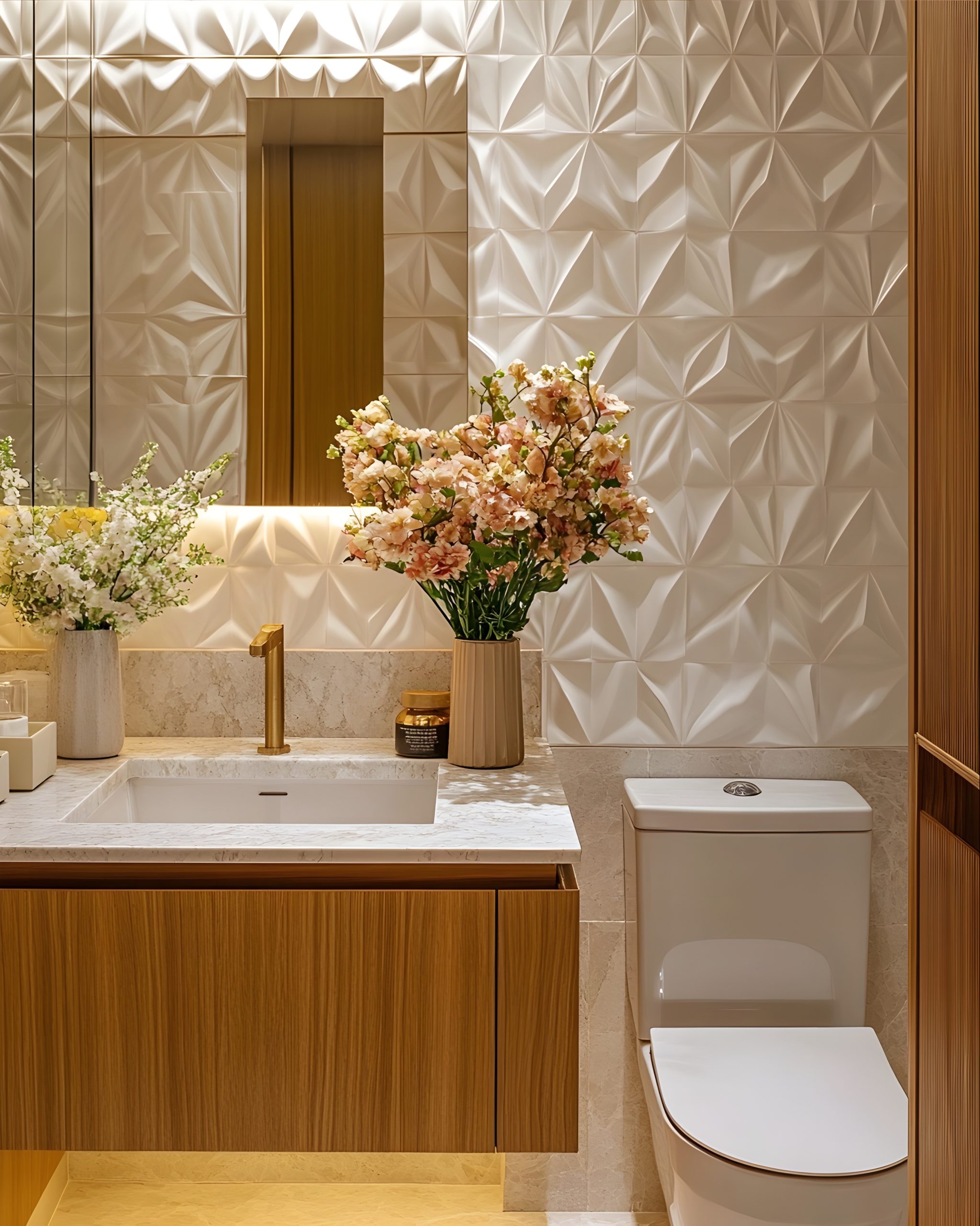
Experiment with geometric or mosaic patterns to create a unique and personalised look. Textured tiles can add depth and dimension, making your bathroom feel more dynamic and visually appealing. The right tile design can make your bathroom feel unique and personalised, while also being practical and easy to clean. By getting creative with tiles, you can transform your small bathroom into a stylish and inviting space.
11. Minimalist Design Approach
When it comes to small spaces, less is often more. Adopting a minimalist design approach is one of the most effective small bathroom makeover ideas. Focus on decluttering and keeping only the essentials. Choose fixtures and decor with clean lines and simple forms to create a sense of openness and simplicity.
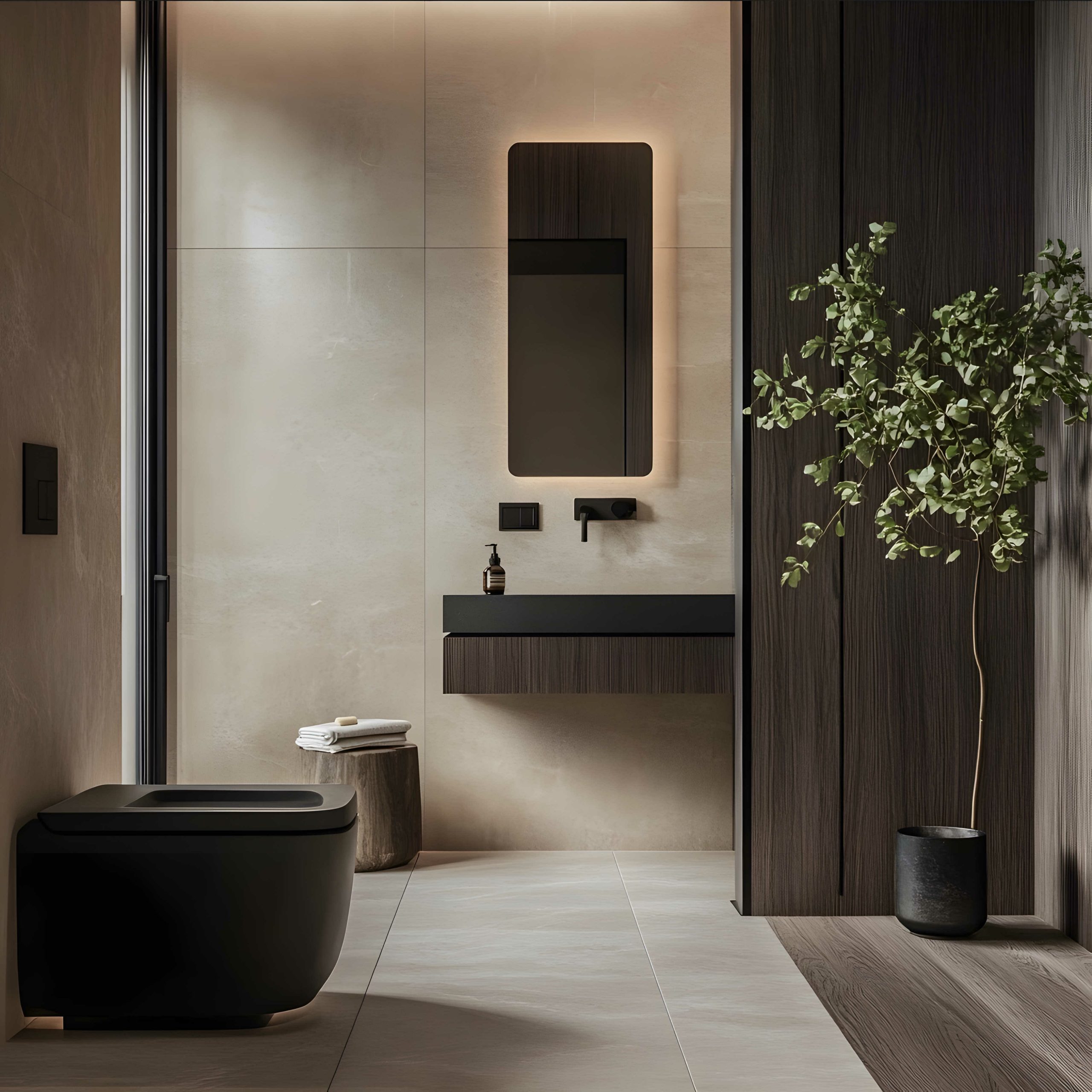
Stick to a neutral colour palette for a cohesive and serene look. This approach not only makes the space feel larger but also creates a calming and peaceful environment. By eliminating unnecessary distractions and focusing on the essentials, you can create a bathroom that feels open and airy, providing a sense of tranquillity and relaxation.
12. Add Personal Touches
Even in a small bathroom, there’s room for personal touches that reflect your style. Consider adding artwork, decorative items, or even a unique shower curtain that speaks to your personality. These small bathroom makeover ideas allow you to infuse the space with your own flair without overwhelming it.
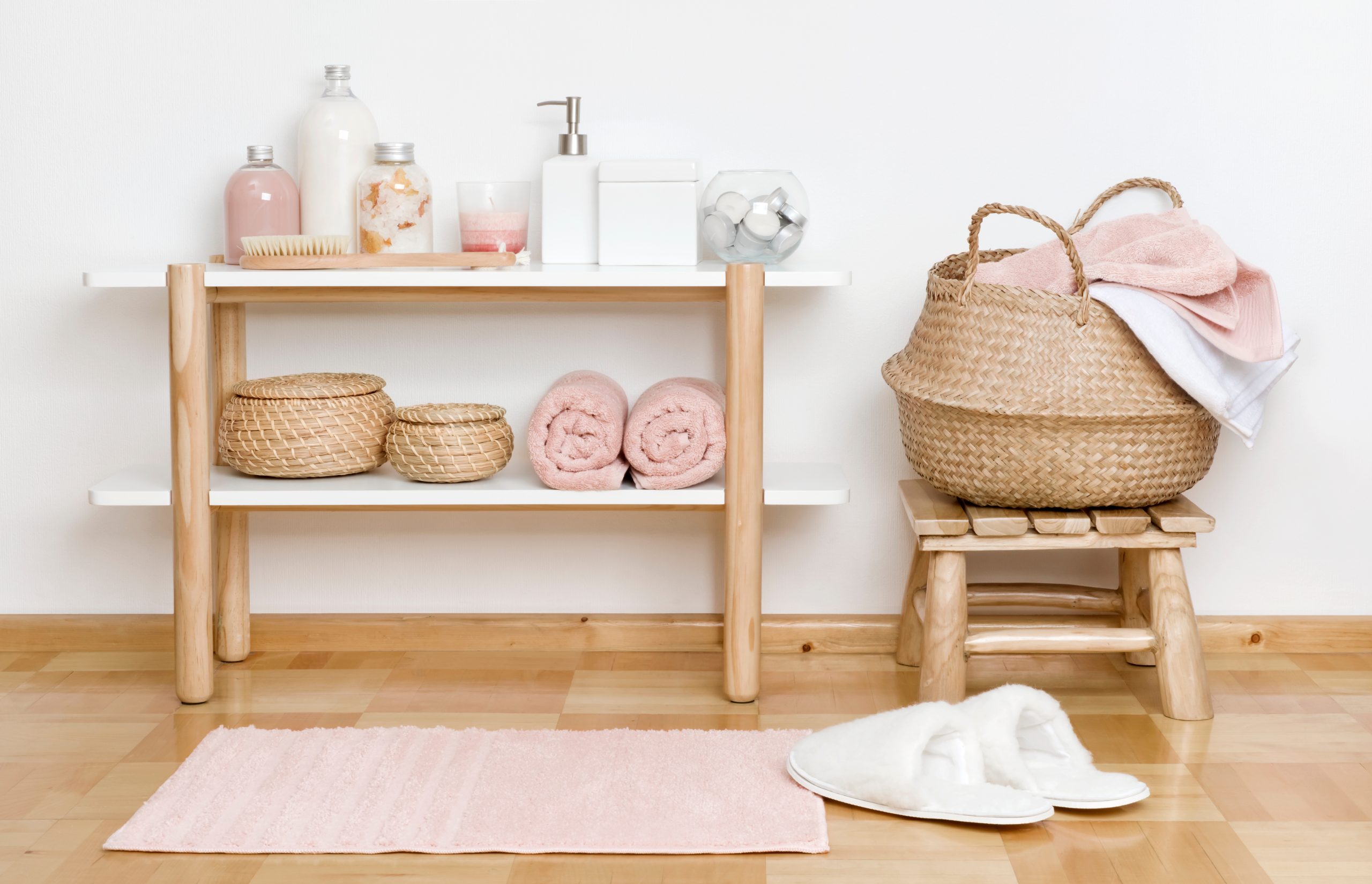
Choose a few well-chosen pieces that add character and charm to your bathroom. Whether it’s a piece of art that you love or a decorative item that holds sentimental value, these personal touches can make your bathroom feel uniquely yours. By adding elements that reflect your personality, you can create a space that feels warm and inviting.
13. Smart Technology Integration
Finally, let’s talk about integrating smart technology into your small bathroom. This is one of those small bathroom makeover ideas that can really enhance convenience and efficiency. Consider automated lighting with motion sensors for hands-free operation. Smart mirrors with built-in lighting and defogging features can add a touch of luxury and modernity.
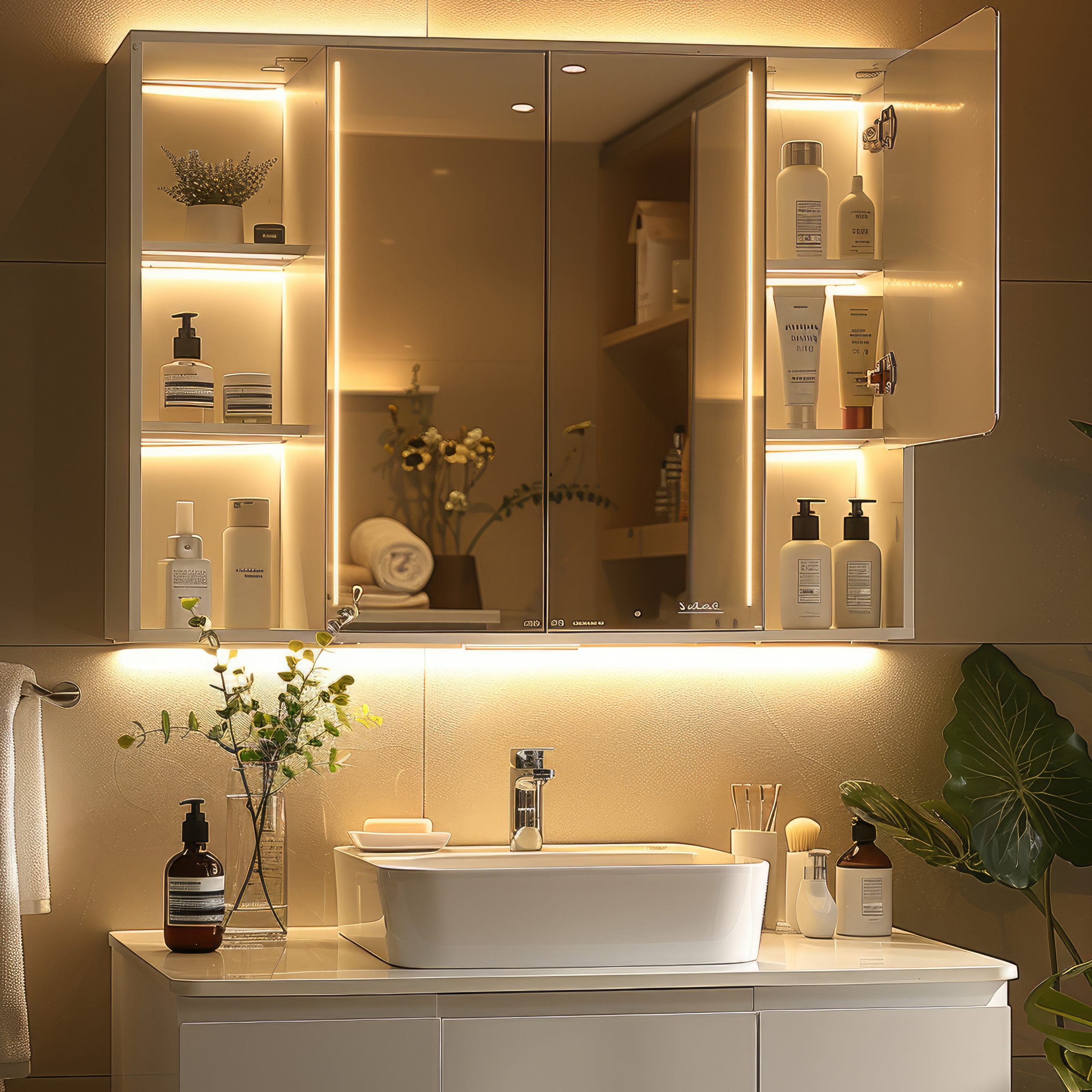
Bluetooth speakers can provide entertainment while you shower, making your bathroom experience more enjoyable. These tech-savvy additions can make your bathroom more functional and efficient, all while saving space and adding a touch of luxury. By incorporating smart technology, you can create a modern and innovative bathroom that meets your needs.
Incorporating these small bathroom makeover ideas can truly transform your space, making it both functional and stylish. Don’t be afraid to experiment and personalise your bathroom to reflect your unique taste and needs.
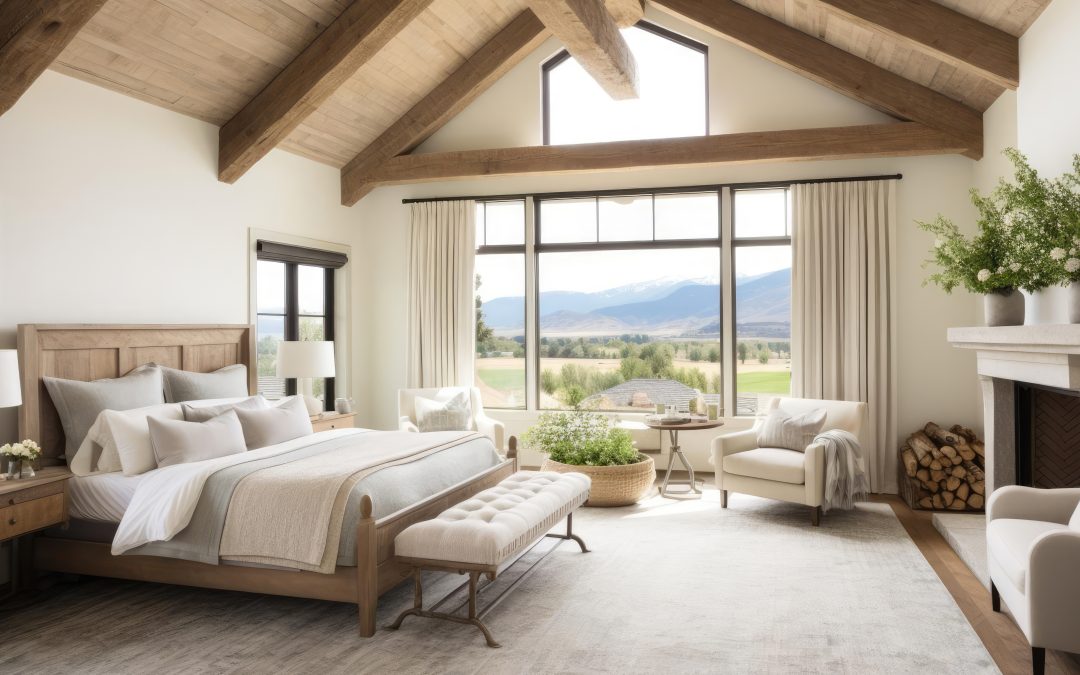
by Kesaa Interiors | Bedrooms, ROOMS
Looking for simple bedroom ideas for relaxation? Then you are in the right place for the best tips and tricks!
In our busy world, having a spot where you can unwind and recharge is super important. Your bedroom should be that place — a place where you can escape the daily grind and find some peace. The good news is, you don’t need to do a complete makeover or spend a ton of money to create a calming environment.
With just a few simple tweaks, you can turn your bedroom into a personal retreat that’s all about tranquillity and stress relief. Let’s dive into some practical and effective ways to enhance your bedroom’s vibe, making it the perfect place to kick back and rejuvenate.
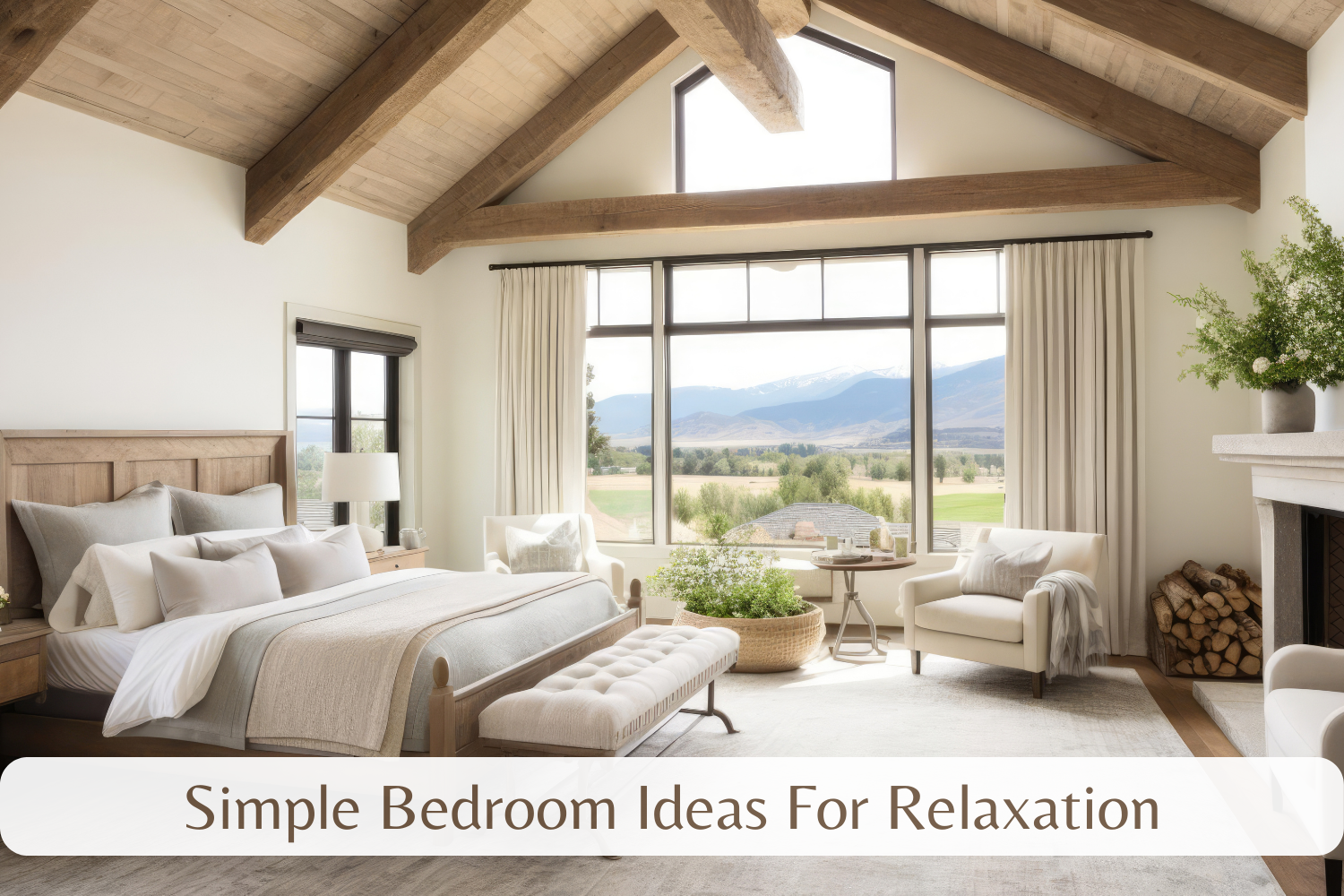
Best Simple Bedroom Ideas For Relaxation!
1. Declutter for Calmness
One of the easiest ways to make your bedroom a more relaxing space is to start by decluttering. It’s amazing how much stress can come from having too much stuff around. When things are messy, it can make you feel overwhelmed and anxious. But when you tidy up and organise, it creates this wonderful sense of calm and order that’s just perfect for relaxation.
So, take a good look around your bedroom and see what you can let go of. If there are things you don’t use or need anymore, think about donating or recycling them. It’s all about freeing up space. And when it comes to organising, focus on your closets and drawers. Make sure everything has its spot. Not only will your room look neater, but it’ll also be easier to keep it that way.
For a versatile and chic addition, add something like this blanket box that not only provides extra storage but also complements your bedroom’s style. Creating a space that feels open and welcoming will help you breathe easier and truly relax.
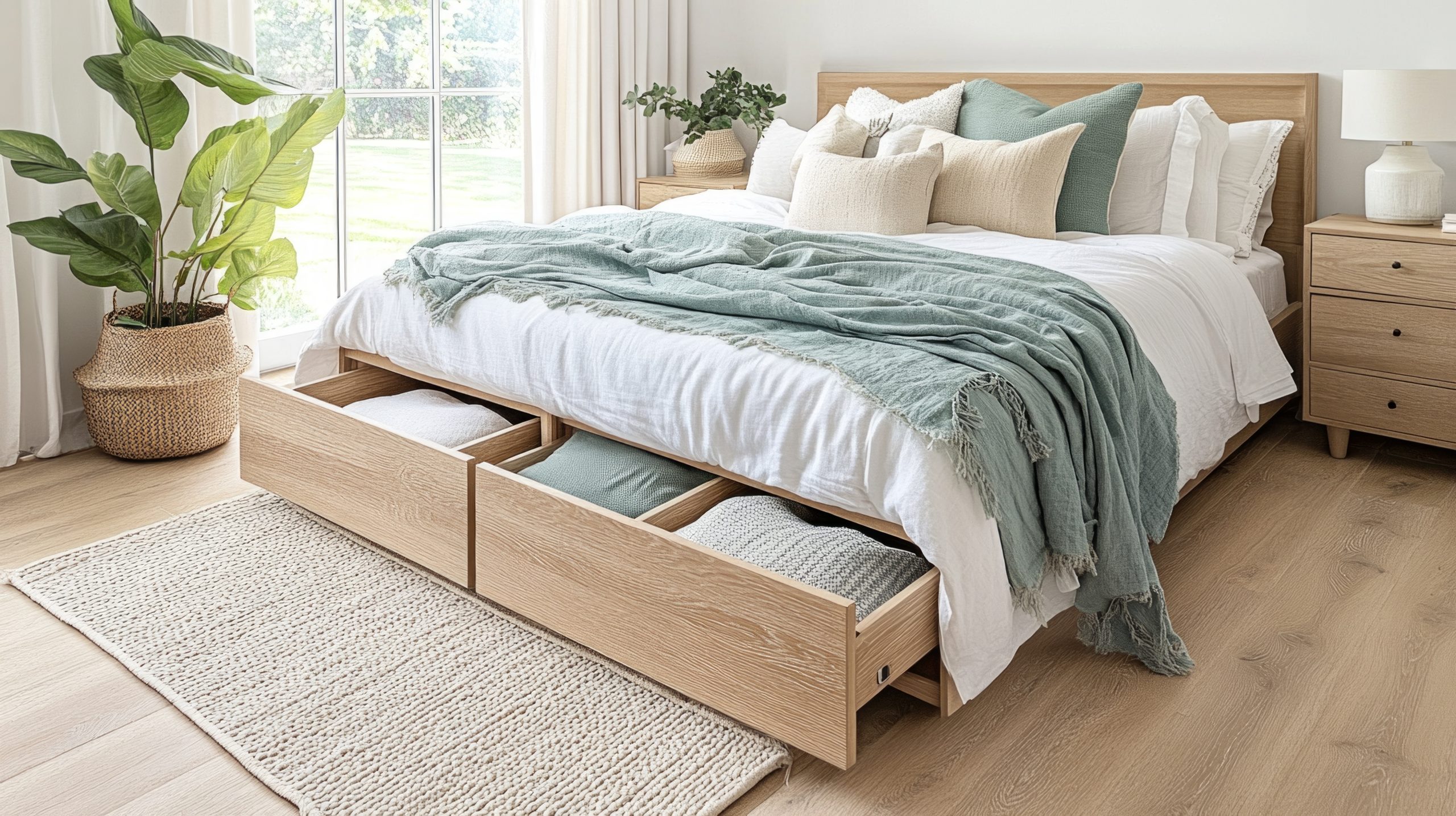
By taking the time to declutter, you’re laying the groundwork for a more peaceful and relaxing bedroom. It’s a simple step, but it can make a big difference in how well you can unwind and enjoy your personal sanctuary.
2. Choose Soothing Colours
Colour is such a game-changer when it comes to setting the mood in your bedroom. It affects how we feel, so picking the right colours is key to creating a relaxing vibe. One of the simplest ways to make your bedroom more calming is to bring in some soothing colours.
Think about using shades that naturally make you feel at ease. Soft blues, gentle greens, and neutrals like beige and grey are fantastic choices. They’re reminiscent of nature and can help create a peaceful atmosphere. Imagine a light blue that feels like a clear sky or a calm sea, or a soft green that reminds you of a lush forest—those colours can transform your space.
If painting the walls feels like too big of a commitment, you can still bring these colours in through your bedding, curtains, or even some accent pieces. A duvet cover in a calming shade or some soft-coloured curtains can make a big difference without needing to redo the whole room. And don’t forget about decor elements like throw pillows, rugs, or artwork to pull everything together.
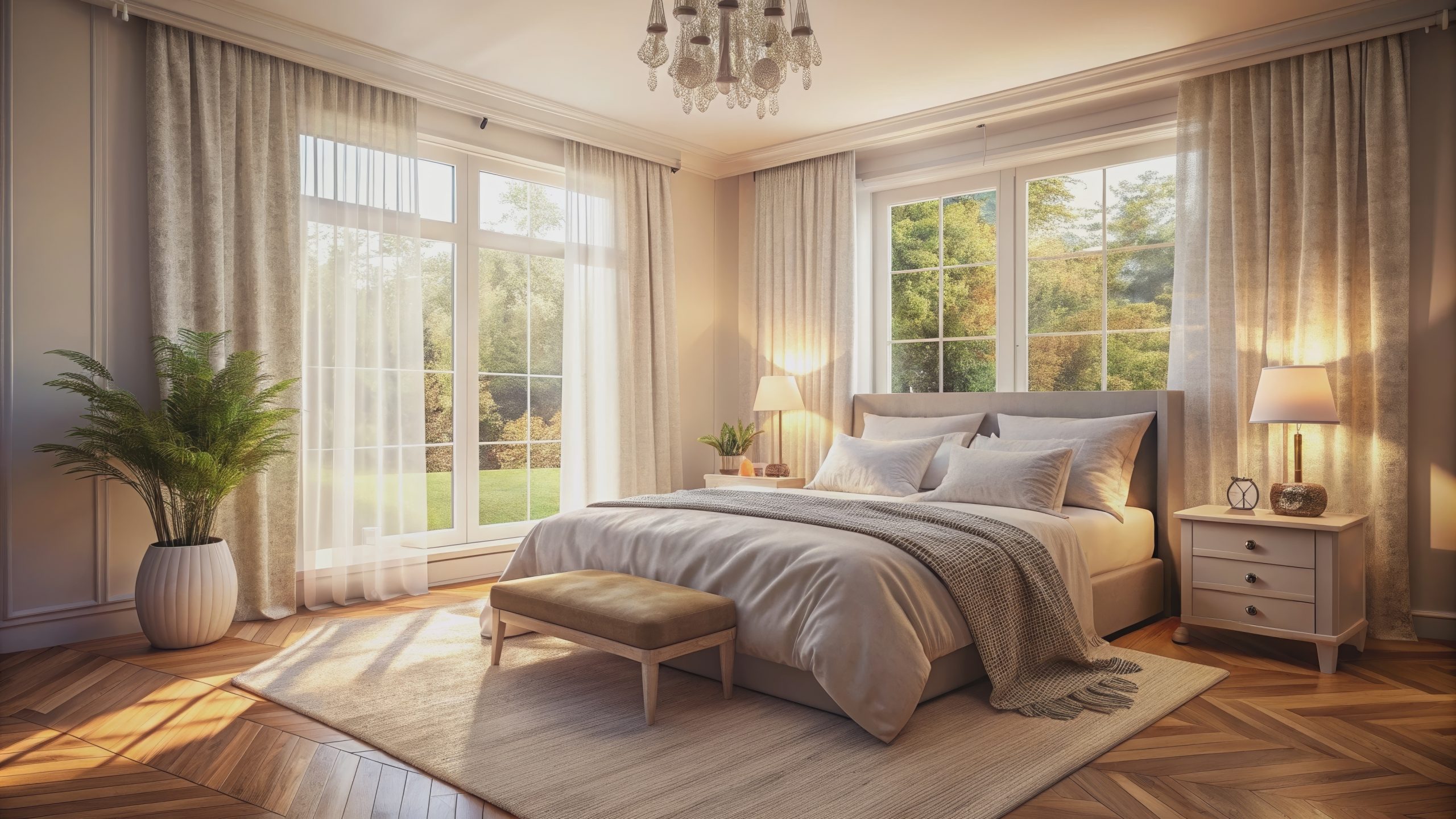
By choosing the right colours, you’re setting up a harmonious and inviting space that’s perfect for unwinding. It’s a simple change, but it can make your bedroom a much more enjoyable place to relax at the end of the day.
3. Optimise Lighting
Lighting sets the mood in any room, and your bedroom is no different. If you’re looking to make your space more relaxing, tweaking the lighting can have a huge impact.
First off, let’s talk about natural light. During the day, you want to let in as much of it as possible. It not only makes your bedroom look great but also boosts your mood and helps regulate your sleep cycle. Sheer curtains are a great option because they let sunlight filter through while still giving you some privacy. And if your room doesn’t get much natural light, try using mirrors to bounce light around and make the space feel brighter and more open.
When evening rolls around, it’s all about creating a warm and cosy vibe with artificial lighting. Dimmable lights are fantastic because you can adjust the brightness to suit your mood. Go for warm-toned bulbs, like soft white or amber, to help create a relaxing environment that’s perfect for winding down. Mixing different lighting sources—like bedside lamps, floor lamps, and wall sconces—can add layers and depth to your room’s lighting.
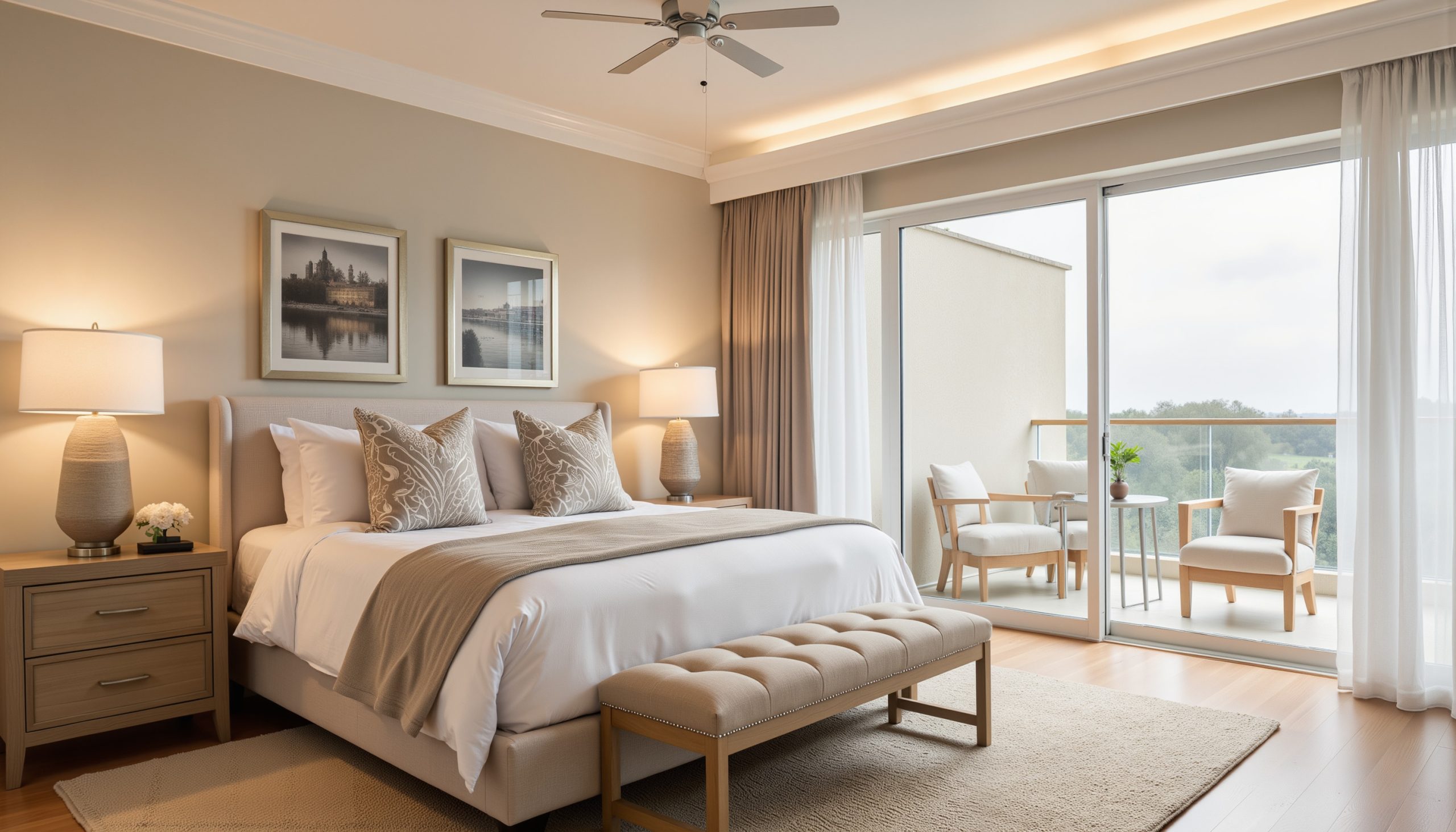
By optimising your bedroom lighting, you can enhance the room’s ambience and make it a more inviting place to relax. This simple change can help you create a space that supports relaxation and stress relief, setting the stage for a restful night’s sleep.
4. Incorporate Natural Elements
Bringing a bit of nature into your bedroom is a fantastic way to make it more relaxing and serene. It’s one of those simple tricks that can really make a difference—not only does it improve air quality, but it also boosts your mood and creates a peaceful vibe.
Start with some houseplants. Think about adding peace lilies, snake plants, or lavender. They’re great because they purify the air and add a soothing touch of greenery. Plus, they’re pretty easy to care for and do well indoors. If you’re short on space, hanging planters or small succulents on a windowsill or bedside table can work wonders.
Besides plants, try incorporating natural materials into your decor. Wooden furniture, bamboo blinds, or a jute rug can add warmth and texture to your room. These materials have an organic feel that makes your space feel more grounded and connected to nature. You might also want to use natural fabrics like cotton or linen for your bedding and curtains to up the comfort and relaxation factor.
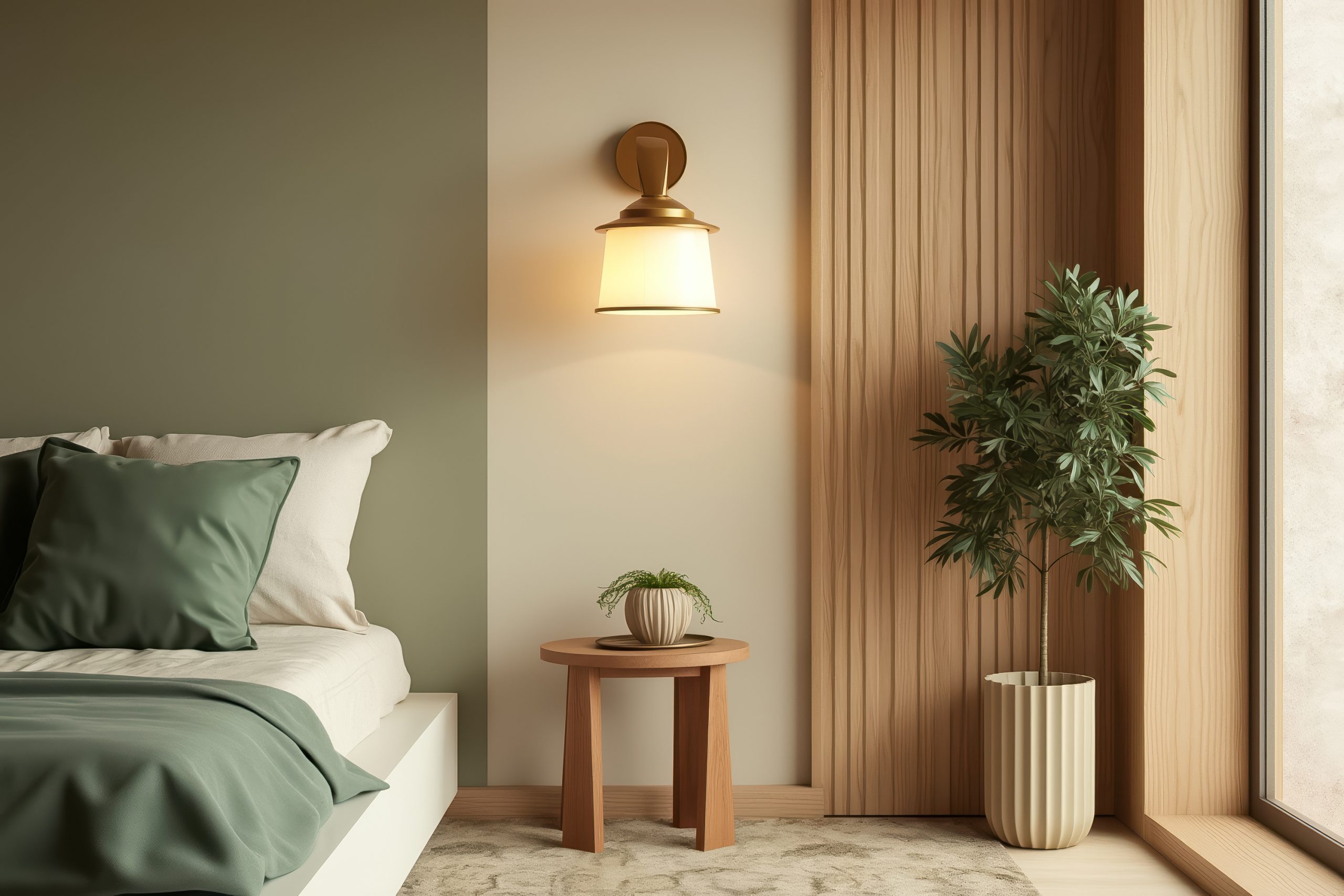
By weaving natural elements into your bedroom, you’re setting up a calming environment that’s perfect for relaxation and well-being. It’s a simple yet effective way to turn your bedroom into a peaceful retreat where you can truly unwind and recharge.
5. Invest in Comfortable Bedding
The quality of your bedding is super important when it comes to getting a good night’s sleep. It’s one of those practical things that can make a difference in how relaxed and comfortable you feel.
First off, let’s talk about your mattress. You want to pick one that matches your sleeping style and gives you the right support. Whether you like it firm or plush, make sure it supports your body and helps you maintain a healthy sleep posture. If getting a new mattress isn’t in the cards right now, a mattress topper can add some extra comfort.
Then, there’s the matter of pillows. You want ones that support your neck and head based on how you sleep. Memory foam, down, and latex are all great options, each offering different levels of support and comfort. And remember, pillows need to be replaced regularly to keep them effective and hygienic.
When it comes to sheets and blankets, go for high-quality, breathable fabrics like cotton, linen, or bamboo. They’re soft, durable, and help regulate your body temperature, so you stay comfy all night long. Layering with a cosy duvet or quilt can add warmth and texture, making your bed even more inviting.
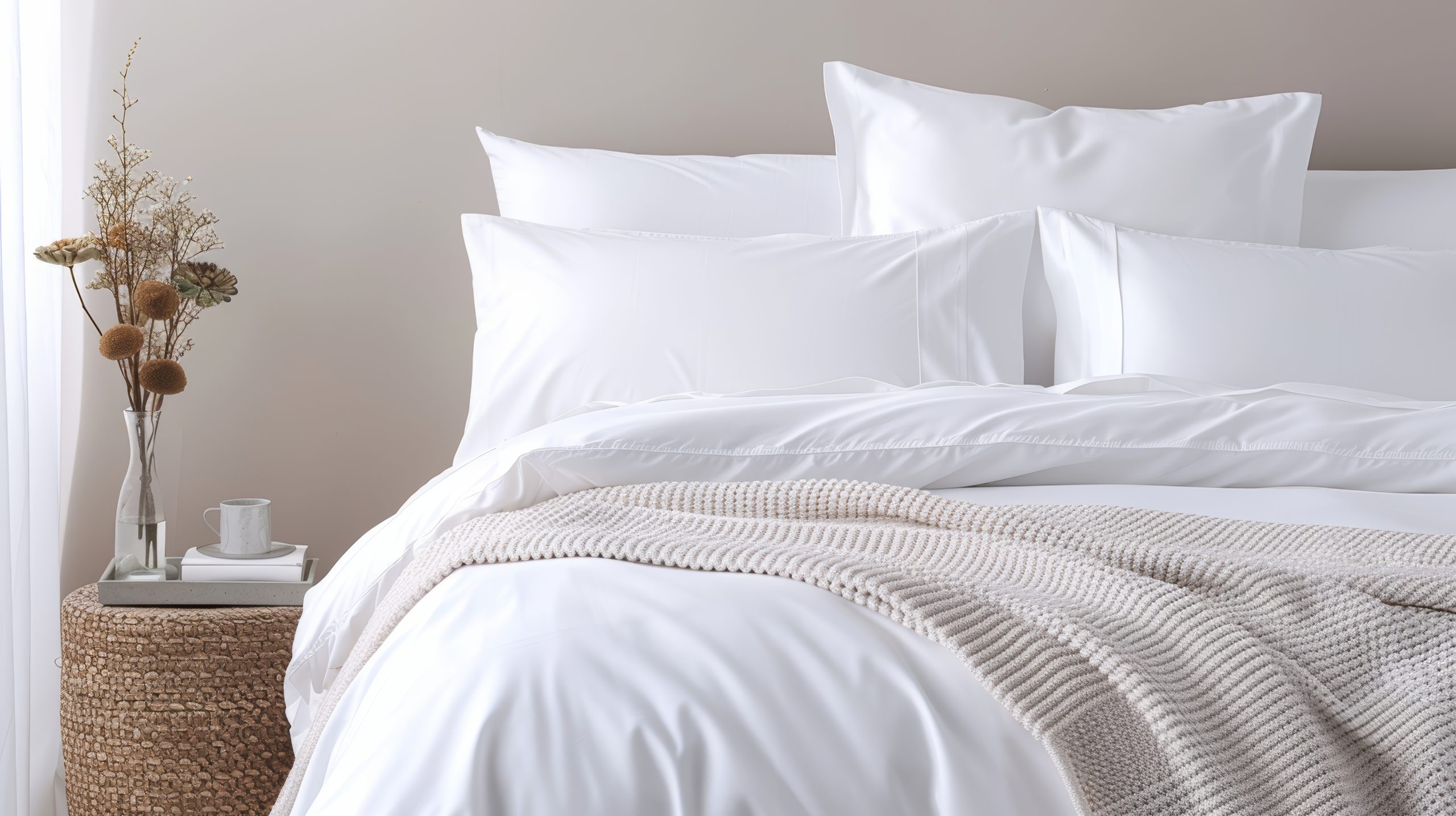
By investing in comfortable bedding, you’re setting up a cosy and inviting sleep environment that encourages relaxation and rejuvenation. It’s a simple change, but it can boost your bedroom’s ambience and improve your overall sleep quality.
6. Create a Personal Zen Corner
Creating a little Zen corner in your bedroom is a fantastic way to carve out a space just for relaxation and mindfulness. It’s one of those personal touches that can make your room feel like your own sanctuary.
Start by picking a quiet corner in your bedroom that you can turn into a peaceful retreat. You want this spot to be free from distractions and clutter, so it feels calm and focused. Think about adding a comfy chair or a floor cushion where you can sit and unwind. If you have the space, a small table or shelf can hold non-stimulating items.
Make this zen corner your own by adding things that promote tranquillity and mindfulness. Maybe a small indoor fountain for some soothing water sounds, a collection of your favourite books, or a journal for reflection. You could also include a meditation cushion, a yoga mat, or a cosy throw blanket to make it even more inviting.
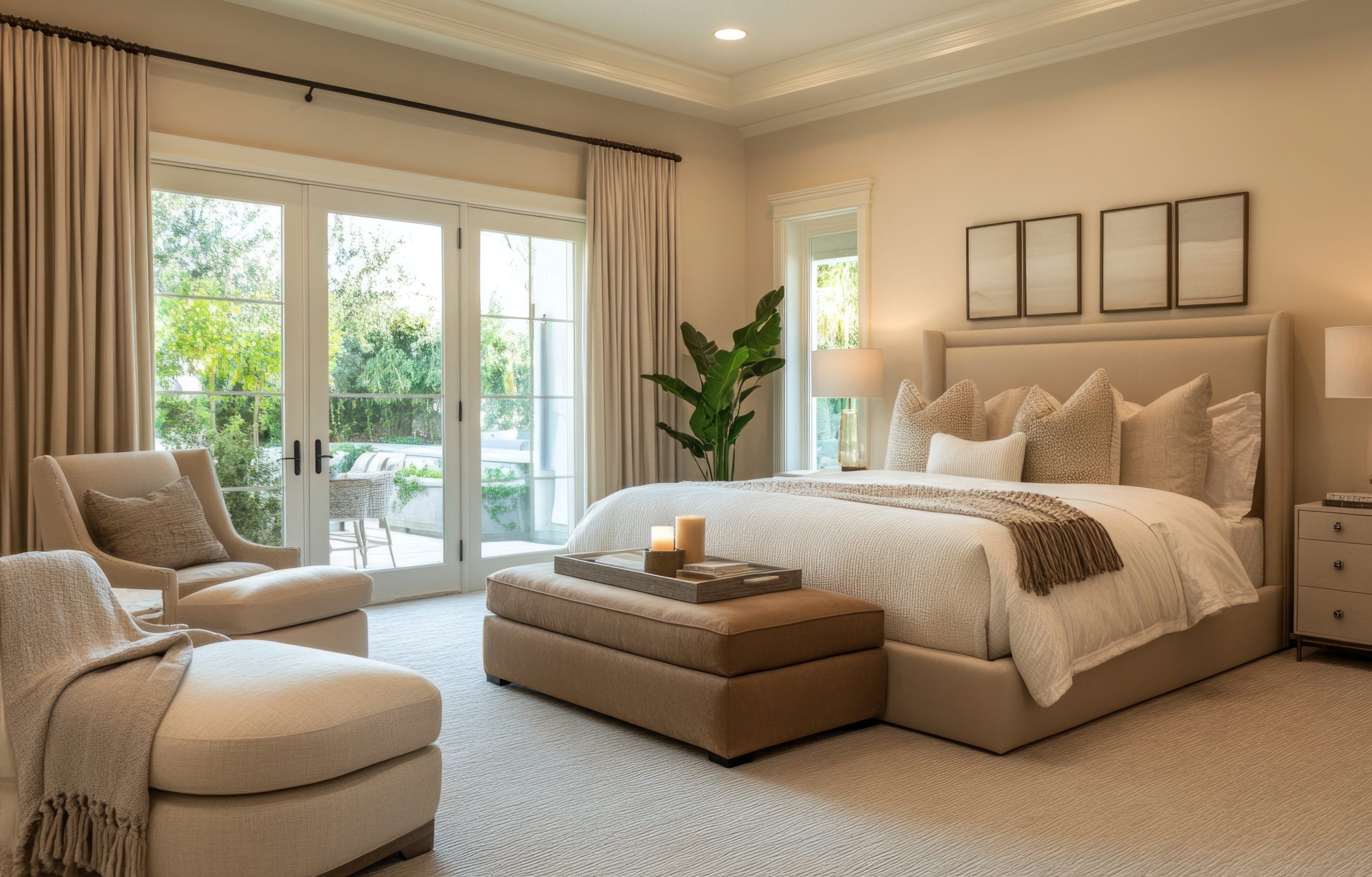
By setting up a personal Zen corner, you’re giving yourself a dedicated space for relaxation and self-care right in your bedroom. It’s a simple yet meaningful addition that can help you unwind and find peace amidst the hustle and bustle of daily life.
7. Use Aromatherapy for Relaxation
Aromatherapy is such a great way to boost relaxation and create a calming vibe in your bedroom. It’s one of those sensory tricks that can help reduce stress and make you feel good.
To get started, pick some essential oils that are known for their calming effects. Lavender, chamomile, and sandalwood are all fantastic choices. Lavender is especially great for promoting restful sleep and easing anxiety, while chamomile is perfect for soothing and calming the mind.
There are a few ways you can bring aromatherapy into your bedroom. An essential oil diffuser is a popular choice because it spreads a fine mist of fragrance throughout the room. You could also go for scented candles or incense to create a warm and inviting atmosphere. If you prefer something more subtle, try putting a few drops of essential oil on a cotton ball and tucking it into your pillowcase.
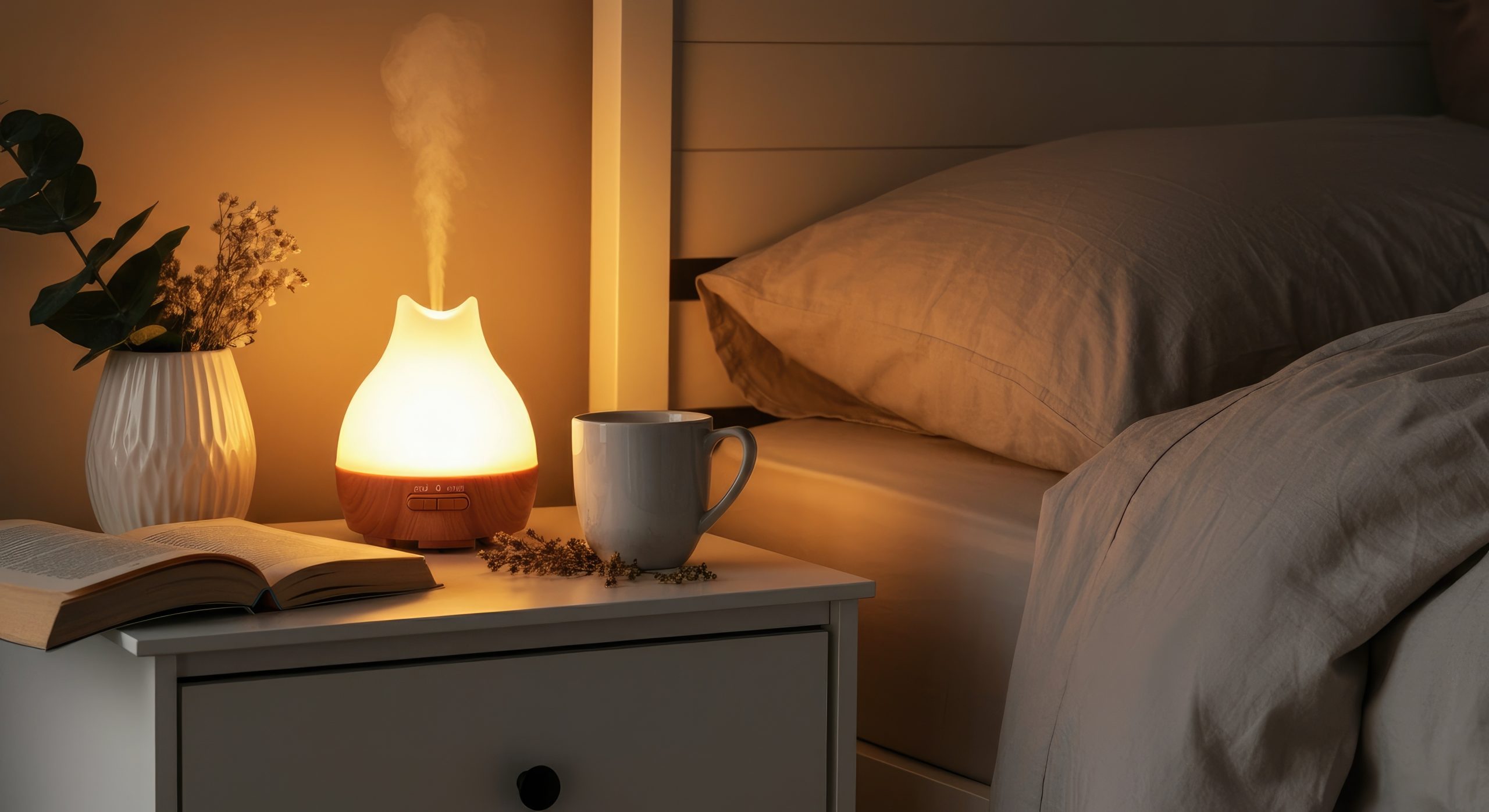
By incorporating aromatherapy, you can enhance the sensory experience in your bedroom and create a soothing environment that supports relaxation and stress relief. It’s a simple addition that can turn your space into a fragrant haven where you can truly unwind and recharge.
8. Minimise Electronic Distractions
In today’s tech-heavy world, all those electronic devices can mess with your relaxation, especially in the bedroom. Cutting down on these distractions is one of the best ways to make your space more peaceful and restful.
Take a look at the gadgets you have in your bedroom and think about which ones you really need. Ideally, your bedroom should be a tech-free zone, but if that’s not doable, try to at least cut back on the number of devices and how much you use them, especially before bed. Things like TVS, computers, and even smartphones can emit blue light that messes with your sleep cycle.
To help with this, set up a charging station outside your bedroom for all your devices. This way, you’re less tempted to check your phone or tablet late at night. If you use your phone as an alarm clock, maybe switch to a traditional alarm clock to keep your phone out of the bedroom.
If you like to read or listen to music before bed, go for non-digital options. A good book or magazine is a great way to wind down, and a small radio or a playlist on a smart speaker with a sleep timer can give you some soothing background music without the screens.
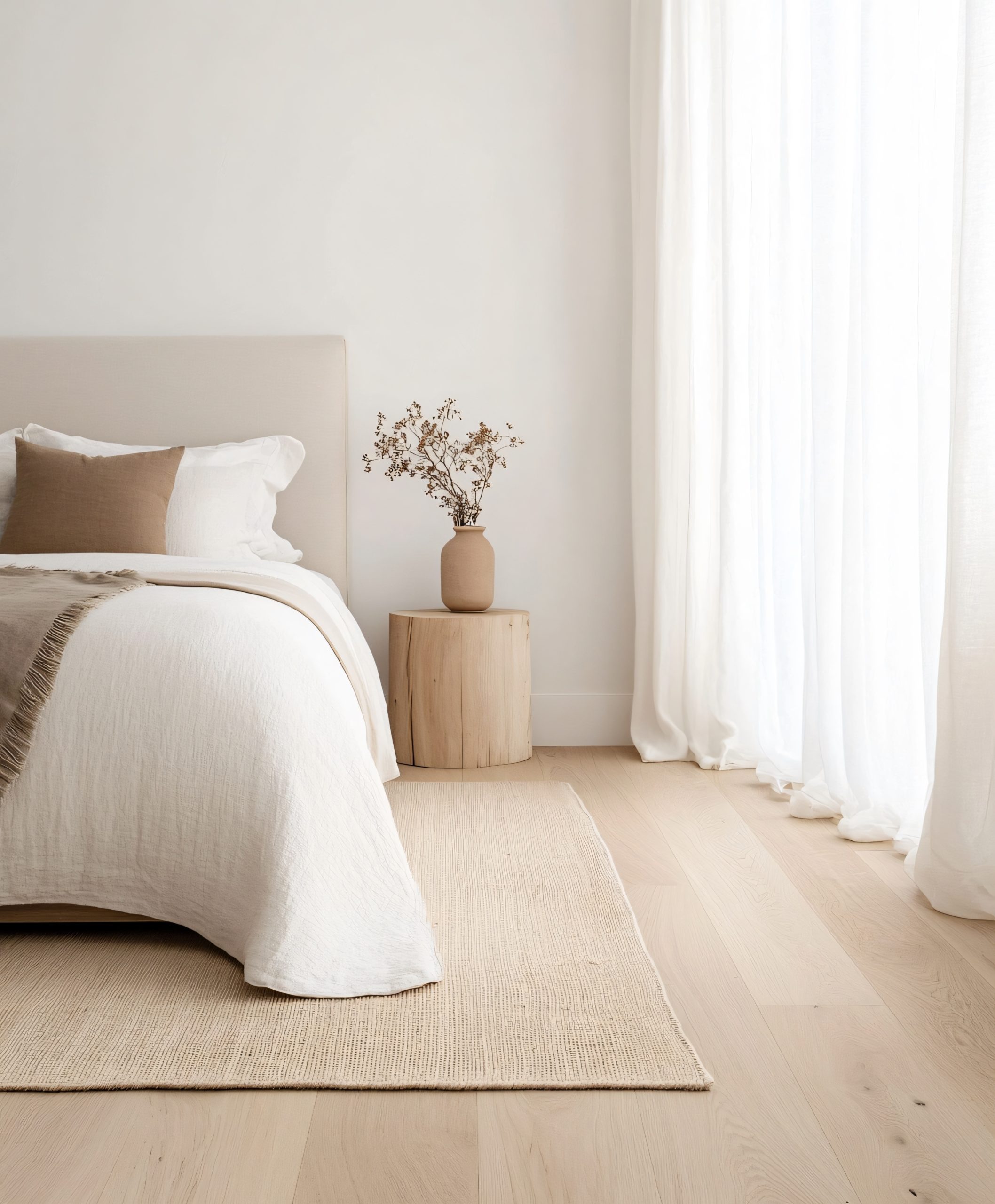
By minimising these distractions, you can create a more serene and restful bedroom environment that supports relaxation and better sleep. It’s a simple change that can help you unwind and enjoy your personal sanctuary.
9. Personalise with Meaningful Decor
Adding personal touches to your bedroom is a great way to boost its comfort and give it that warm, inviting feel. Personalising your decor is one of those heartfelt touches that can make your space reflect who you are and bring you joy.
Start by bringing in items that mean something to you or spark happy memories. Think about family photos, artwork, or souvenirs from your travels. You can display them in a way that fits with your overall decor, like a gallery wall or a curated shelf. These personal elements can be daily reminders of cherished moments and loved ones, adding to a sense of peace and contentment.
Also, think about decor that aligns with your interests and passions. If you’re into art, hang a piece that inspires you. If you love nature, maybe add a small terrarium or a nature-themed print. The key is to choose items that resonate with you and strengthen your emotional connection to the space.
Beyond personal mementos, use decor to express your style and preferences. This could mean picking a statement piece of furniture, a unique light fixture, or a bold accent colour. These elements can add character and individuality to your bedroom, making it a true reflection of who you are.
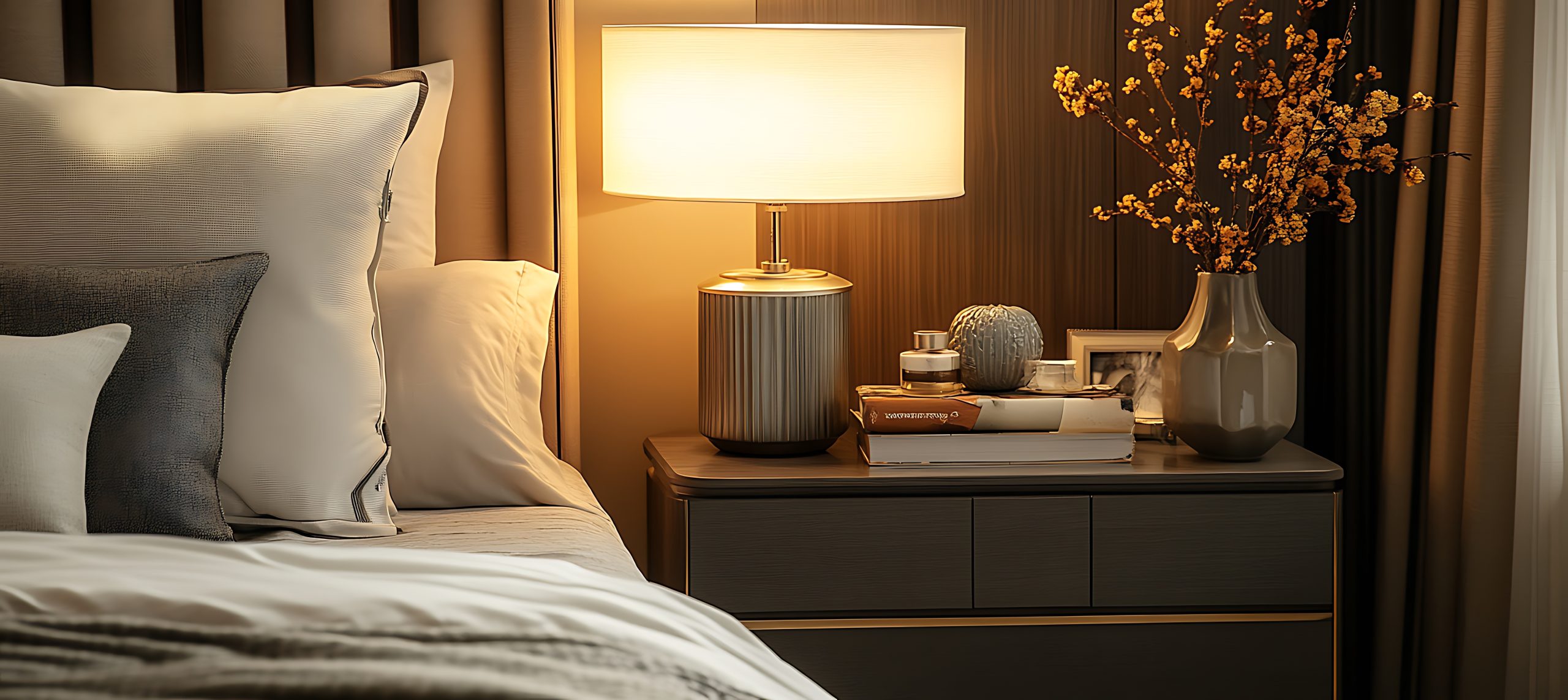
By personalising your bedroom with meaningful decor, you create a space that feels uniquely yours and fosters relaxation and happiness. This simple yet impactful approach can transform your bedroom into a comforting retreat where you can unwind and recharge.
Implementing these simple bedroom ideas for relaxation, you can turn your space into a personal sanctuary that promotes peace and well-being. From decluttering and choosing soothing colours to optimising lighting and incorporating natural elements, each step helps create a more serene and inviting atmosphere.

by Kesaa Interiors | DESIGN GUIDES, Living Spaces, ROOMS
Looking for tips to take your cozy living room decor in your small apartment to the next level? You have come to the right place!
Living in a small apartment doesn’t mean you have to sacrifice style or comfort. In fact, creating cozy living room decor in a small apartment can be a really fun challenge! It’s all about making smart choices and getting creative with your space.
I’m excited to share some of my favorite tips and tricks for maximizing every square inch and creating a stylish and inviting living room, perfect for those of us dealing with limited square footage. Get ready to transform your small space into a cozy haven!
The Best Cozy Living Room Decor for Small Apartment!
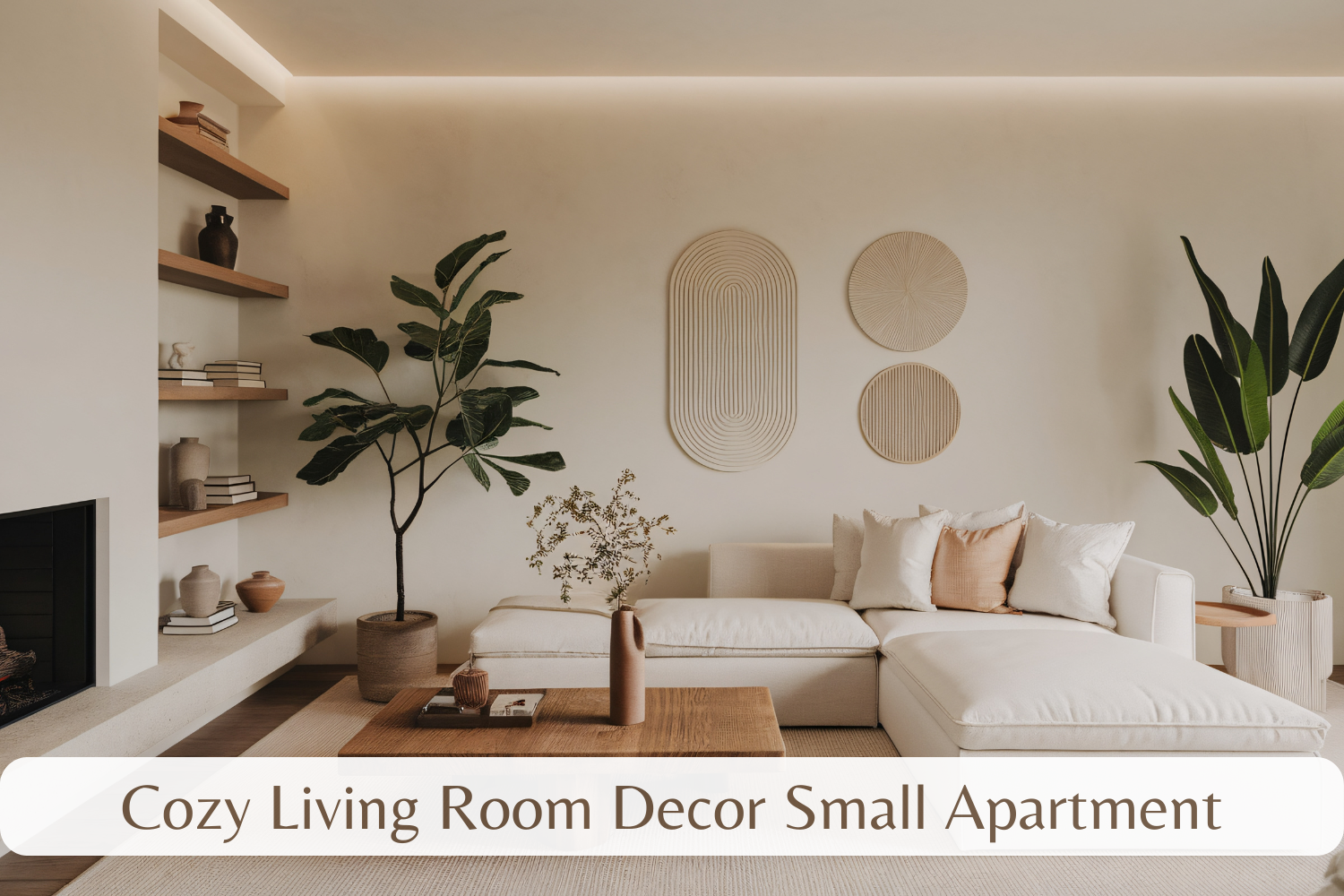
Furniture that Fits Your Footprint
When it comes to cozy living room decor for a small apartment, choosing the right furniture is absolutely crucial. It’s easy to get carried away with a beautiful sofa or a comfy armchair, but if it’s too big for your space, it’s going to make your living room feel cramped and cluttered. Here’s how to choose furniture that will make your small living room feel bigger and more inviting:
-
Scale is Key: Before you even start looking at furniture, grab a measuring tape and get to work! Seriously, measuring your living room is the first and most important step in creating cozy living room decor for a small apartment. This will help you determine the maximum size of furniture you can comfortably fit without overwhelming the space. Think apartment-sized sofas, loveseats instead of large sectionals, and slimline chairs. For example, a standard sofa might be 84 inches long, but a loveseat is typically around 60 inches, saving you valuable floor space. Choosing appropriately scaled furniture is the foundation for successful cozy living room decor in a small space.
-
Multi-Functional Marvels: In a small apartment, every piece of furniture needs to pull its weight. Look for pieces that serve double duty, like a sofa bed with built-in storage underneath for bedding. This is a game-changer for overnight guests! An ottoman with a hidden compartment for blankets and pillows is another great way to sneak in extra storage without sacrificing style. A coffee table that lifts to become a dining table is another fantastic option for maximizing functionality in a small apartment living room, especially if you don’t have a separate dining area. Think creatively about how each piece can serve multiple purposes.
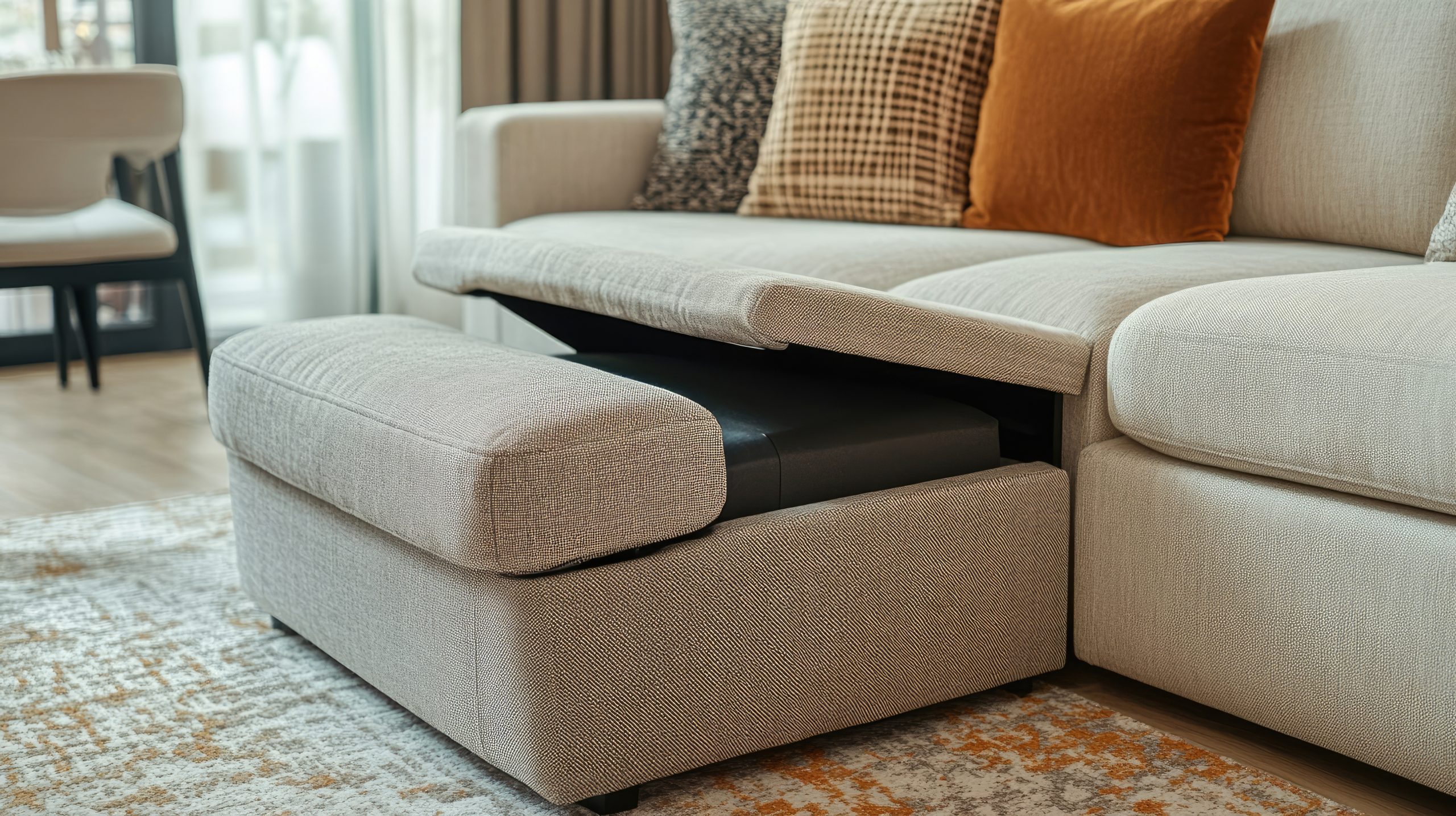
-
Measure Twice, Buy Once: I can’t stress this enough – measure your space before you buy any furniture! It’s so much easier to measure than to try and squeeze a too-large sofa through your apartment door, trust me! Creating a simple floor plan sketch can also be incredibly helpful when planning your living room decor. You can even use online tools or apps to create a virtual floor plan and experiment with different furniture arrangements.
-
Leggy Looks: Furniture with legs creates a sense of airiness and visual space, which is essential in a small living room. The light can flow underneath the furniture, making the room feel less cluttered and more open. When you’re aiming for cozy living room perfection, consider opting for sofas, armchairs, and coffee tables with raised legs. Even a small elevation can make a big difference in how spacious your living room feels. Think sleek, tapered legs for a modern look, or ornately carved legs for a more traditional feel.
- Vertical Space is Your Best Friend: Don’t forget to look up! In a small living room, vertical space is prime real estate. Tall, narrow bookshelves or wall-mounted units are a great way to add storage and display decorative items without taking up valuable floor space. Styling these shelves with a mix of books, plants, and personal items can really elevate your living room decor. Consider using wall-mounted shelves to display artwork or create a mini indoor herb garden – it’s a great way to add personality and functionality to your space.
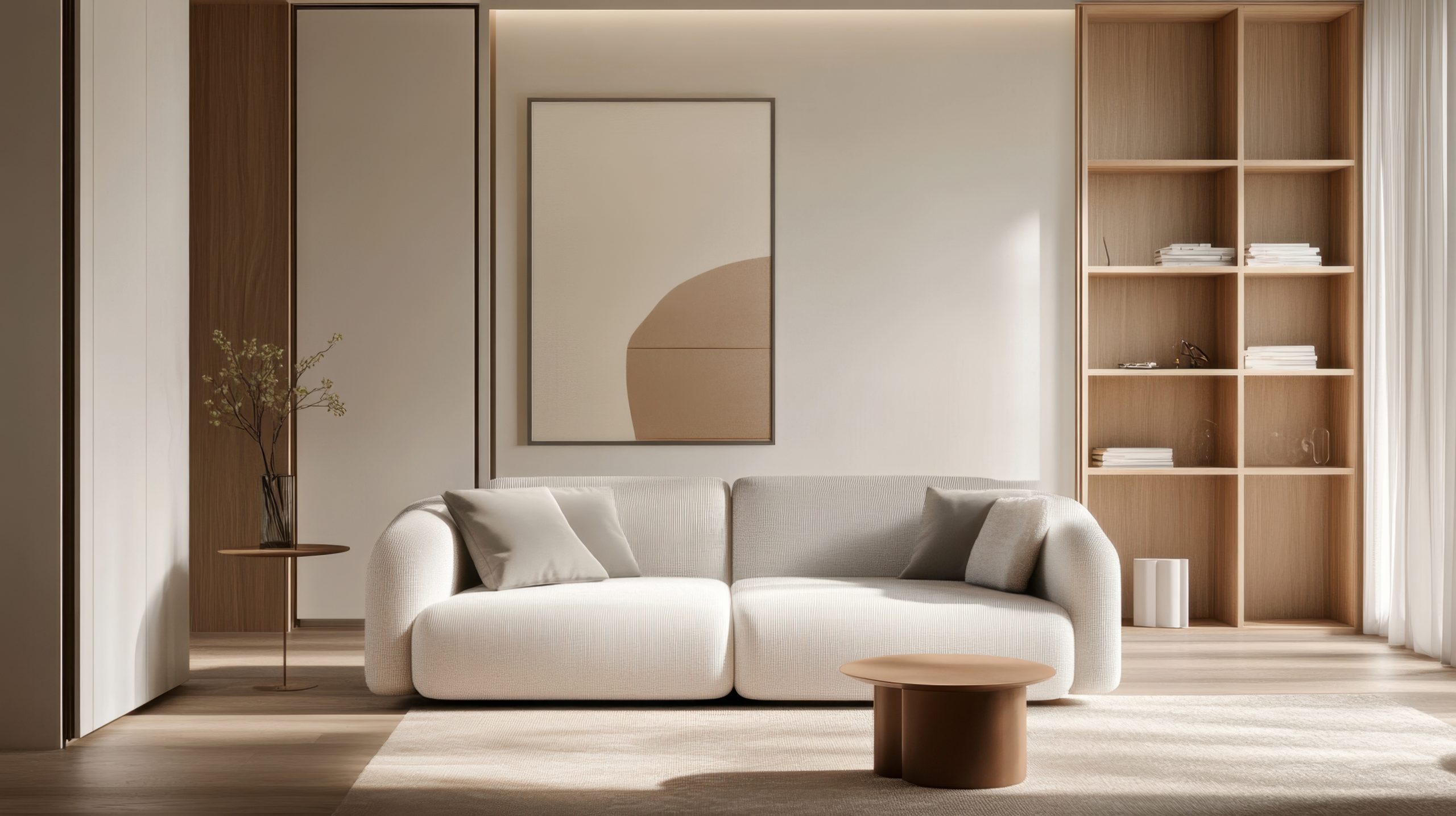
-
Clear the Clutter: Less is definitely more in a small space. Be mindful of how much furniture you bring into your living room. Avoid overcrowding the space, and focus on a few key pieces that are both functional and stylish. A minimalist approach can work wonders for creating a cozy living room in a small apartment. Regularly decluttering and getting rid of items you no longer need or use will help keep your living room feeling open and inviting. Consider incorporating stylish storage solutions, like baskets and decorative boxes, to keep clutter at bay. A clutter-free space is key to achieving a truly cozy and relaxing atmosphere.
Creating a Cozy Atmosphere with Textiles
Textiles are the secret weapon for creating a truly cozy living room, especially in a small apartment. They add warmth, texture, and personality, transforming a plain space into a welcoming haven. When considering cozy living room decor, small apartment style, think beyond just functionality – textiles offer a powerful way to enhance the ambiance and express your personal style.
-
Texture is King: In a small living room, texture is paramount. It adds depth and dimension, fooling the eye and making the space feel larger and more inviting. Think beyond smooth surfaces and incorporate a variety of tactile elements. A chunky knit throw draped over the arm of your sofa instantly adds a sense of warmth and comfort. Plush velvet cushions invite you to sink in and relax. A soft, shaggy rug underfoot creates a luxurious and inviting feel. Don’t be afraid to mix and match different textures – a nubby wool throw paired with a smooth velvet cushion creates a dynamic and interesting look. Consider the seasons too – lighter, breathable linens for summer and heavier wools and faux furs for winter can enhance the cozy factor.
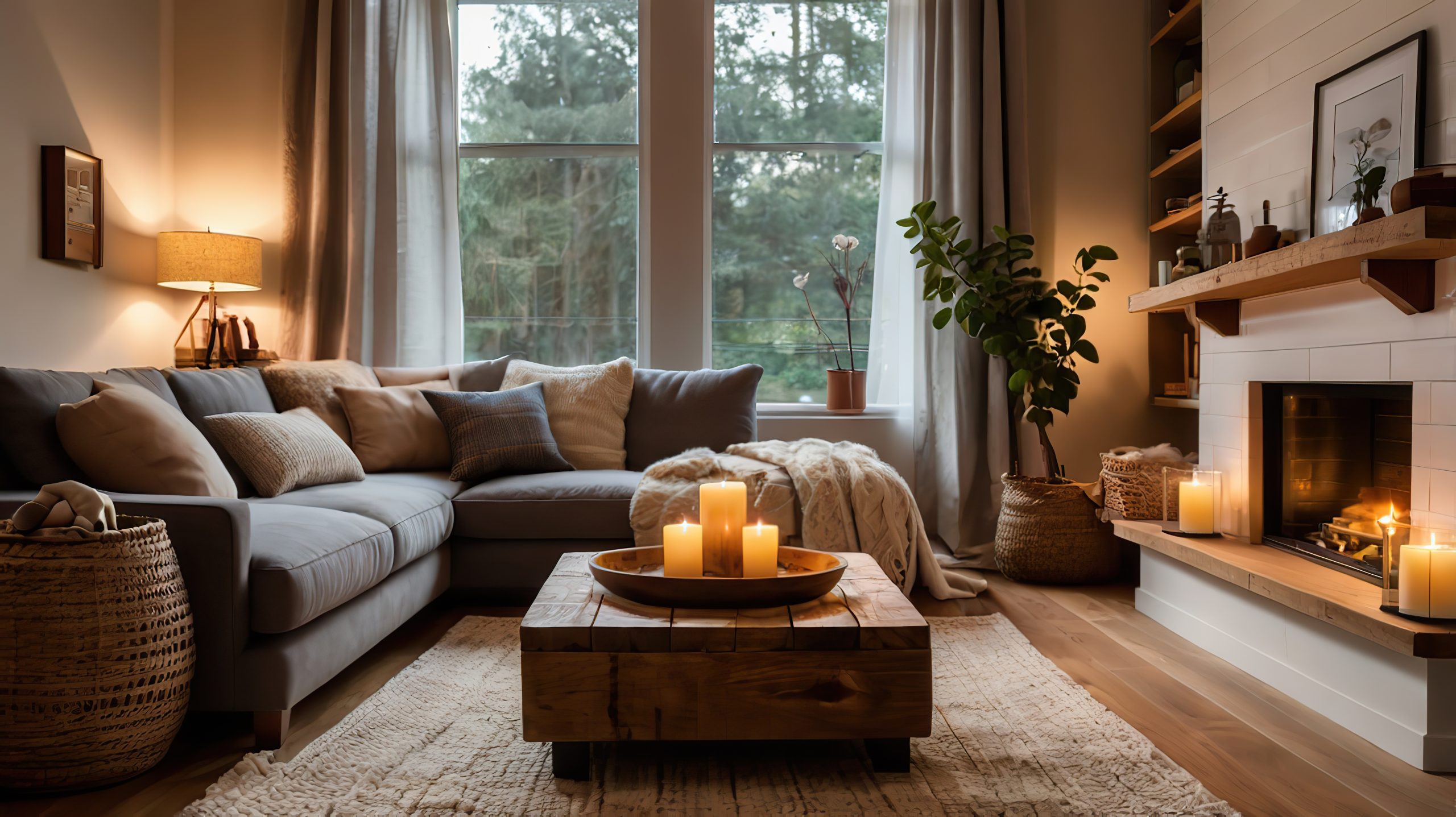
-
Natural Beauty: Natural materials like wool, cotton, and linen are not only soft and comfortable against the skin, but they also offer inherent breathability, which is crucial in a small apartment. These materials also bring a touch of organic elegance to your living room decor. A chunky hand-knit wool throw draped over the back of your sofa adds a touch of rustic charm, while a crisp linen cushion introduces a sense of understated sophistication. Look for natural fiber rugs like jute or sisal to add texture and warmth underfoot.
-
Color Psychology: Color has a profound impact on mood and atmosphere. For a cozy living room decor in a small apartment, lean towards warm, inviting colors that create a sense of intimacy and comfort. Soft neutrals like cream, beige, and gray provide a calming backdrop, while earthy tones like terracotta, olive green, and warm brown evoke a sense of groundedness and tranquility. Rich jewel tones like emerald green, sapphire blue, or ruby red can add a touch of opulence and warmth without overwhelming the space. Consider using a color palette of two or three complementary colors to create a cohesive and harmonious look.
-
Layering for Depth: Layering textiles is a designer’s trick for adding visual interest and depth to a small living room. Start with a base layer, like a rug, and then build upon it with throws, cushions, and even curtains. Don’t be afraid to mix and match different patterns and textures – a geometric patterned rug paired with a solid-colored throw and a textured cushion creates a dynamic and inviting look. Layering also allows you to easily change the look and feel of your living room by swapping out different textiles with the seasons or your changing tastes.
-
Rugs Define the Space: In a small apartment, a rug is essential for visually defining the living area and adding warmth underfoot. Choose a rug that is large enough to anchor the main furniture pieces, such as the sofa and armchairs, but not so large that it overwhelms the room. Ideally, the front legs of your furniture should rest on the rug, creating a sense of connection and cohesion. A rug can also introduce a pop of color or pattern to your cozy small living room decor, tying the space together and adding personality.
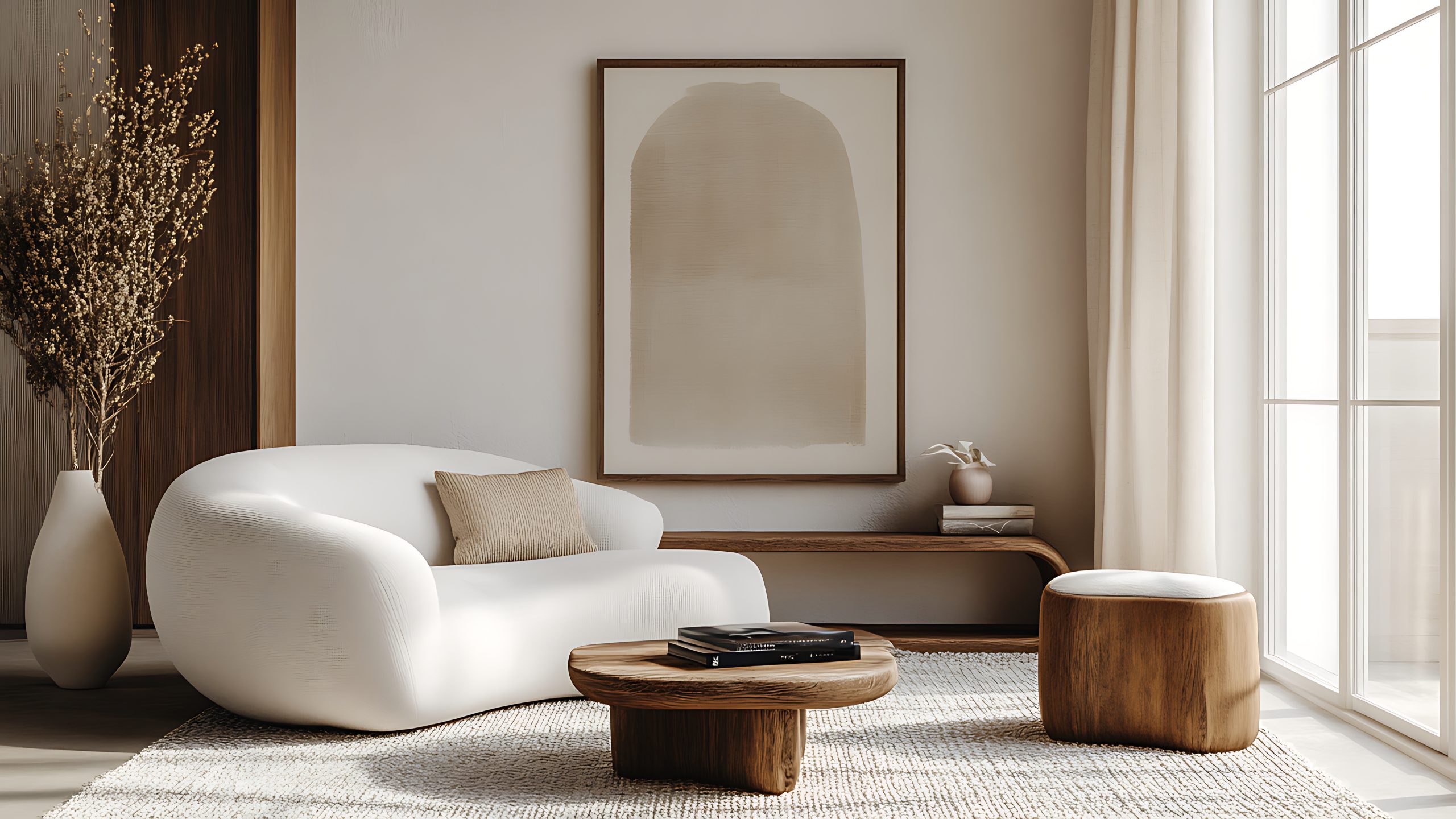
Lighting Up Your Small Space
Lighting is a critical element in any cozy living room decor for a small apartment. It sets the mood, enhances functionality, and can even make the space feel larger. Here’s how to light up your small living room for maximum coziness:
-
Natural Light is Your Friend: Natural light is a precious commodity in a small apartment. Maximize it by keeping window treatments light and airy. Sheer curtains or blinds allow natural light to filter through while still providing privacy. Avoid heavy drapes or blinds that block light and make the space feel smaller. Consider using mirrors strategically to reflect natural light deeper into the room.
-
Layered Lighting Magic: Creating a warm and inviting atmosphere relies on layered lighting. Combine ambient lighting (general overhead lighting), task lighting (for reading or working), and accent lighting (to highlight specific features) for a well-lit and functional space. A floor lamp next to your reading chair provides focused light for reading, while a table lamp on a side table creates a soft, ambient glow. Pendant lights over the coffee table add a touch of style and provide focused light for conversations or games. Dimmer switches allow you to adjust the brightness of your lighting to suit different moods and activities.
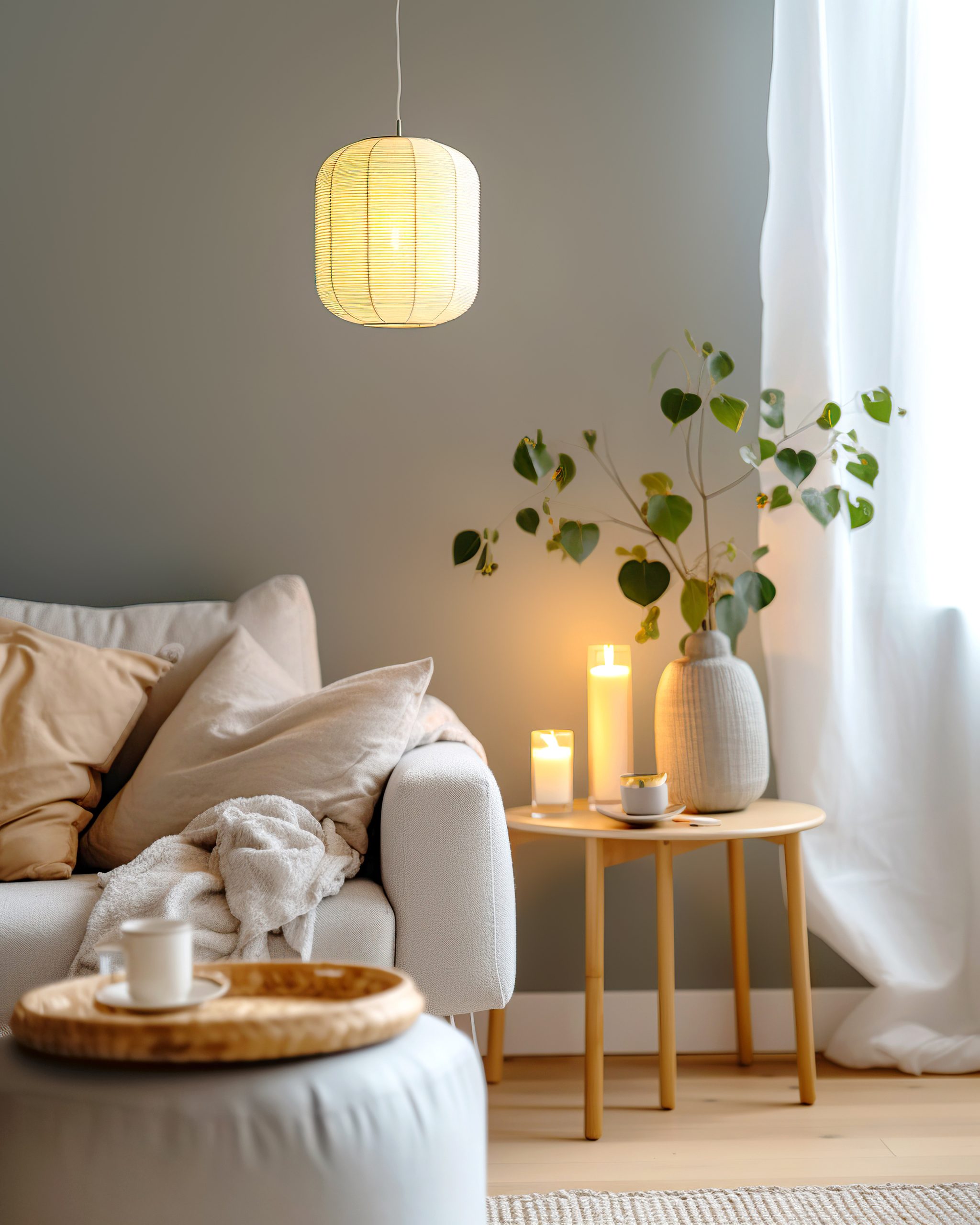
-
Light and Bright Color Schemes: Light and bright wall colors can significantly impact how spacious your small living room feels. Opt for shades of white, cream, or light gray to create a neutral backdrop that reflects light and makes the space feel open and airy. You can then add pops of color with your textiles and accessories. A light and airy color scheme is essential for successful cozy living room decor in a small apartment.
-
Statement Lighting Fixtures: A statement light fixture can be the jewelry of your living room, adding personality and style without taking up valuable floor space. Choose a fixture that complements your overall decor and provides adequate lighting for the space. A unique pendant light over the coffee table or a stylish chandelier can become a focal point and elevate the entire room. Consider the scale of the fixture – a large, oversized fixture can overwhelm a small space, while a smaller, more delicate fixture can add a touch of elegance without feeling overpowering.
- Mirror, Mirror on the Wall: Mirrors are a small space decorator’s best friend. They reflect light, creating the illusion of more space and making your living room feel larger and brighter. A large statement mirror above the sofa can visually double the size of the room, while a gallery wall of smaller mirrors adds a touch of eclectic style and reflects light from multiple angles. Consider placing a mirror opposite a window to maximize natural light reflection.
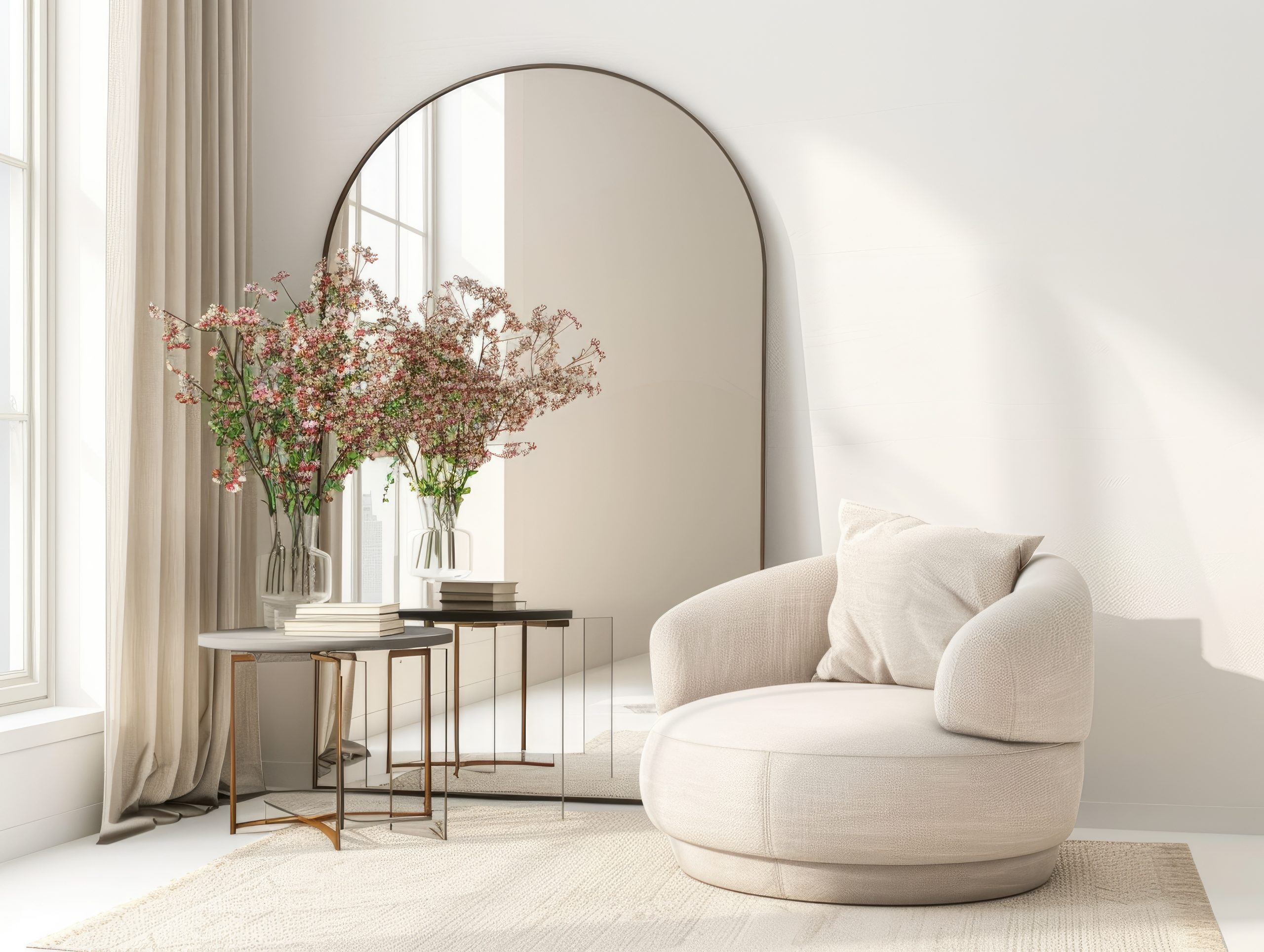
Decorative Touches for a Stylish Space
Decorative touches are what truly personalize your space and make it feel like home. In a small apartment, it’s important to be selective and intentional with your decor choices to avoid cluttering the space. Here’s how to add style and personality to your cozy living room decor:
-
Curated Collections: Resist the urge to fill every surface with decorative objects. Instead, choose a few carefully curated pieces that you truly love and that reflect your personal style. This could include a collection of vintage books, a grouping of framed family photos, a few treasured travel souvenirs, or a small display of handcrafted pottery. Grouping similar items together creates a more impactful visual statement than scattering individual items around the room. Consider using trays or decorative bowls to display smaller items and keep surfaces looking organized.
-
Focal Point Focus: Every living room needs a focal point – a visual anchor that draws the eye and gives the space a sense of purpose. In a small living room, the focal point can be a fireplace, a piece of statement art, a gallery wall, a large window with a beautiful view, or even a striking piece of furniture. Once you’ve identified your focal point, arrange your furniture and decor to highlight it. For example, if your focal point is a fireplace, arrange your seating area to face it.
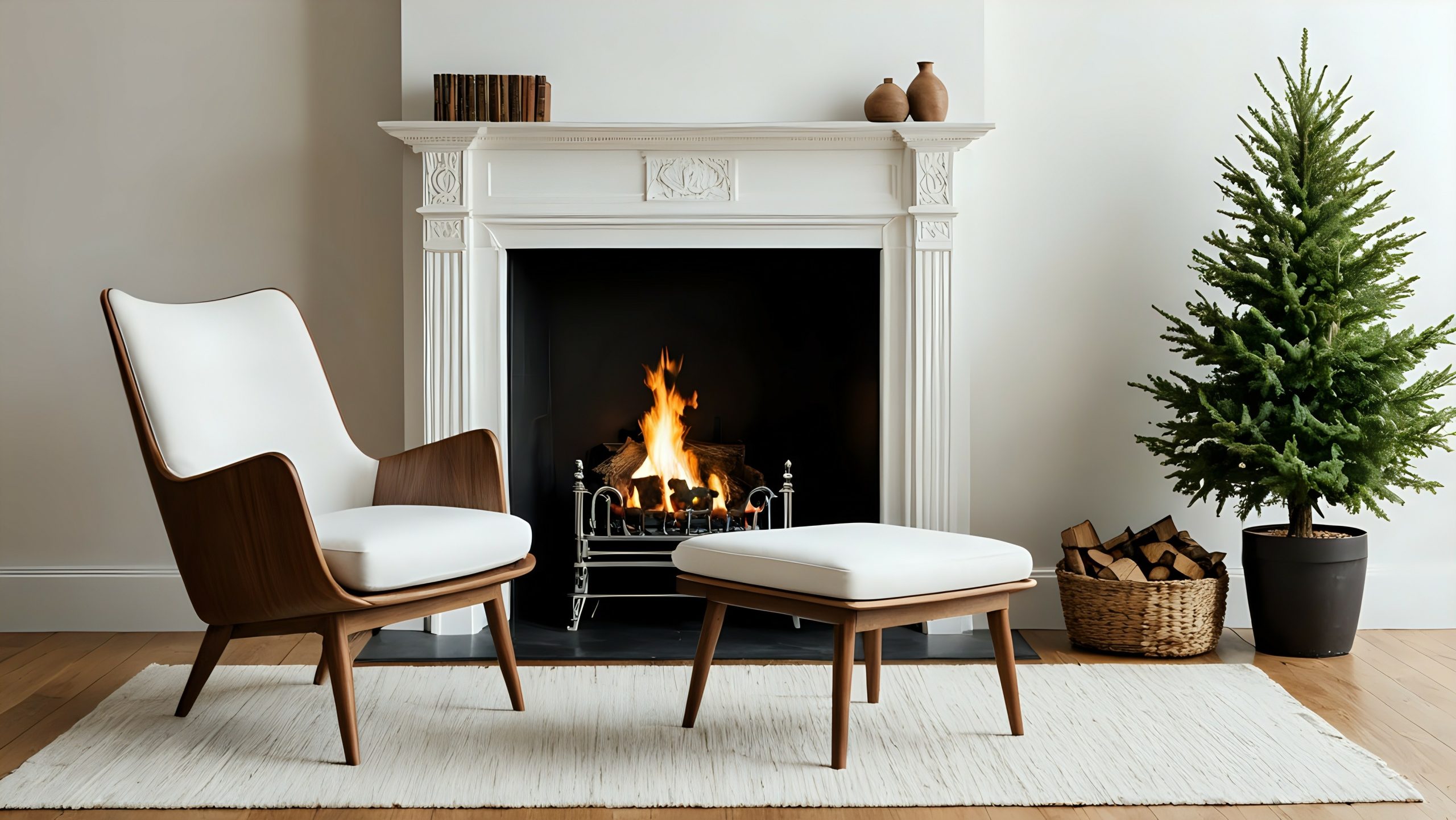
-
Decluttering is Key: Clutter is the enemy of coziness, especially in a small apartment. Regularly declutter your living room, getting rid of anything you no longer need, use, or love. A clutter-free space feels more open, airy, and inviting. Invest in stylish storage solutions, such as baskets, decorative boxes, and ottomans with hidden storage, to keep clutter contained and out of sight. Make decluttering a regular habit to maintain a sense of calm and order in your living room.
-
Greenery Brings Life: Plants add a touch of life and vibrancy to any space, and they’re especially beneficial in a small living room. They can help to purify the air, improve indoor air quality, and create a more calming and inviting atmosphere. Choose low-maintenance plants that thrive in indoor environments, such as snake plants, pothos, or spider plants. Place plants strategically around the room to add pops of color and texture. A tall, leafy plant in a corner can visually expand the space, while a small succulent on a coffee table adds a touch of natural beauty.
-
Personal Touches: The most important decorative touches are the ones that reflect your personality and make your space feel like home. Don’t be afraid to display items that have special meaning to you, whether it’s a collection of vintage postcards, a framed concert ticket, or a handmade quilt from your grandmother. These personal touches are what truly make your space unique and special.
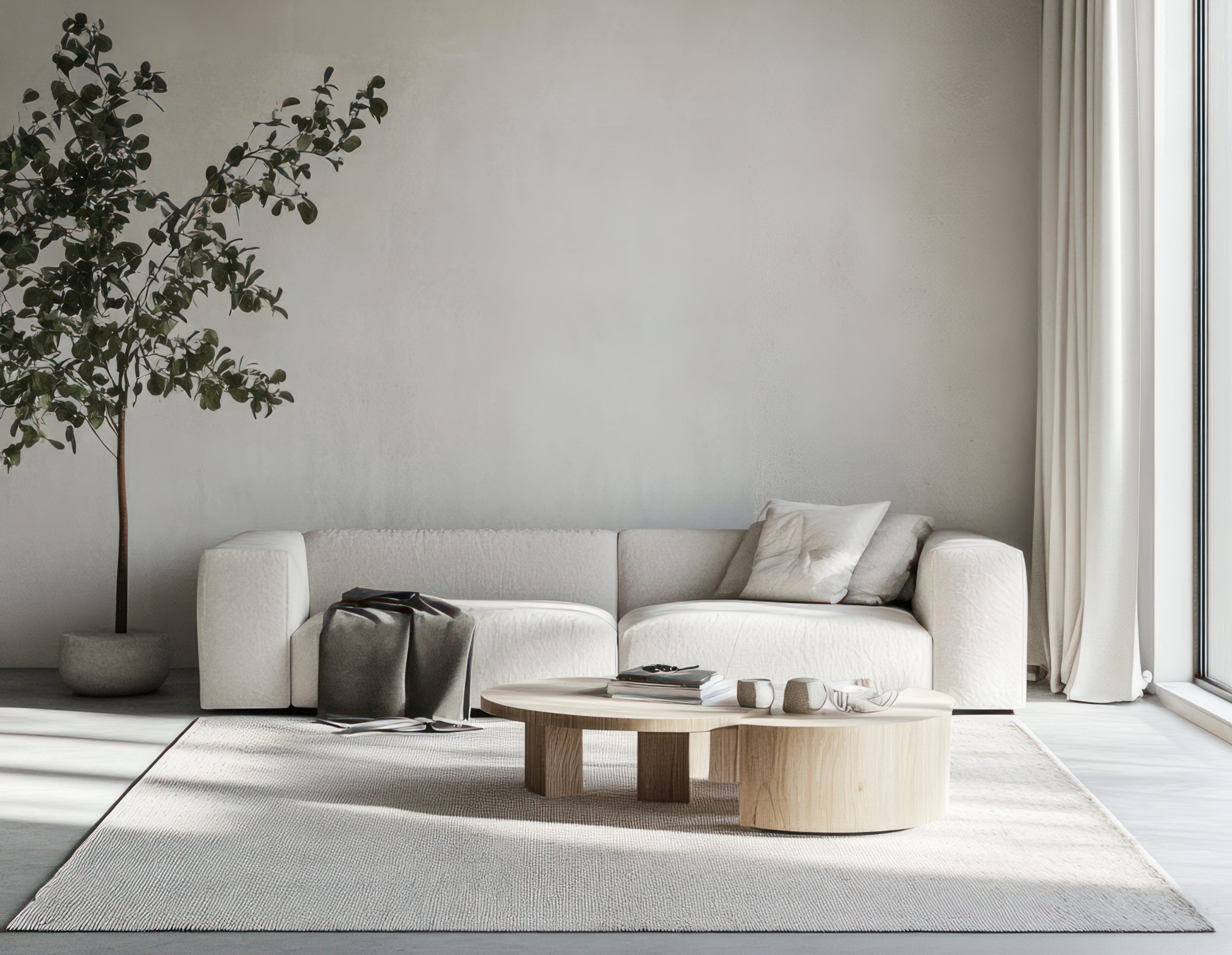
Making the Most of Vertical Space
In a small apartment, maximizing vertical space is essential for creating a functional and stylish living room. Think upwards and utilize every inch of wall space to your advantage. Here’s how to make the most of your vertical real estate:
-
Think Vertical: Train your eye to look up! Before adding furniture or decor, consider how you can utilize the vertical space in your living room. This might involve installing shelves, hanging artwork, or using tall furniture to draw the eye upwards and create the illusion of height.
-
Floating Shelves: Floating shelves are a versatile and stylish way to add storage and display decorative items without taking up valuable floor space. Install them above the sofa, next to the TV, or in any other awkward corner. Use floating shelves to display books, plants, framed photos, or small decorative objects. Arrange items in a visually appealing way, leaving some negative space to avoid a cluttered look.
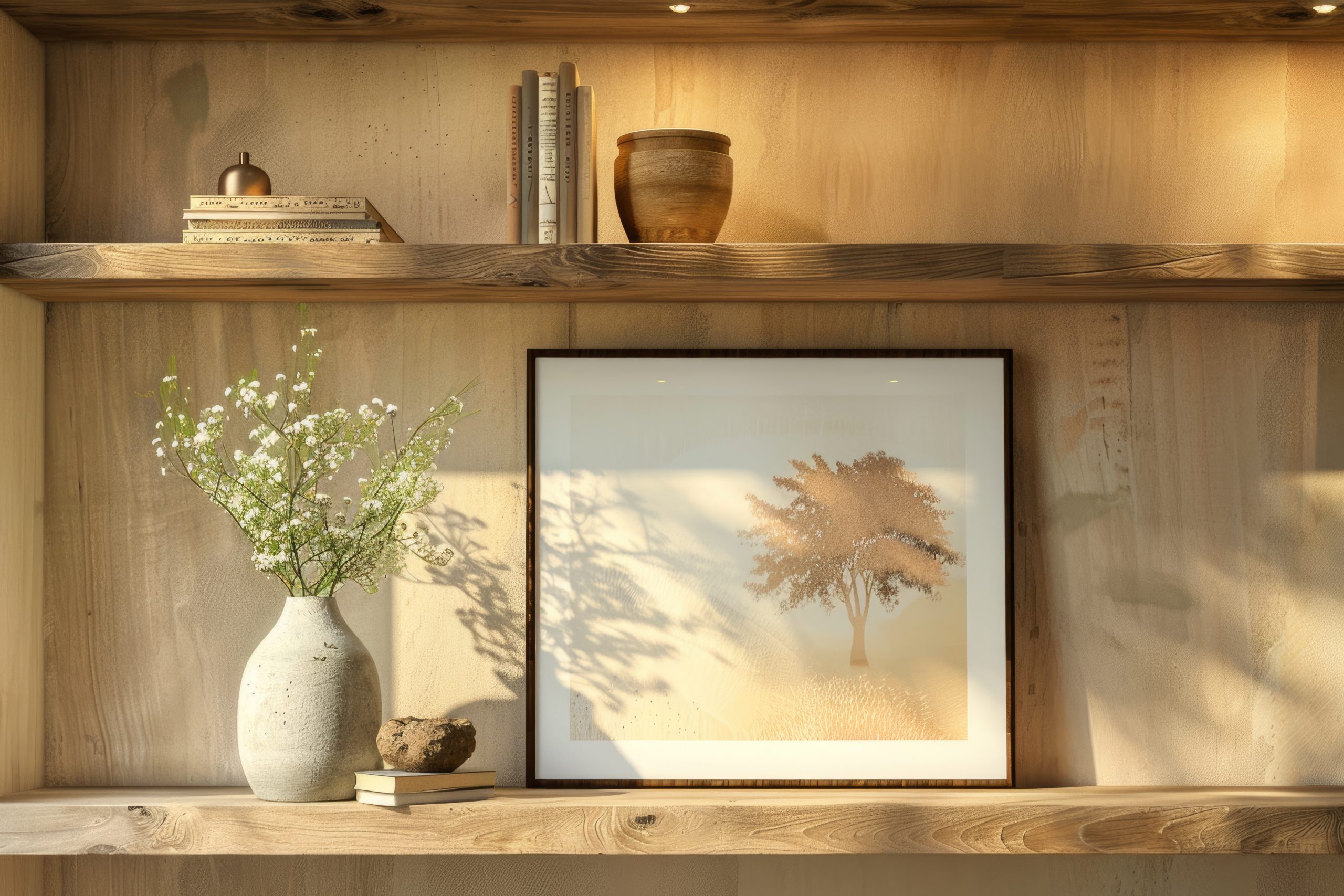
-
Bookcase Bliss: Tall, narrow bookcases are a classic way to maximize storage and display books, decorative objects, and even small plants. They can also add a touch of elegance and sophistication to your living room. Choose a bookcase that complements your existing furniture and decor. Arrange books and objects in a visually appealing way, mixing horizontal and vertical stacks to create visual interest.
-
Wall-Mounted Magic: Explore other wall-mounted options beyond shelves and bookcases. Hanging planters can add a touch of greenery without taking up floor space. Wall-mounted sconces provide ambient lighting and free up valuable surface area on tables and shelves. Hanging artwork or a large mirror can create a focal point and add personality to your space. Consider mounting your TV on the wall to also free up space on a media console.
-
Vertical Stripes: Incorporating vertical stripes, whether in wallpaper, rugs, or curtains, can visually elongate the room and make your ceilings appear higher. This is a subtle but effective trick for maximizing visual space in a small living room. Choose a stripe pattern that complements your existing decor and doesn’t overwhelm the space. Vertical stripes can add a touch of classic elegance or a more modern, graphic feel, depending on the color and width of the stripes.
By following these tips and focusing on maximizing space, incorporating cozy textiles, layering lighting, adding personal touches, and utilizing vertical space, you can transform your small apartment living room into a stylish and inviting sanctuary. Remember, cozy living room decor for a small apartment is all about creating a space that feels comfortable, personal, and perfectly suited to your needs and aesthetic.























































































